Waste Management Programme
Introduction
Consumerism brought with it a garbage problem to Malana and the locals had no solution to prevent it. They never used dustbins because there was no place to dump this waste except in the outskirts. They also tried throwing the garbage in the Malana nallah, but, it only made the stream more polluted.
Soon, they started burning the garbage. This was better for them as it only left ash behind. But, this was no solution. Unlike any other settlement in the Parvati valley, garbage had accumulated in Malana to such a degree that it started affecting the health of the locals. Hence, we decided to start a waste management programme in this village.
We faced several challenges during this campaign (from May to June 2018). Ultimately, they grew enough in number to paralyze it within a month. Although it was a complete failure, we succeded partially. In the process there were great learnings. This article is dedicated to our attempt at installing a waste management system in Malana.
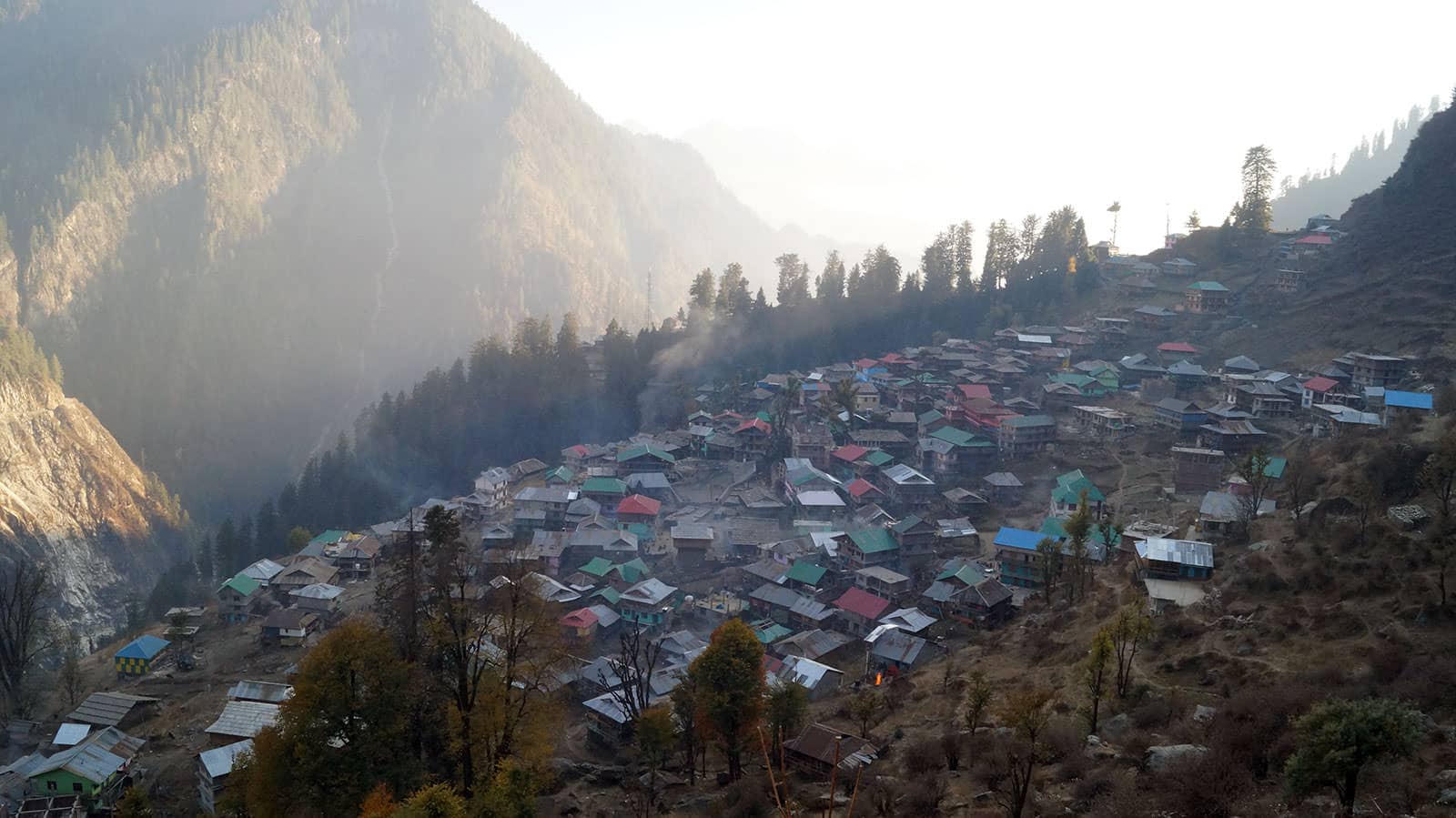
Malana Village
Vision
A clean and healthy Malana, which has systems in place to ensure that every villager disposes his/ her wastes correctly and feels a sense of civic responsibility and pride regarding cleanliness.
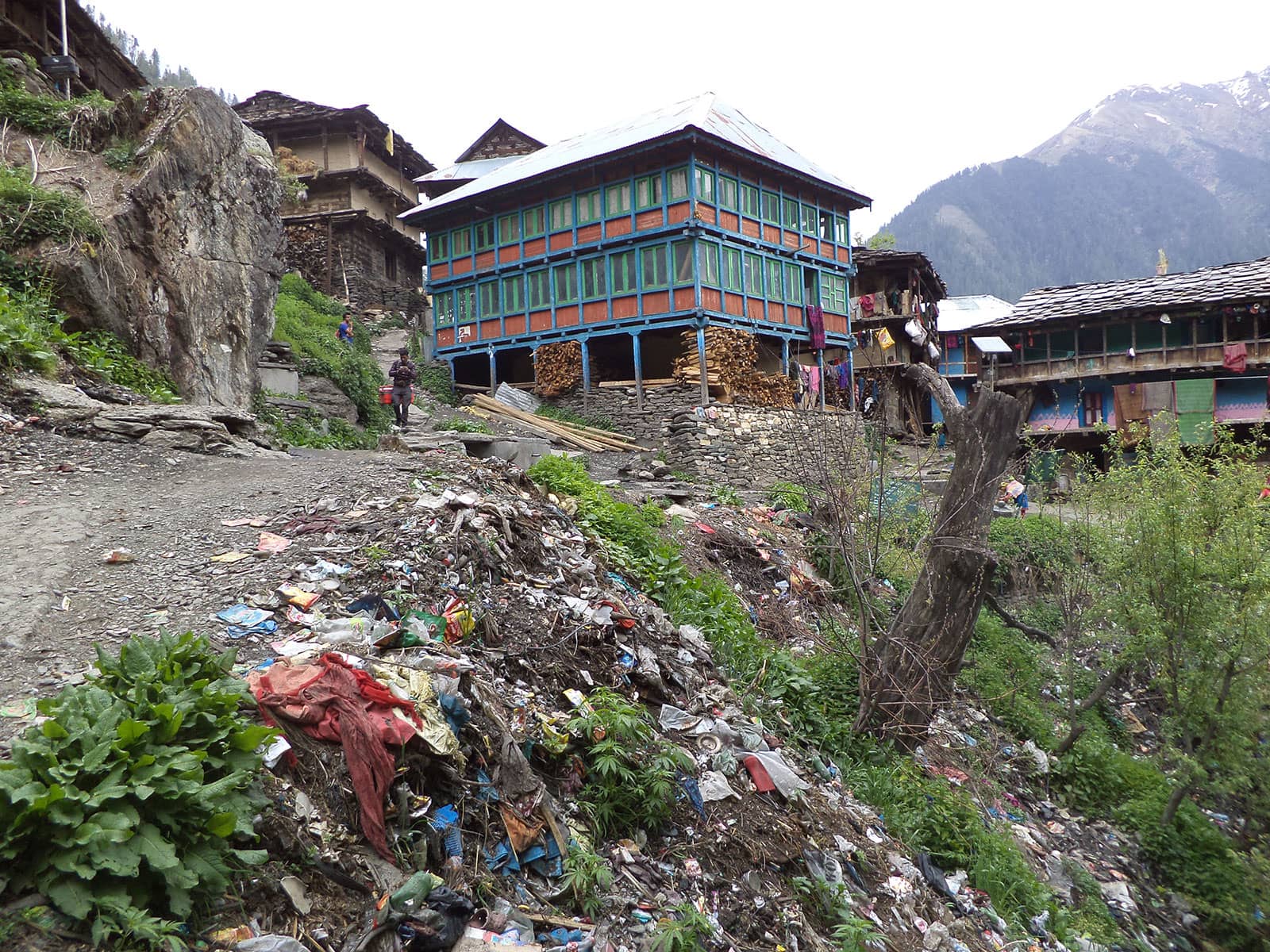
Garbage dumped in a valley in the outskirts of Malana (May, 2015)
Mission
To clean existing garbage in Malana as part of periodic clean-ups
With the help of volunteers and green workers, the village were to be cleaned before the door to door waste collection service were started. This was also to show how clean the village could potentially be.
To install a waste management system to keep the village clean
To manage wastes generated daily by the locals, a team of five was been set up; including two local supervisors and three green workers. Door to door waste collection were to be done weekly, dry waste to be segregated and then contained in store areas. Later, a part of the waste were to be sold to scrap dealers and the rest sent to a nearby land fill.
Organize cleanliness awareness programs in the village for the locals
All villagers were to be made aware of proper ways of disposing garbage and segregating wastes at home before handing it over to our green workers.
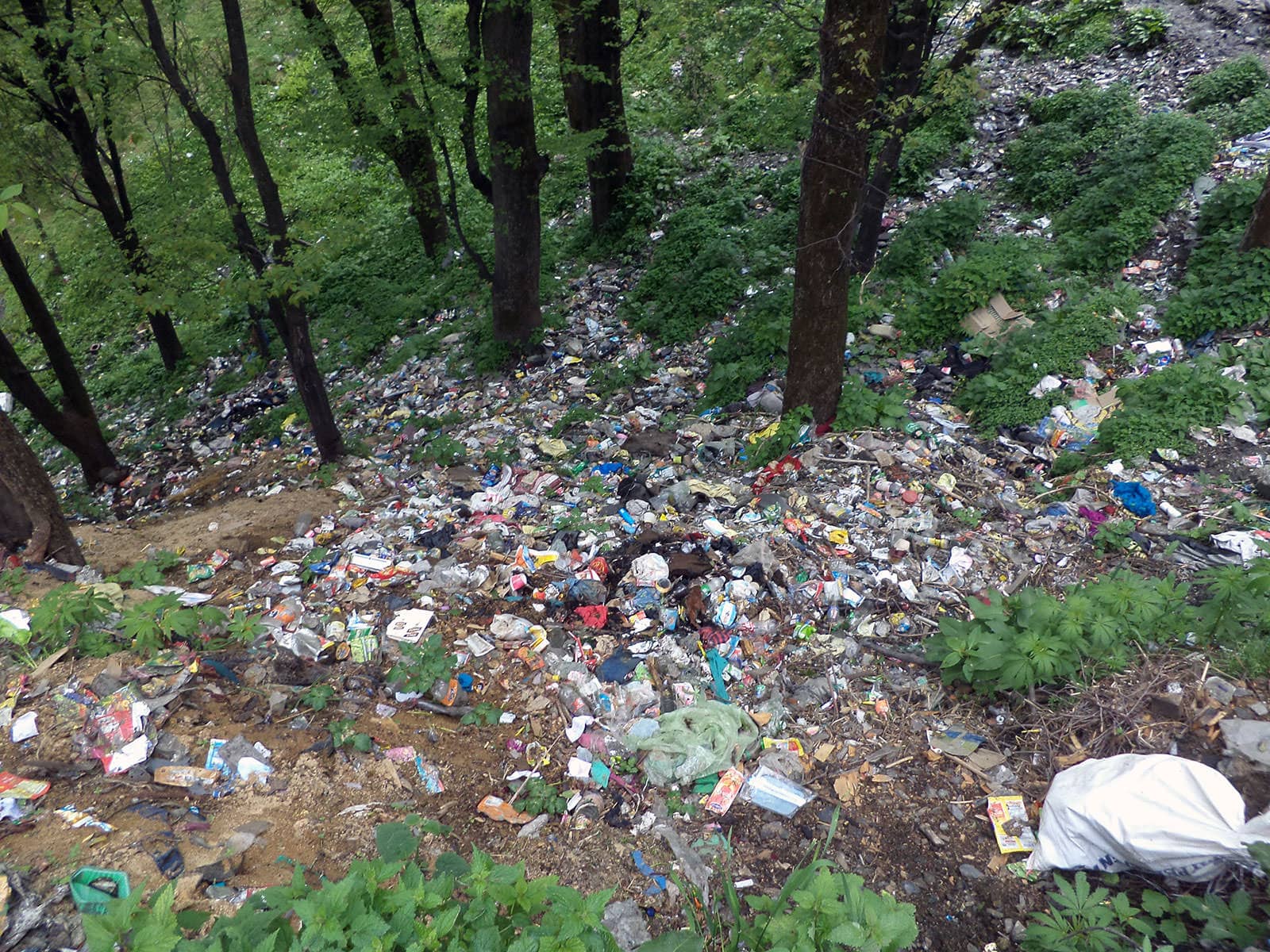
Garbage dumped in a valley in the outskirts of Malana (June, 2018)
Plan
Weekly waste collection at establishments
Each household were to be provided with two sacks- yellow and white for collecting (only dry) recyclable and non-recyclable wastes resp. The villagers were required to segregate wastes into these two categories at home.
Waste collection from households
Three green workers were employed to collect the dry wastes from households once a week & shops, tent services and guesthouses twice a week and place them in a garbage store area inside the village.
Waste storage and segregation
The wastes were to be segregated once a week by green workers into differently assigned categories such as glassware, wrappers, tetra packs, etc. These were to be stored in different sacks in the store area inside the village.
Waste transportation to the other side of the village
This was planned to store garbage outside the village making it accessible and connected by road. Once dry waste were segregated into different categories, the sacks could be transported directly across the valley into the second store (Taxi stand side: Nirang).
Dry waste storage and scrap dealer collection place
In the second store area, the sacks containing segregated dry wastes were to be stored to grow in quantity large enough for a scrap dealer to buy.
Non-recyclable wastes dumped in landfill
The dry wastes which were not bought by the scrap dealer were to be dumped in the Kullu landfill. The Municipal Corporation of Kullu had earlier permitted us to do so but later did not.
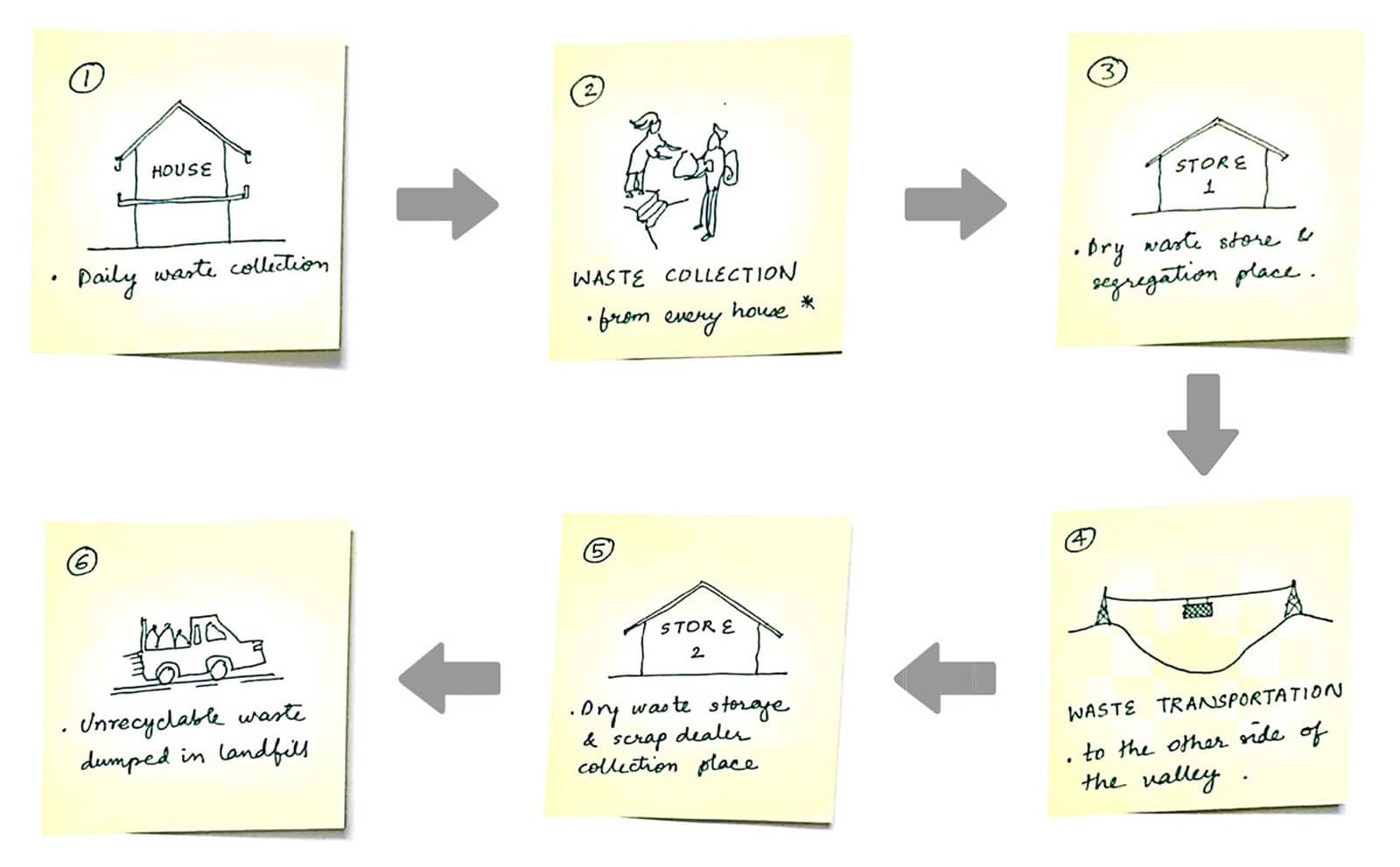
The waste-management plan (June, 2018)
Accomplishments
Formation of a waste management team
Two local supervisors from Malana: Babu Ram and Khubh Ram were chosen to maintain the waste management system, organize cleanups, manage the green workers, levy fines and collect fees. Three laborers were hired as green workers and started working from 16th June 2018 and were accommodated in the village.
Cleanups
Several cleanups were organized and executed successfully. Participation of volunteers was documented and was very positive. A weekly cleanup was planned once we started the door to door service.
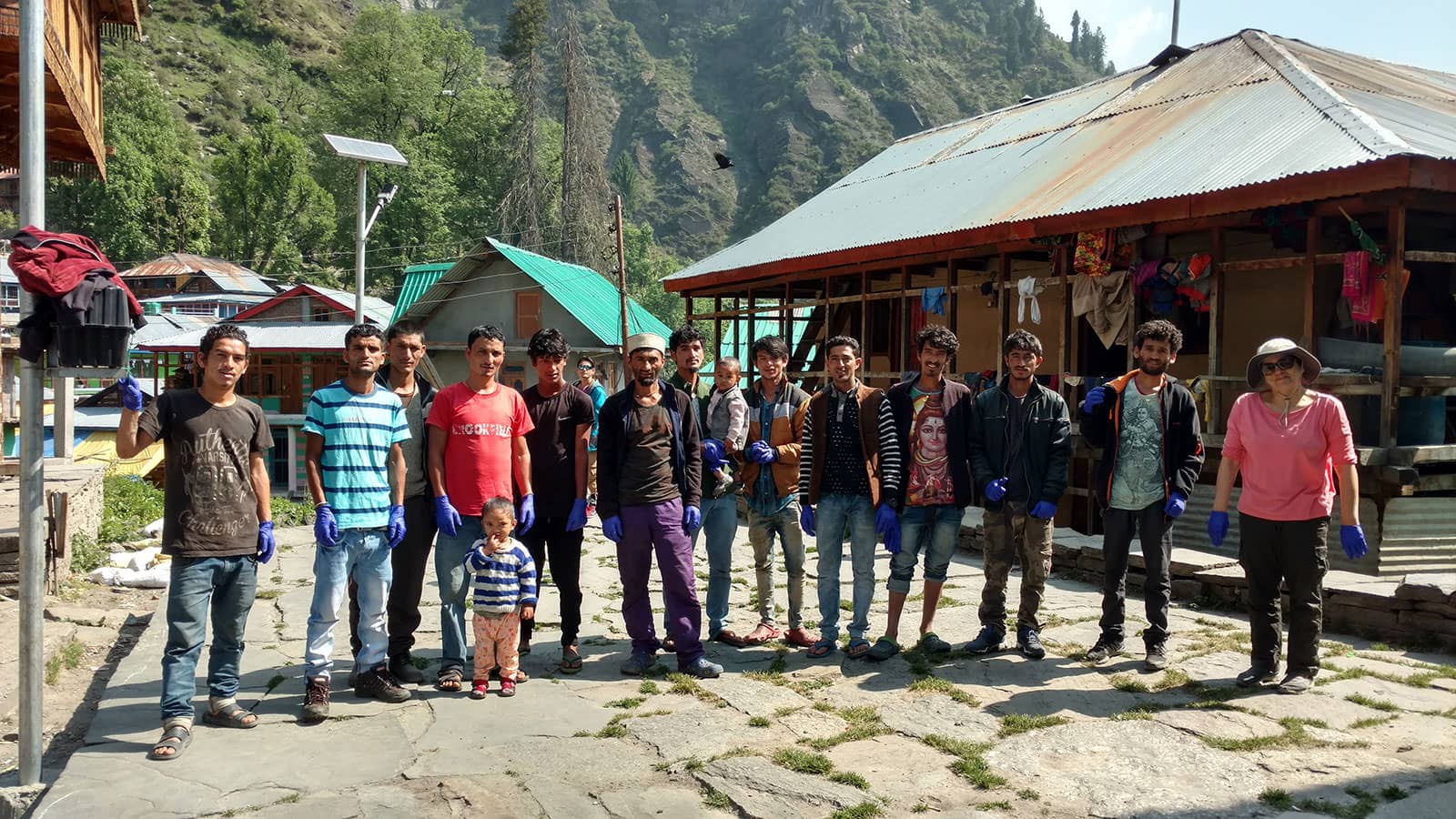
Cleanup on 1st June 2018: 29 volunteers participated to clean the main temple complex collecting around 1 ton of garbage (45 sacks) in 3 hours
Collection of garbage fee
Around 200 families paid and registered for the upkeep of the system with a compliance rate of around 95%.
Village compliance
The Temple and Gram Panchayat of Malana both accepted the proposal and identified this project as “Devta ka Kaam” or God's work which is a special status given to only a few socially benefitting activities.
Permissions granted
The Gram Panchayat authorized our team with rights to collect fees and levy fines appropriately. It also offered complete support and assistance in case of difficulties. We had asked for the Municipal Corporation for landfill dumping permissions in the Kullu dump yard. But this permission was not granted.
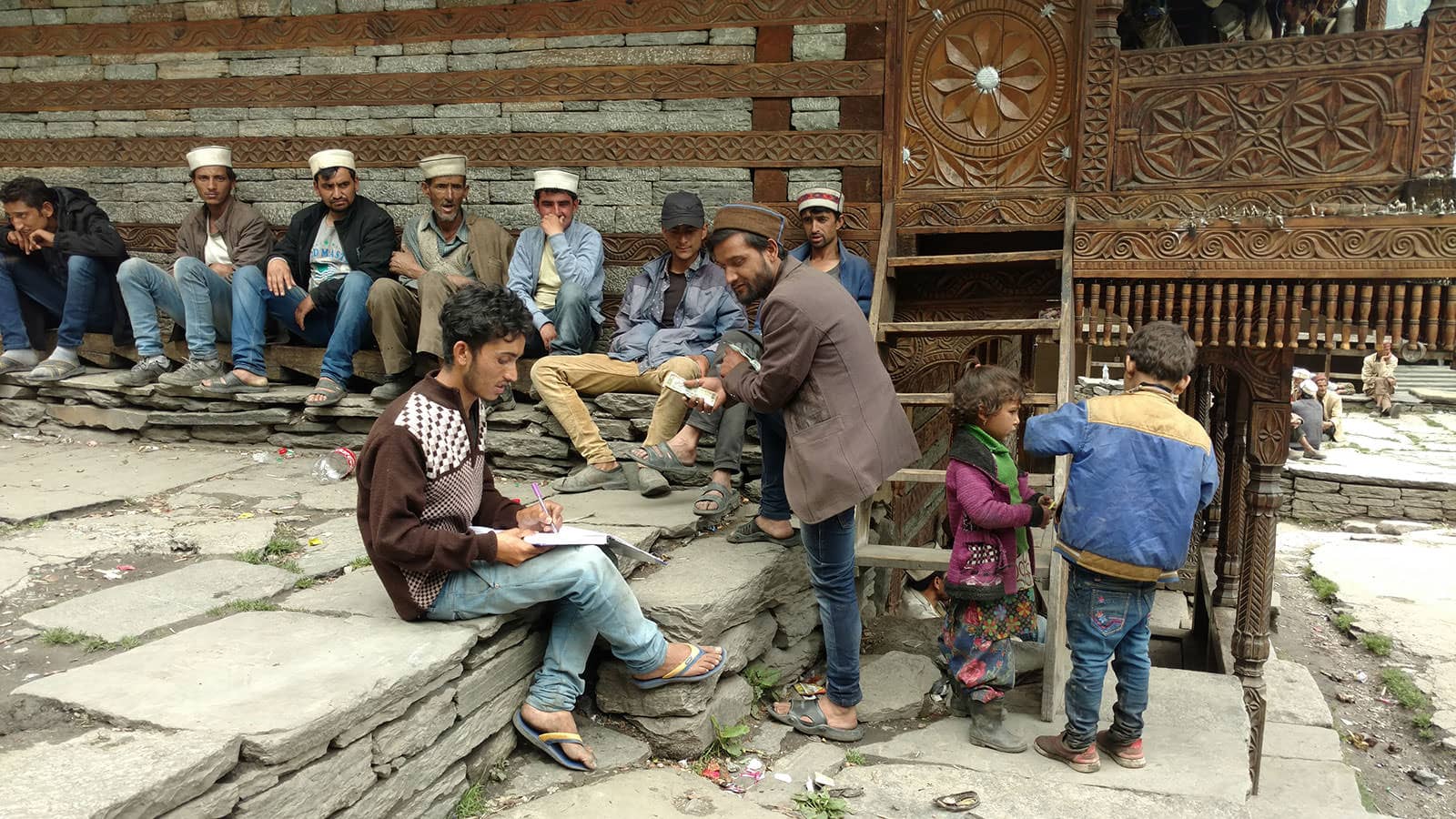
The two supervisors: Babu Ram (left) and Khubh Ram (right) collecting garbage fee from the villagers (June, 2018)
Distribution of education material for kids
We had shared an education toolkit on waste management for kids with the private school in Malana. It was reviewed by a teacher from the school: Mr. Umesh Sharma who promised us that it shall be discussed with the students periodically. This toolkit was also planned to be shared with the government school in the village, but did not happen.
Storage areas
Storage areas were allocated by the Pujari and Gram Panchayat for waste management. One allocated area in the village was granted by the Temple as well.
Installation of signage
We stuck several posters in public spaces and near every shop, tent service, guest house and temple complex for both tourists and locals to avoid littering. Posters on the programme details were also stuck for potential donors.
Garbage collection equipment
We bought 1200 sacks; around 500 pairs of disposable gloves; 12 pairs of reusable gloves; several dust masks, dust pans and tongs and stored them inside the village for use in the project.
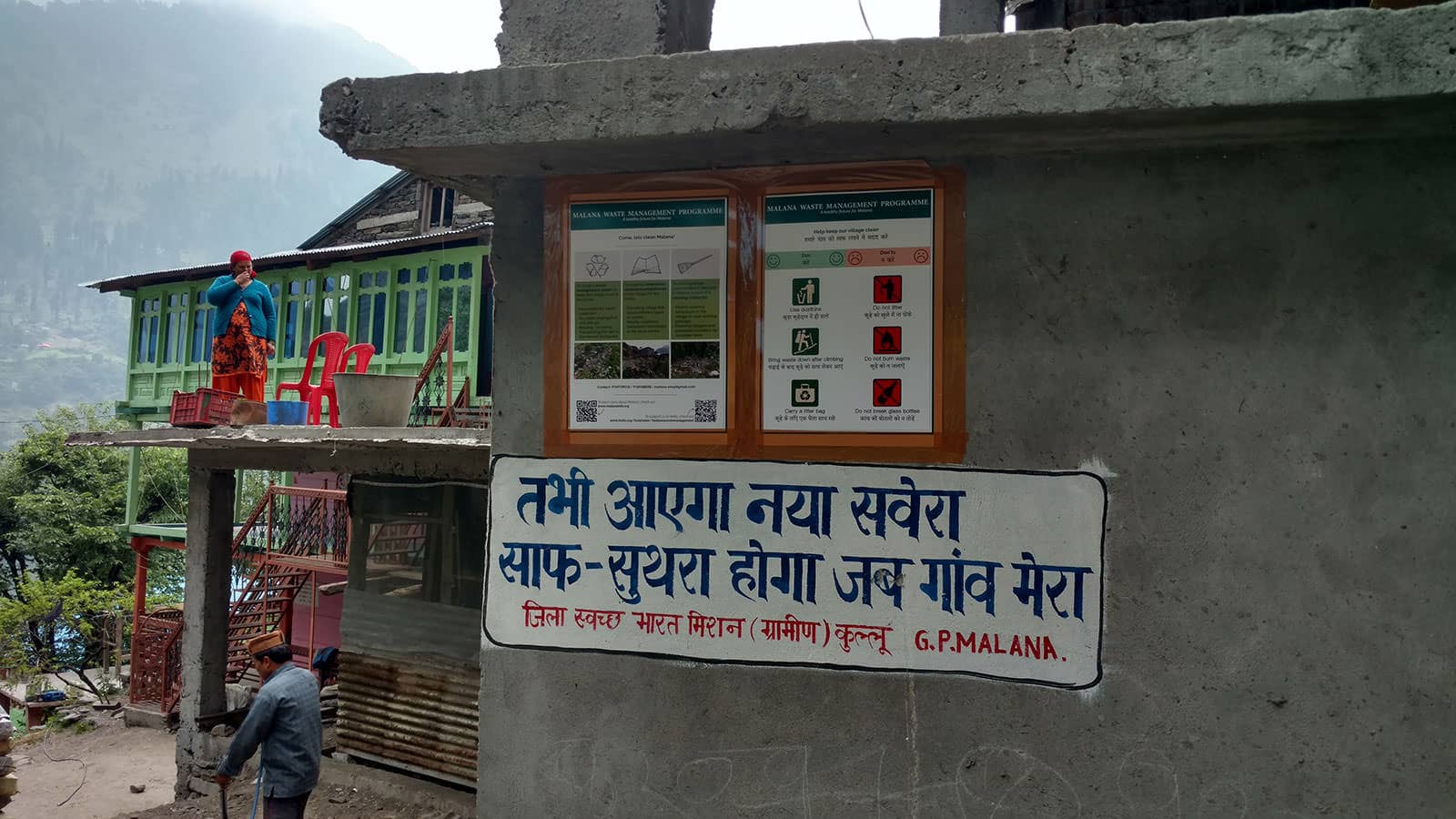
Signage in the form of posters installed next to every shop, tent service, guest house, temple complex and a few public spaces (June, 2018)
Authorization
DC meeting in Kullu- 28th May 2018
We met the Deputy Commissioner of Kullu district to inform him of our programme in Malana. He directed us to the BDO of Naggar Block and offered positive compliance.
DRDA meeting in Kullu- 30th May 2018
We met the DRDA Deputy Director cum Project Officer in Kullu and discussed our proposal in great detail. He permitted us to carry ahead this work and requested the Panchayat Secretary for further assistance.
BDO meeting in Malana- 2nd June 2018
The BDO, Panchayat Inspector of Naggar block along with several other government officials visited Malana to explain the importance of our waste management proposal to the villagers. Here, all five Ward-Panch guaranteed their compliance and agreed to talk to every single household with a team member present for further clarity. We then started covering each ward for registration for the door to door waste collection service.
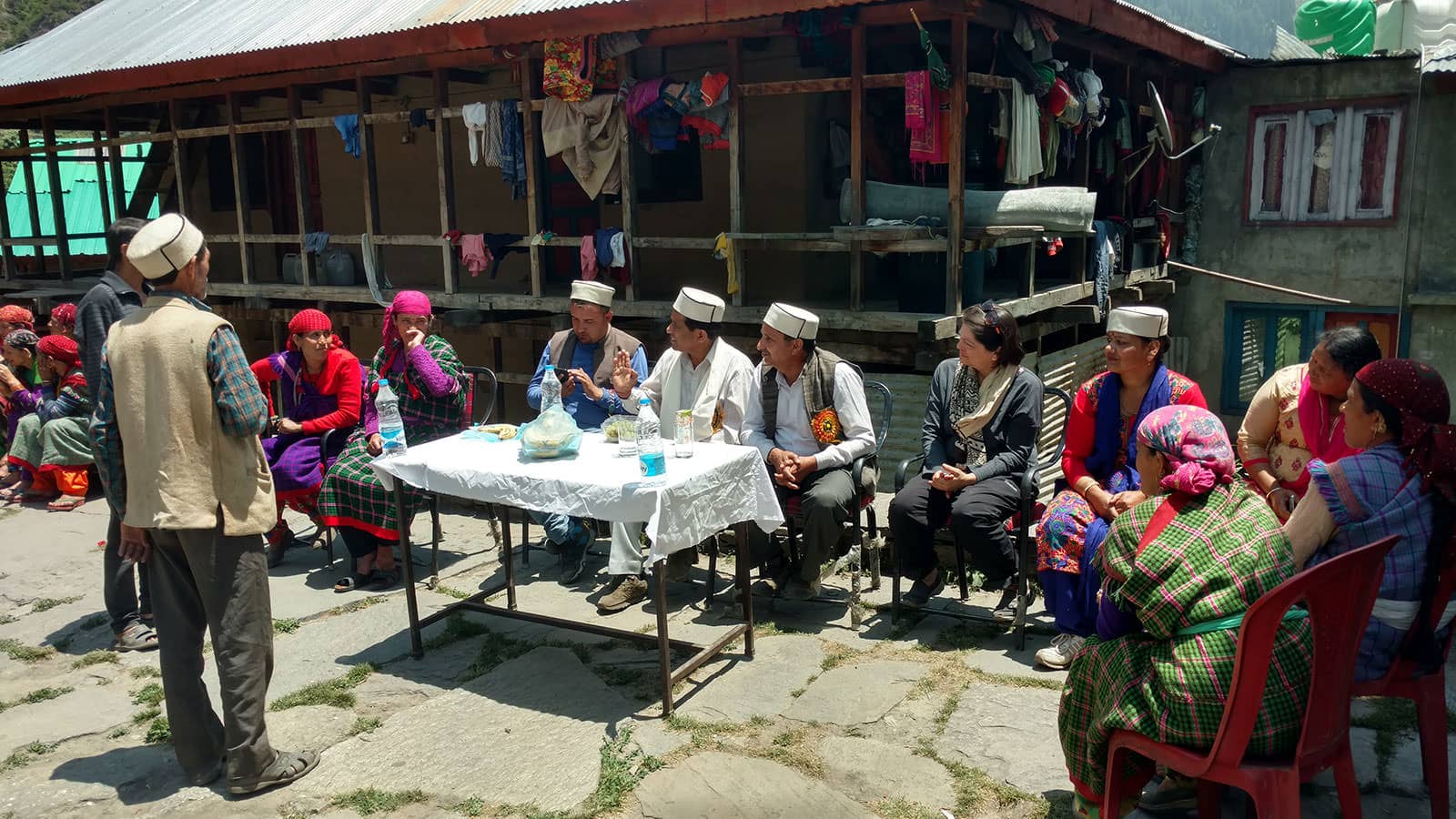
BDO meeting in Malana (2nd June, 2018)
Pujari committee- 9th June 2018
Malana has its own administrative system where the Pujari, Kaardaar and several village representatives are involved in vital decision making for the village. We presented our proposal here and it was accepted. The Temple also recognized this as “Devta ka Kaam” which means this has a higher status of public welfare. We were also offered “Devta ki Zameen”- land owned by the Temple for storing garbage sacks. The religious group also paid for the service in front of the villagers to show the Temple compliance which has great significance in Malana.
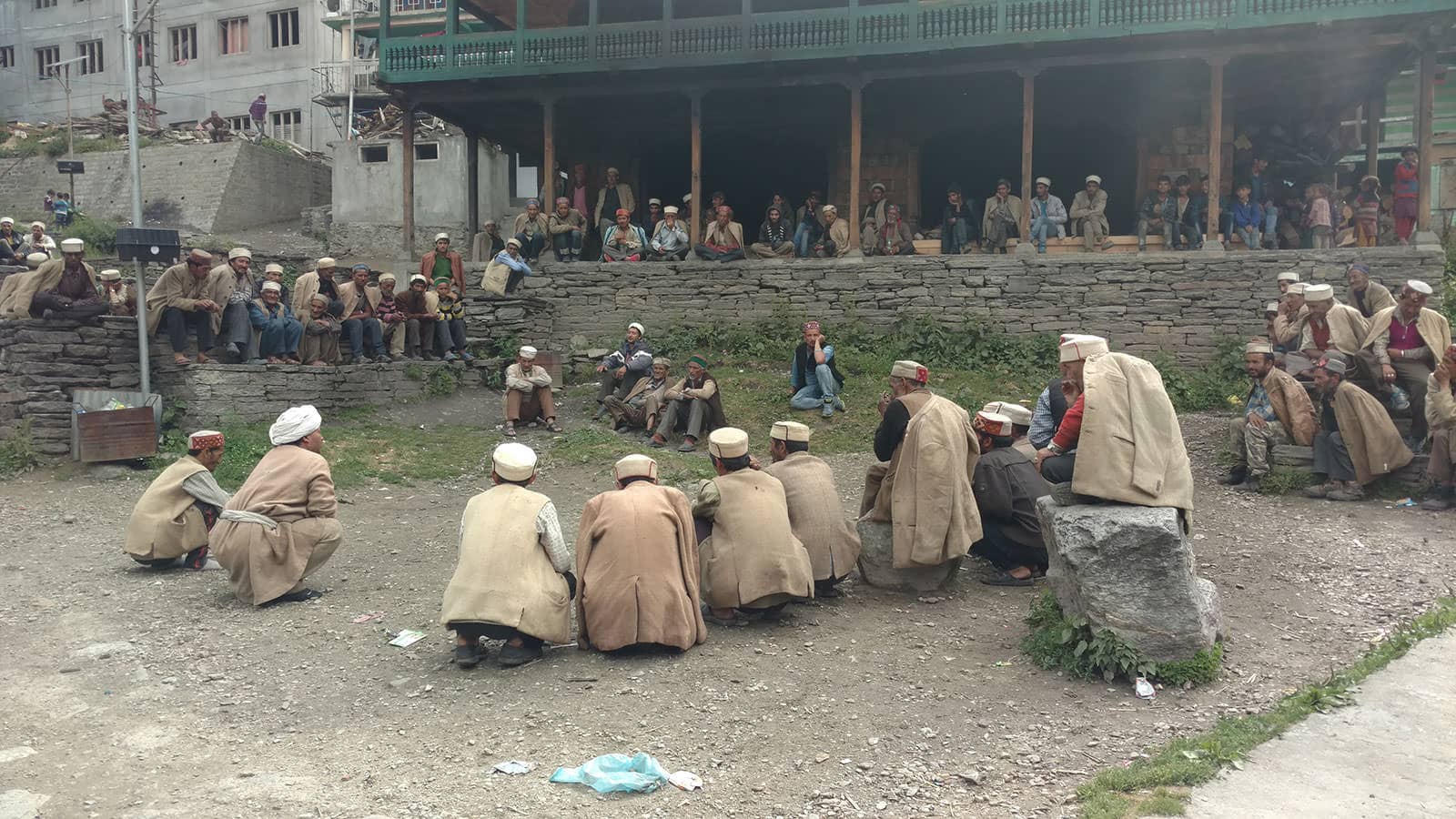
Pujari committee (9th June, 2018)
Gram Panchayat- 10th June 2018
In the Gram Panchayat, with all members present, several topics pertaining to waste management were discussed such as collection routines, authorization, fines & penalties, village compliance, etc. It was also decided that during the next Gram Sabha scheduled on 1st July 2018, the Gram Pradhan and Panchayat Secretary shall discuss the formation of the Malana Waste Management Committee.
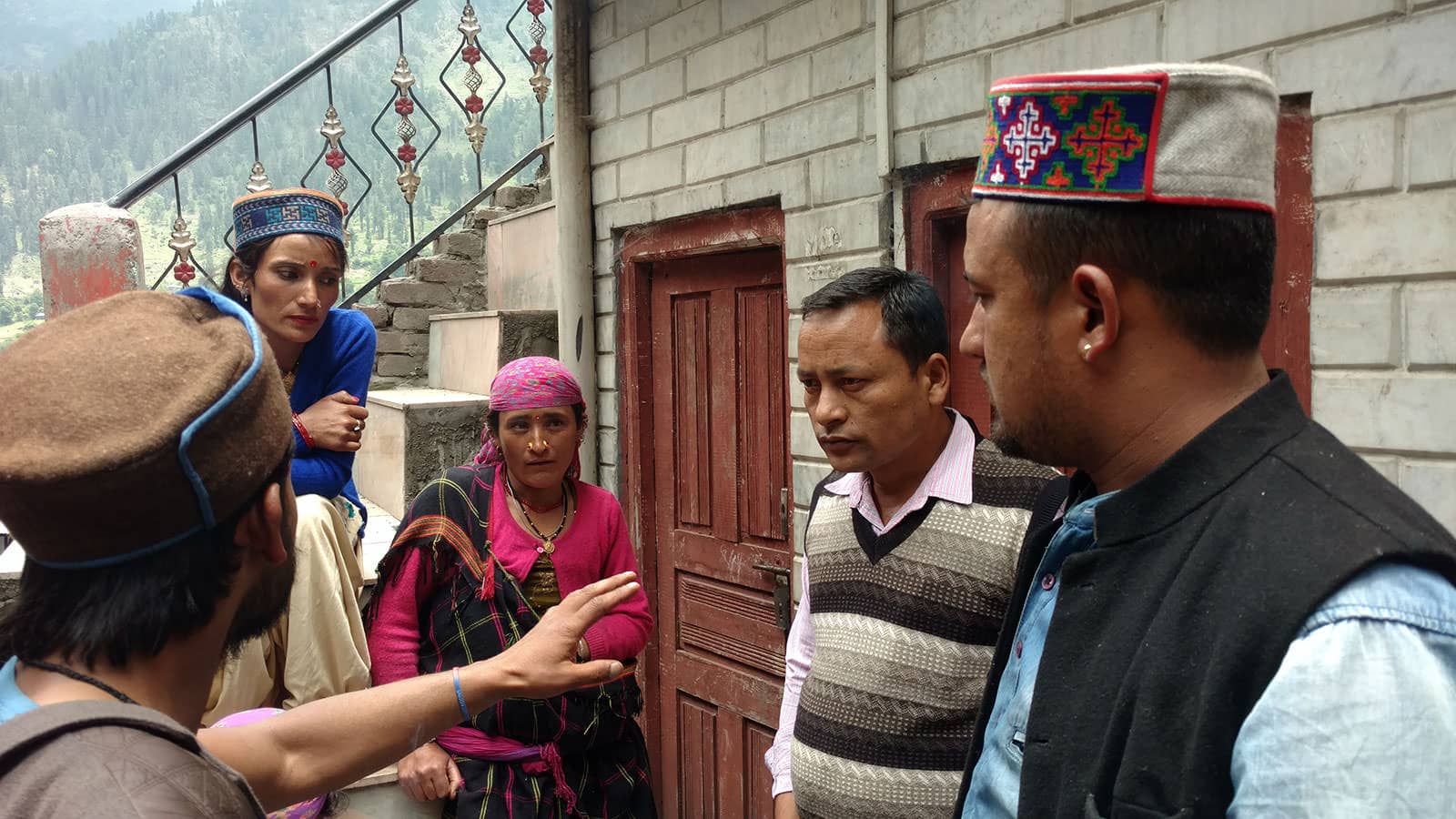
Gram Panchayat meeting (10th June, 2018)
Feasibility
Garbage fee
During our meeting with the Gram Panchayat of Malana on June 10th 2018, we decided to collect the following monthly fees from various entities for the door to door waste collection service:
- Gas stove/ Each family- Rs. 100
- Shop: Small- Rs. 200; Medium- Rs. 400; Large- Rs. 600
- Tent service- Rs. 600
- Guest house- Rs. 800
- Each laborer from outside- Rs. 50
Green tax
During our meeting with the Gram Panchayat of Malana on June 10th 2018, it was decided that each tourist who shall spend a night at a tent service/ guest house in the village shall be charged Rs. 20/ head as green tax. Every tent service/ guest house owner has agreed to add an extra column regarding green tax in their registers. Travellers were to be provided with official green tax payment receipts so as to tally the revenue collection at the end of each month by a waste management supervisor.
Fines
During our meeting with the Gram Panchayat of Malana on June 10th 2018, fines to be charged for littering were also been confirmed. They ranged between Rs. 200 for littering for being caught the first time to Rs.10,000 for the second time. The two selected supervisors were granted authority to levy these fines. Individuals could also record perpetrators littering and share the evidence with supervisors for charging appropriate fines.
Funding
Initial capital
We raised around Rs. 75,000 in two months time before we started the campaign in Malana. This initial capital was crowd funded on a website called ‘Ketto’. These funds helped us kick start the project on site and helped us buy equipment etc.
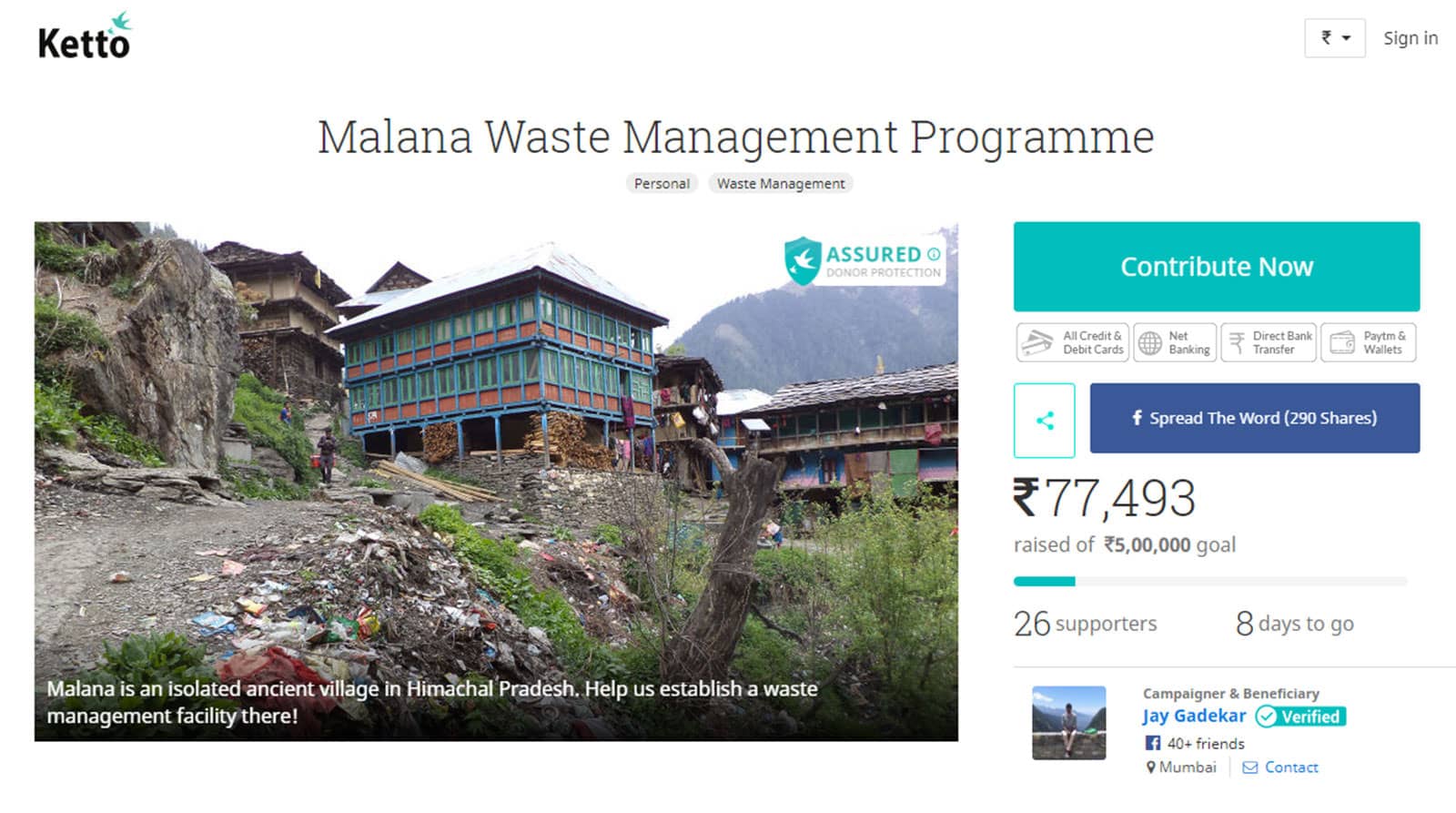
Old Ketto campaign (2018) link
Revenue
The majority of revenues to be collected were expected to come from households. Initially, we expected only 60-70% households to pay for the service. Gradually, we expected all villagers to pay.
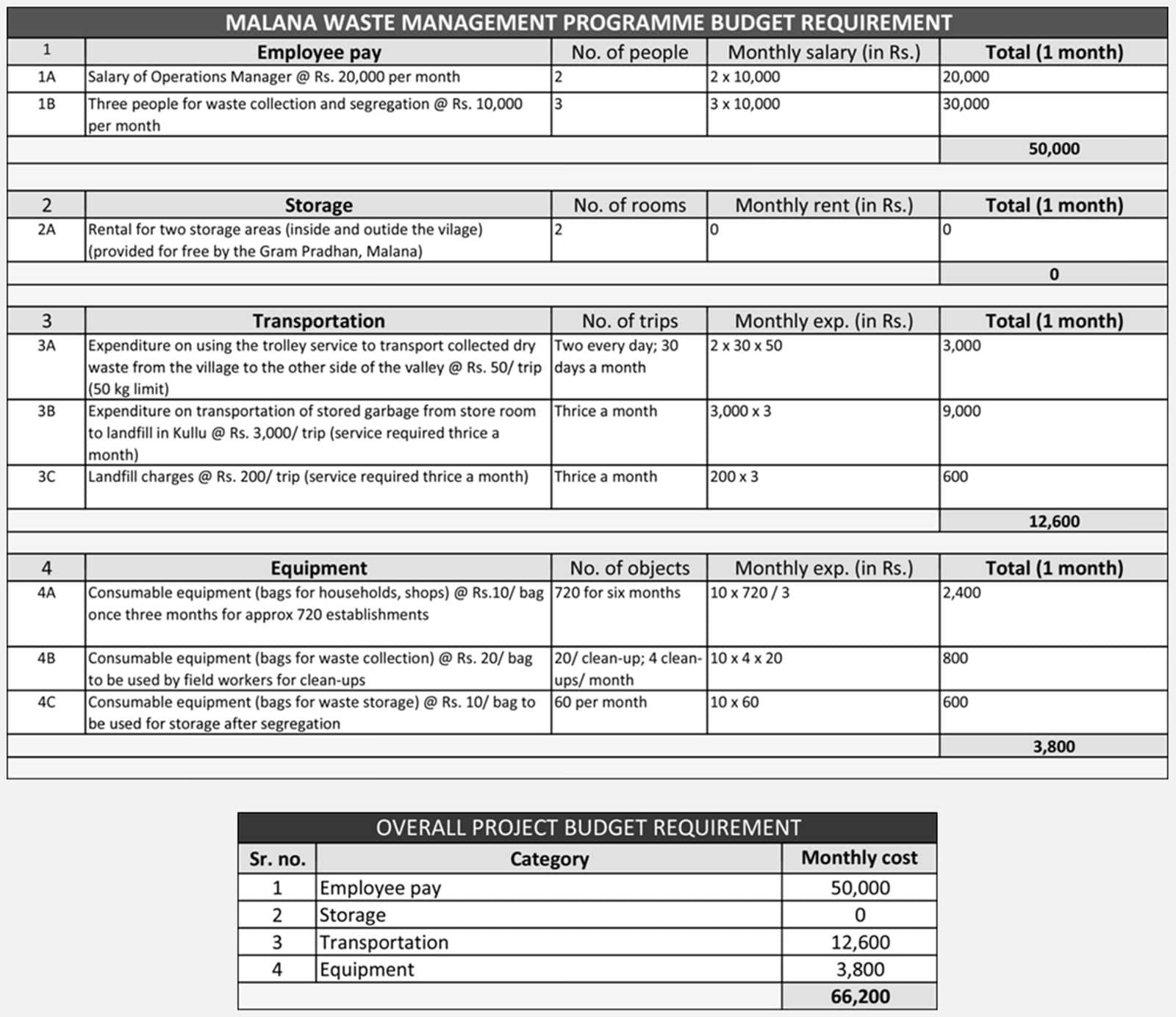
Budget requirement for the programme (June, 2018)
Challenges
Initial funding
We had spoken about it to several people who had offered us monetary help. But when it was time to help, our calls were never returned. Luckily we raised about Rs. 78,000 from donors on our Ketto campaign but had planned to raise much more as we felt villagers would not agree to pay at least for a few months. But during the campaign, there were other challenges much more serious than capital which proved to be fatal.
Difficulty in gaining trust of the people
In the beginning of the campaign, there was no support from the locals. Nobody voluntered to supervise the project, although they were willing to pay. After inviting the Block Development Officer (BDO) of Naggar block, people started talking about us. And after the permissions granted by the 'Pujari' of head priest, people acknowledged us. But only after the 'Mahila Mandal' or women's council in Malana joined us and went door to door to explain our objectives to families, people registered as subscribers to the waste management service.
Waste Management was politicized
Half of the village supported BJP while the other half the Congress National Party. The Gram Pradhan then, was a BJP candidate. So, the Congress supporters decided to not subscribe to our service as they were political rivals. Although, this was not an immediate issue, but would have raised several problems in the future.
Casteism posed as a moral dilemma
Being upper caste Hindus, the locals did not want to associate themselves with waste management. Those who wanted to ran the risk of alienation by the rest of the village. Throughout the duration of our campaign, our supervisors were made fun of and looked down upon. The supervisors did not take this seriously but were certainly affected by it.
After we hired three waste workers who were outsiders, they were accomodated on the outskirts of the village. This was serious caste discrimination and as the person leading this campaign with no clear solution to this problem, we knew that the campaign had to be stopped. A social evil can never be justified at the cost of another misery. But it is worth noting that our supervisors treated them as a team and helped them as much as they could withot facing flak from the rest of the villagers.
Waste workers left mysteriously
One morning, the supervisors found out that one of the workers had ran away from the village early morning. When we contacted the contractor in charge of the workers, he refused to pick up our calls and never explained what happened. Within a week, the other two workers also ran away. We had decided to pay a healthy remuneration to these workers and were made aware of the practices in the village beforehand. Only after their agreement were they hired. As for the contractor, he broke his agreement and as we were back in Mumbai when this happened, could never meet him again.
No support from Municipal Corporations
We had been granted land by the Temple as a gesture of support. Since, we had no other storage area, we had been storing all sacks filled with collected garbage on this land. These sacks were to be moved to a landfill soon. But, we were never granted the permission to dispose of our wastes in both the Kullu and Bhuntar landfill. Although we had the support of the BDO, it is the Municipal Corporations which manage landfills. We were asked to get permissions from people who never answered our calls. And then there was the risk of storing garbage on the Temple land for too long. If we were to store the garbage on any land other than a landfill, the National Green Tribunal (NGT) could prosecute us heavily. As we ran out of time, we were left with no option but to burn the ten tons of waste we had painstakingly collected.
Mistakes we made
It goes without saying that this happened as we had no real-world experience of cleaning a village. Cleaning a village has its own challenges and when it is as remote or exotic as Malana, its even more challenging. Perhaps, we should have started with a village closer to the city or one with no such casteism. Perhaps we should have stayed longer before returning back home. We should have known better.
Learnings
When we started the campaign, we thought the biggest challenge was to garner the trust of the villagers. It was very difficult in the beginning, but soon we had an incredible number of subscriptions. It were the logistics which were the real nightmare. From our experience we want to share a few points if you ever plan to clean a village by yourself:
- Learn about waste management: If you have no knowledge on waste management, spend time with people who do it and learn from them. Make notes on every aspect of their work. Make them your mentors if they are willing to help you further.
- Speak to local authorities: It will be a precautionary step to speak with concerned authorities. Ask them clearly what permissions you need before you plan anything. Make a visit if possible.
- Build a strong team: Before your campaign, work with the people who will accompany you there. Once, you reach the location, build a team with locals who share your passion for the same cause.
- Don't start without initial funding: Before you start the campaign do everything to get the money you need. Don't spend your own money as you will need a lot of it. Find people who are willing to support you.
- Get traction for your cause: If people cannot help you monetarily, their suppost will energize you when you run out of motivation. Everyone has finite energy and at the end of a bad day when you have lost it all, it is these people who believe in you who will rejevunate you.
- Get required permissions: Once you have a better idea of the dynamics of your campaign, get all the required permissions, especially for waste disposal at the nearest landfill. Remember that landfills are managed by cities- Municipal Corporations, not villages or blocks
- Make people believe in your cause: If you truly want good for the people, this won't be a challenge. But, there will be locals who will oppose you. Explain to them and try gaining their support also. When you won't be there, this might become an issue.
- Remunerate your team appropriately: Even if passion drives your team, the loclas involved must be soending their own time for you. Given their participation, remunerate them justly to keep them motivated.
- Invest in equipment: Be it cleaning for your team of learning resources for the villagers, build a plan such that there is allocation of resources for all. Here, mentors will help tremendously.
- Make an adaptable plan: The situation on ground will never be the same as you had planned. Tweak the plans as you face challenges and don't stick to the first one you arrived with.
We hope that you succeed and that this experience would have helped you know something we didn't when we first tried it. Please contact us if you need any help.
Acknowledgement
Waste Warriors
I (Author) had no knowledge on waste management when I decided to clean Malana. Being aware that it is really tough to clean a village, let alone managing wastes for perpetuity, I mailed an NGO called "Waste Warriors" for help. They whole heartedly invited me to learn the practicalities of waste management and I went to their campaigns in Corbett National Park and McLeodganj. I could then understand the details of planning a similar campaign in Malana. We sat and worked on the above mentioned plan together and these compassionate people offered me guidance throughout this process. Please support their amazing work here.
Women in Malana
I (Author) remember that one day I was going door to door with two women from the council. They spoke the local language and made our campaign more believable with their presence. After it was dark, it was very cold and after using my mobile flash as a torch, my phones went dead soon. I did not know any directions, could not see or speak to people around me. I was also an untouchable. But these ladies guided me through several houses while I just followed their lead. They literally showed me light in the darkness. And after each chat, I would successfully add another name to our subscription list. It was a humbling experience. They later told me that they did this because they cared for everyone in the village. Without them, we would have had no support. They don't know how to read, but I want to thank them here.
Ketto Donors
We might have failed at our primary mission to install a waste management system in Malana but nobody can deny that we were still able to clean 10 tons of garbage, support few employees fairly for a month, start a debate about waste management amongst several villages in Kullu district gain learnings of a life-time. The following is a list of kind-hearted people who donated to our cause when we needed their help. None of this would have happened without your help.
- Nilkanth Phadke
- Priven
- Manisha Singh
- Biju Gopinath
- Sourabh Phadke
- Salil Date
- Bhanudas Gadekar
- Lakshmi Nagrajan
- Ishan
- Emma Tuttleman
- Deepak Munot
- Ashok Dhandhe
- Shubhada Pathak
- Akash Singh
- Debojit Chakraborty
- Ranjeet Devckar
- Pinak
- Kashan
- Vishal Pawar
- D D Sewalkar
- Chirag Mahajan
- R D Sewalkar
- Sanjay Gadekar
- Three other anonymous well-wishers
Team
I (Author) met Mrs. Gauri Sivakumaran during our trek to Chanderkhani pass via YHAI in May, 2015. We then decided that Malana needed to be cleaned. Next year I visited Malana to analyse why it was so dirty afterall. I kept in touch with her and then we knew it was time to take it seriously. We then worked together on the Malana Waste Management Programme.
I met Babu Ram in the village near the temple complex. He is a responsible educated person, with a Bachelor in Arts from Kullu and wants to see the village clean. He handled the documentation of work.
I met Khubh Ram near a tent service at one end of the village. He has always been passionate about cleaning his village and wanted to join the movement. He has no formal education, but his inquisitive attitude and experience with all people in the village gave us an edge over understanding the locals better.

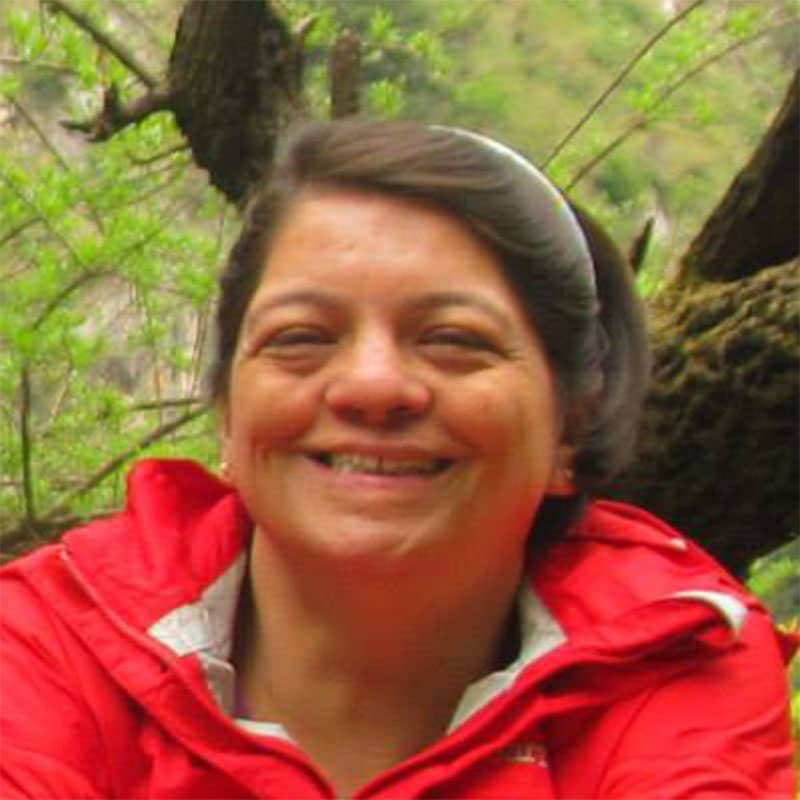
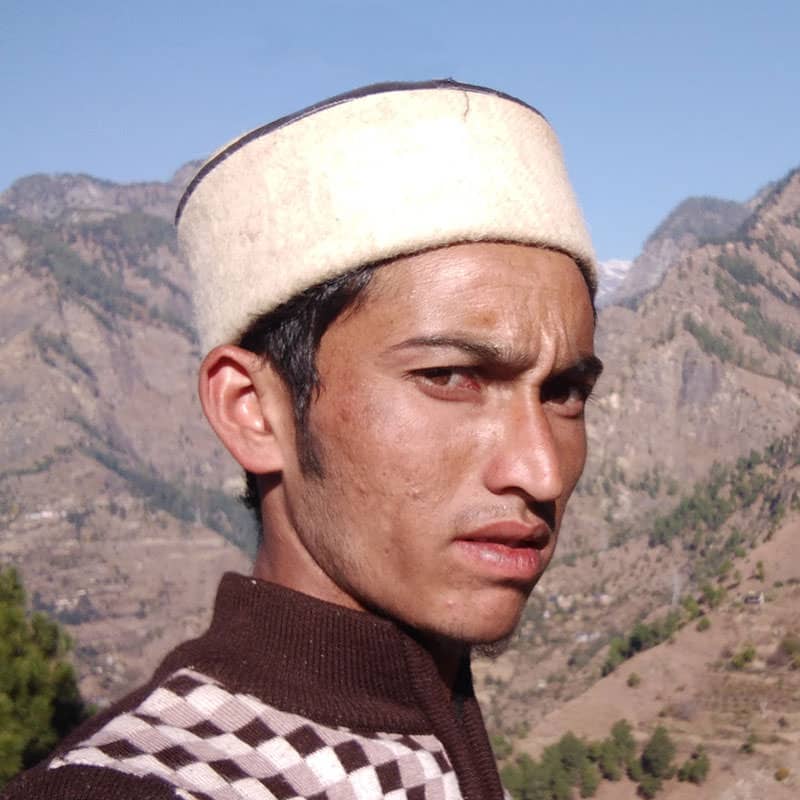
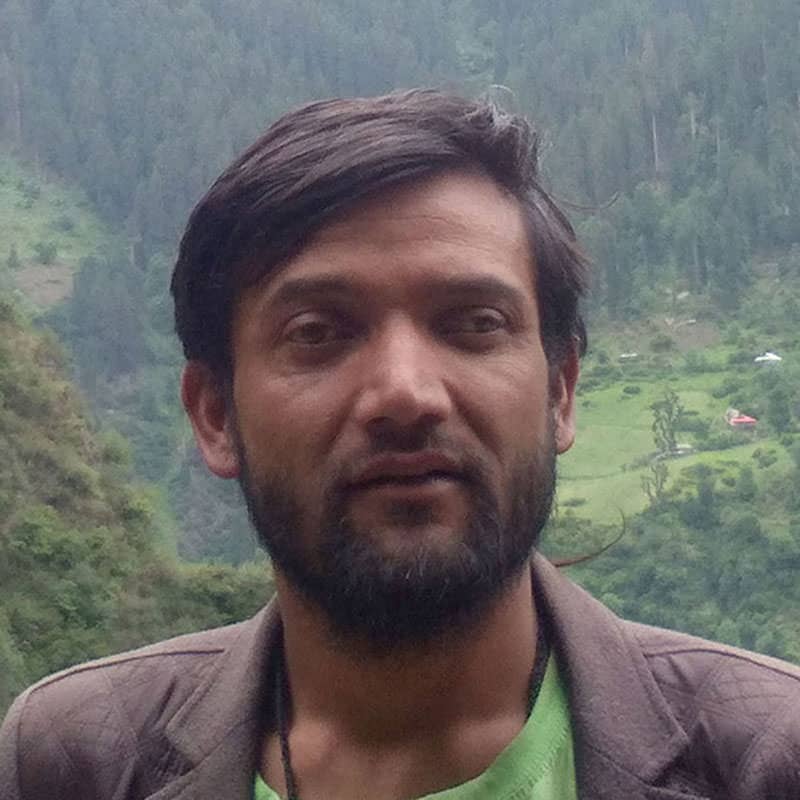
From left to right: Jay Gadekar; Mrs. Gauri Sivakumaran; Babu Ram; Khubh Ram
Introduction to Malana
Background
Malana is an ancient village in Kullu district of Himachal Pradesh, India. Primarily known for the best hashish in the world, it gained fame in the beginning of this century as the best Hippie spot and cheap stash. But, Malana has always been more than that. It has a beautiful culture that stands out amongst all other Himalayan villages.
Located at an altitude of about 8700 ft, this village has always been quiet and peaceful. Like all Himalayan villages, Malana also has a temple complex, shrines to its main deity and different religious practices. Its administrative system resembles that of a democratic republic and these people are known to speak a dialect not spoken anywhere else in the world. The inhabitants of this village worship Rishi Jamdagni who is the greatest of all mountain gods that nearby settlements revere.
In 2007, because of a dam construction project, a road reached the village and Malana commercialized and then entered a phase of globalization. The elders called it the intrusion of the government which destroyed its forest and placed a ban on their 'Holy weed'. Outraged, they rebelled but soon greed for money and jobs in the dams and the valleys lured the newer generation toward the modern world. This phase has stabilized and Malana is modernizing now. But, the backbone of its economy is the cannabis production which is illegal. The present scenario is much more complex and this website covers a holistic view of the history, culture, economy, infrastructure, tourism and many other aspects of this village.
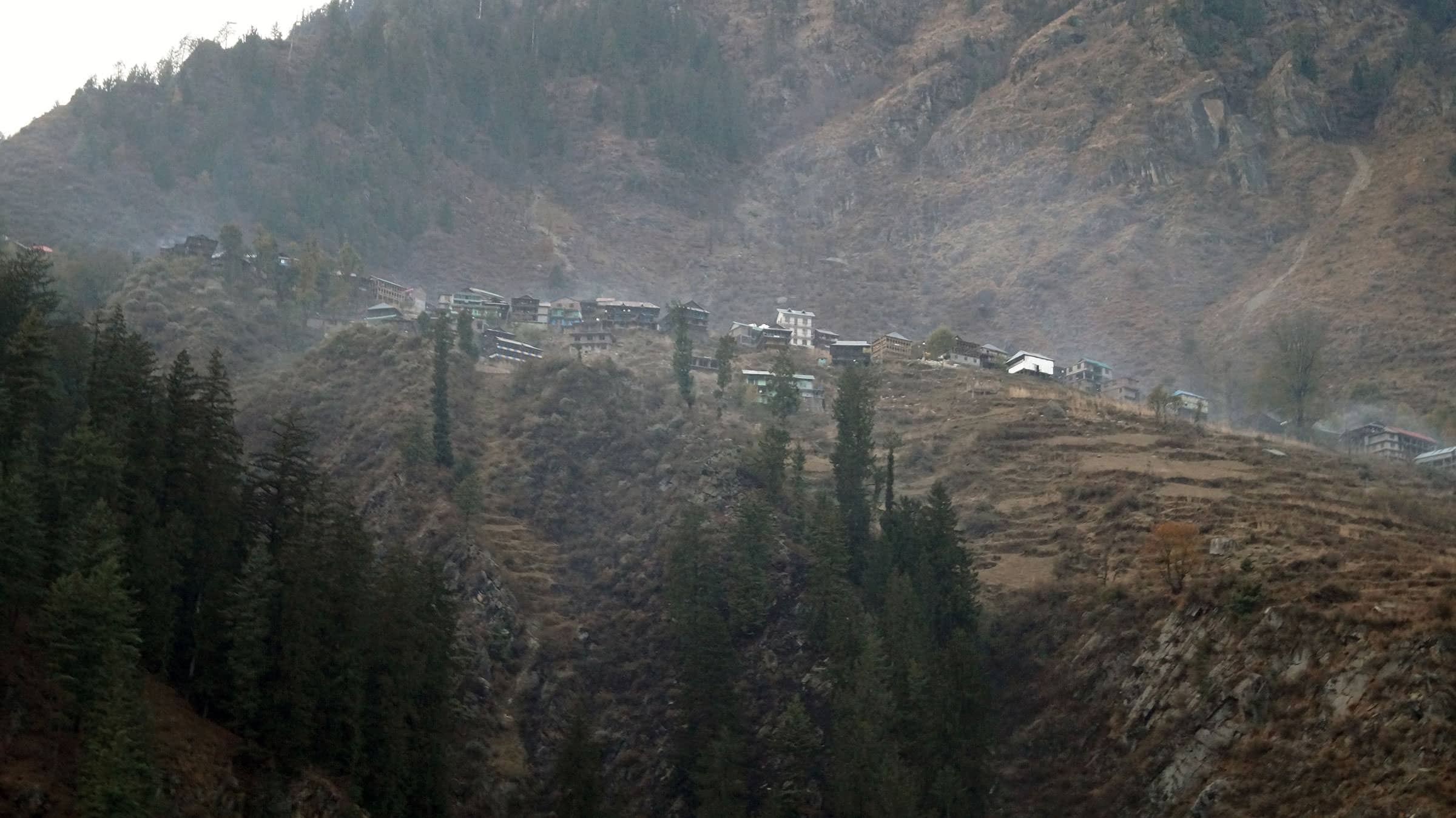
The first view of Malana while travelling to the village by road
Author's Note
I (Author) walked through Malana in May 2015 as part of a trekking group heading the Chanderkhani pass. The village was nested like a citadel at a beautiful valley side, but the piles of garbage and dumped plastic bags caught my eye. I asked the guide why the village was so dirty and I learnt that Malana was not a everyday simple town. There was much mystery to its exotic culture and many controversies surrounded its lineage. I wanted to clean that village, but for that I had to know more. I never expected to go this deep into studying it but I had to because it had a very dramatic timeline and yellow journalism on the internet was showcasing this village as something it was not and it needed to fixed.
Fortunately, I found Mr. Amlan Datta who made a movie on Malana called "BOM-aka-One day ahead of Democracy". He stayed there for five years to film and knew almost everything about the village and its people. He runs the "BOM-BOM" charitable trust which offers training to the locals in a few economic activities specific to Malana. He has also supported the education of two kids from the village. With his constant support and close contacts in the village, I was able to gather information on many aspects of Malana's society. He is still assisting me with the crowd-funding and the waste management programme. This would not have been completed without him.
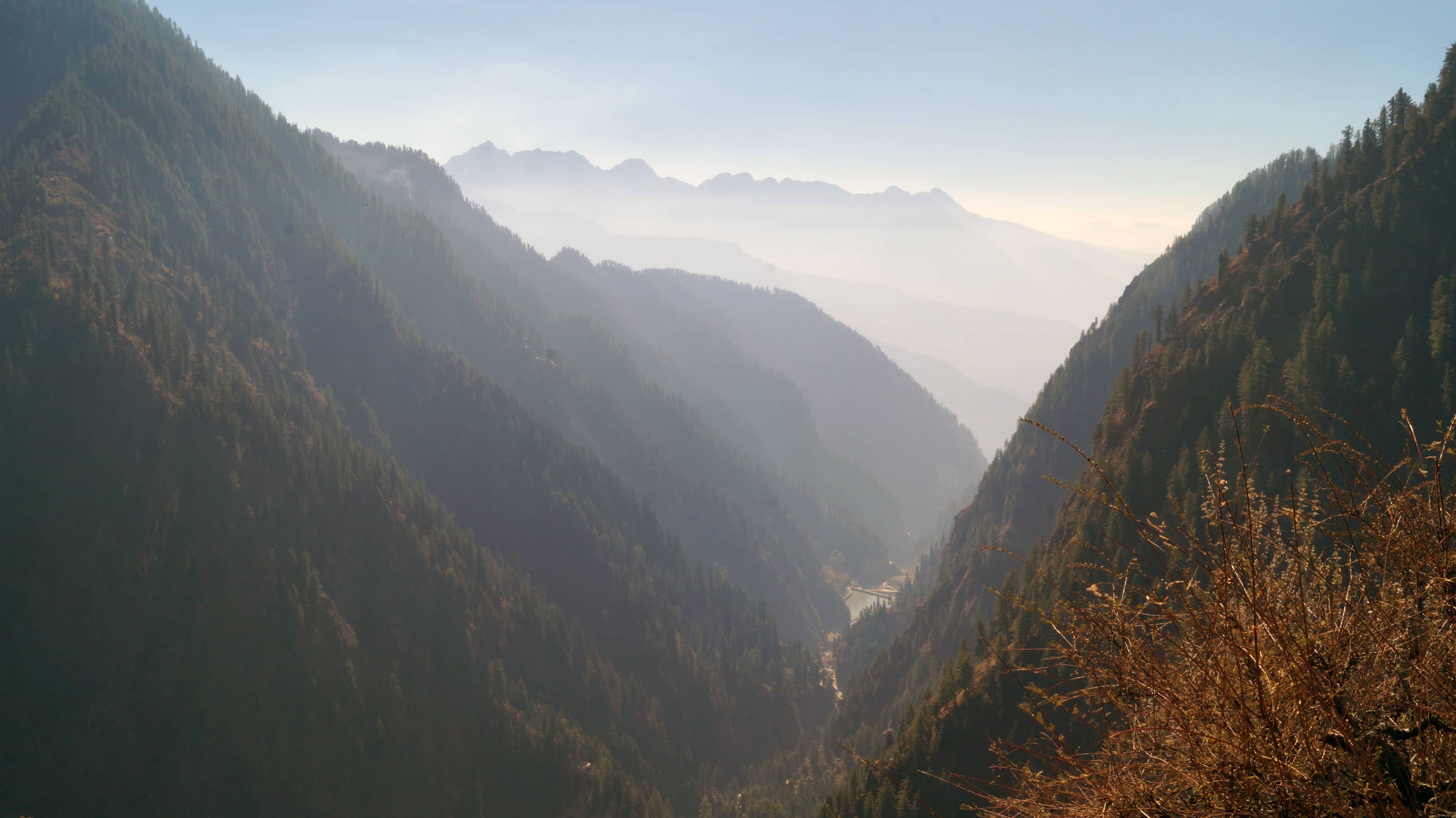
The south-facing view of the Malana valley
Aims and Objectives
Significance
The aim of this research was primarily to understand the village properly so as to know the background well. There are a few genuine researchers, but most of what can be found on the internet about Malana is either false or lacks genuine references.
Malana, today, faces an "Identity Crisis" because people have misunderstood its culture and eccentric systems. This is because several 'travellers' and 'bloggers' have fabricated stories either from their imaginations or from collection of incorrect information and they have posted them on their domains. This has resulted in widespread delusion of what this village actually is and has negatively impacted Malana's image in our society and has also affected the locals.
Such insensitive journalism should be detested and hopefully, this portal will help tear apart false stories about Malana.
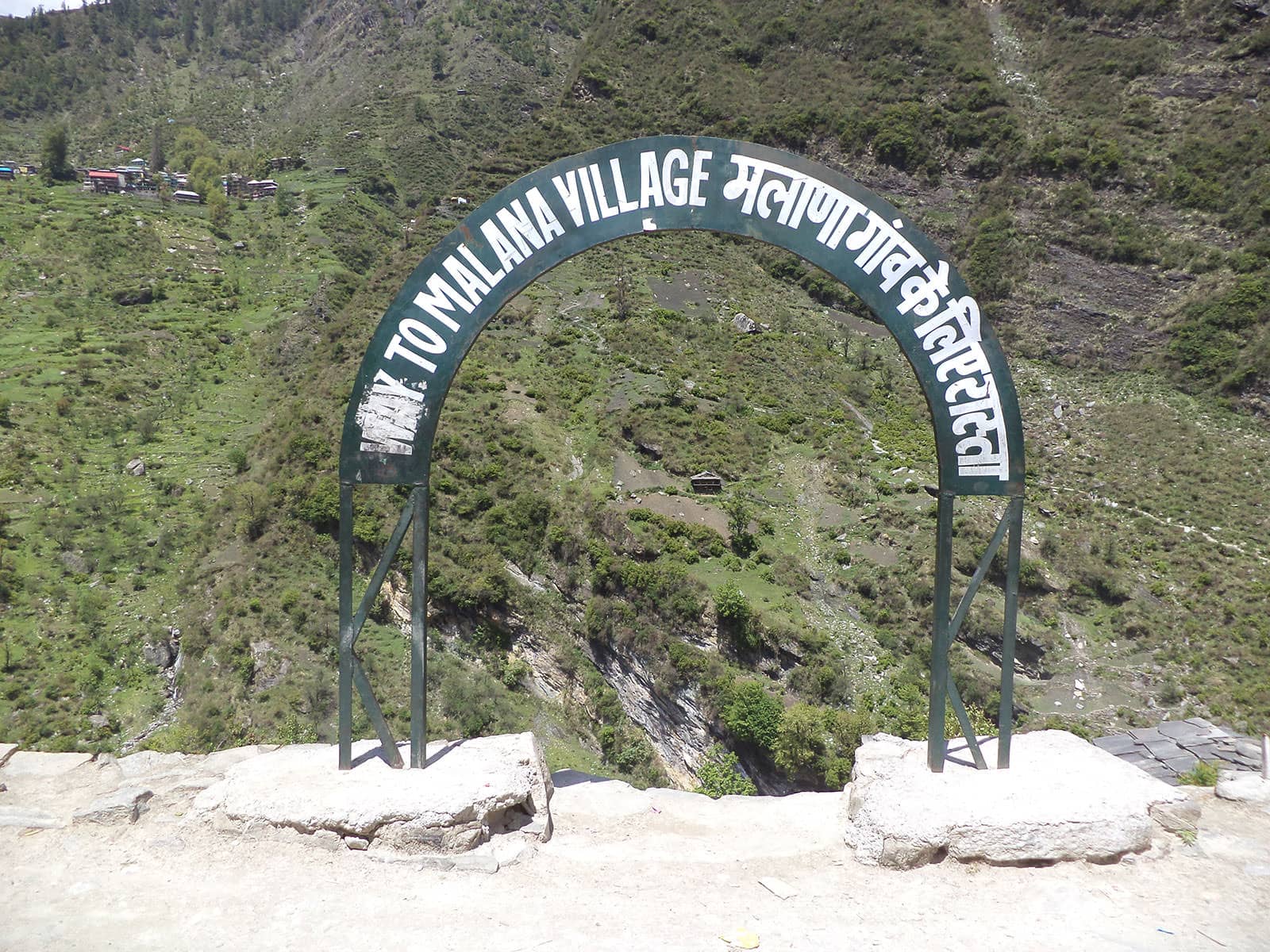
A welcome sign on reaching Malana village
Objectives
- To study the factors influencing the lives of Malana's inhabitants
- To understand the economic background of the village
- To derive from present trends, where the future of the village is heading
- To study the present social structure and the working of the village
Methodology
Data Collection
The data collected covers aspects of the village such as the social structure, administration, legislation, faith and religion, present infrastructure and other amenities. Being unique in nature, a lot of attention was given to the cultural background of the village. Quantitative data was also obtained from statistical reports to back up the data collected from interactions with the locals.
Sources of Data
Three sources of information on Malana have played a pivotal role in understanding life in Malana:
- Exhibition- Malana Shangri-La in the Himalayas
- Movie- BOM aka One day ahead of democracy
- My visits to Malana village
- My stay in Malana during the waste management campaign
Direct communication with the locals during my stay in the village and passive ways such as communicating through emails, online social networks and phone calls with the researchers who have played leading roles in the exhibition, movie and the book mentioned above have also allowed me to know a lot more on the village.
Sample Design
For the questionnaire survey, 10-15 individuals were approached, and information was sought regarding various social and economic issues. The selected individuals were males and the number of individuals interviewed were limited due to certain limitations mentioned below
Data Analysis
A questionnaire covering topics such as village life, cannabis cultivation, garbage disposal, other commercial activities such as sale of wool and hemp products and housing was developed for the locals. A survey was also done to gather information on travel expectations and experiences of tourists in Malana. The census report of 2011 by the "Census of India" has been very helpful to get empirical data very important for this research.
Limitations of Data Collection
- The location of the village being very isolated, has resulted in its documentation very few times in history. This has resulted in the spreading of rumors about the lineage of its inhabitants. These myths will be discussed later
- The villagers treat all non-Malanis as impure/ untouchables. Although most of them were kind, this cultural background resulted in an atmosphere where communicating with some locals became difficult and unappreciated
- Due this stigma as mentioned above, heavy fines have been charged on violation of certain terms such as clicking of pictures or touching holy places. So, roaming in the village was considered an activity to be undertaken only under the presence of a guide who was available only during certain time periods of the day
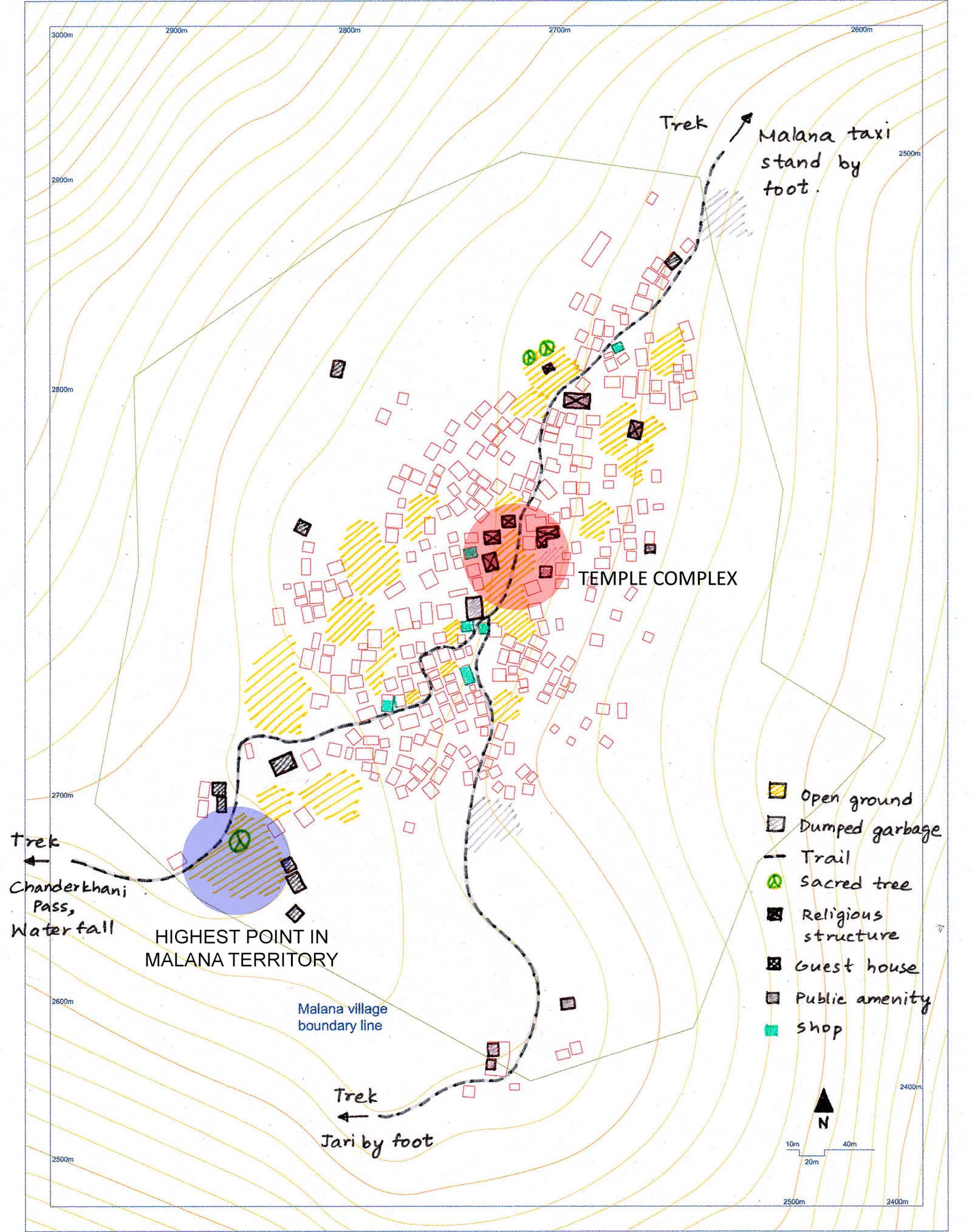
Simple plan of Malana
Mythological Story of Origin
Story
In ancient days, Rishi Jamdagni worshipped Lord Shiva, Brahma and Vishnu. After his intense prayers, Lord Shiva was pleased and appeared before him. Shiva told the Rishi to ask for a boon. Rishi Jamdagni asked for a beautiful secluded place full of nature's bounty and Shiva asked him to go to Malana. To prevent his two brothers from following him, Rishi Jamdagni created mist in the valley due to which, one of his brothers reached Lahaul and the other reached the Banjar valley.
When Rishi Jamdagni reached Malana, it was under the reign of a 'Rakshasa' who was called 'Banasura'. Banasura rested in the form of a serpent with his head on the Chanderkhani pass and body lying from one mountain top to the other encompassing the whole village. When Rishi Jamdagni appeared, the demon threw him and all his disciples into a cooking vessel and started to cook them. For twelve years, he cooked the Rishi uprooting all trees for wood. Still, the Rishi lived. So, Banasura begged for mercy and promised to give the Rishi what he wished for. Rishi Jamdagni asked for nothing else but Malana. Banasura pleaded him to ask for anything else like gold, silver or other jewels. But, the Rishi insisted and since the 'Rakshasa' had already given his word, an agreement was made amongst the two before Banasura left Malana:
- Administration and justice were to be handled separately
- The members of the executive were to be selected in consultation with Banasura
- Justice was kept under the preview of Jamdagni Rishi
- In case of a dispute in the administration it was to be sorted out by the judiciary
- The Kanashi language was made mandatory for those living in Malana, and also the customs and traditions prevalent there
During festivals, the first sacrifice was to be made to Banasura. With the passage of time, Jamdagini Rishi gained superiority over the 'Rakshasa', but the village retained its traditions which are still followed there.
In the center of the village, in front of the main village temple lies a patch of grass. The villagers believe that Parshuram, son of Rishi Jamdagni and an avatar of lord Vishnu grew this patch and the village was established.
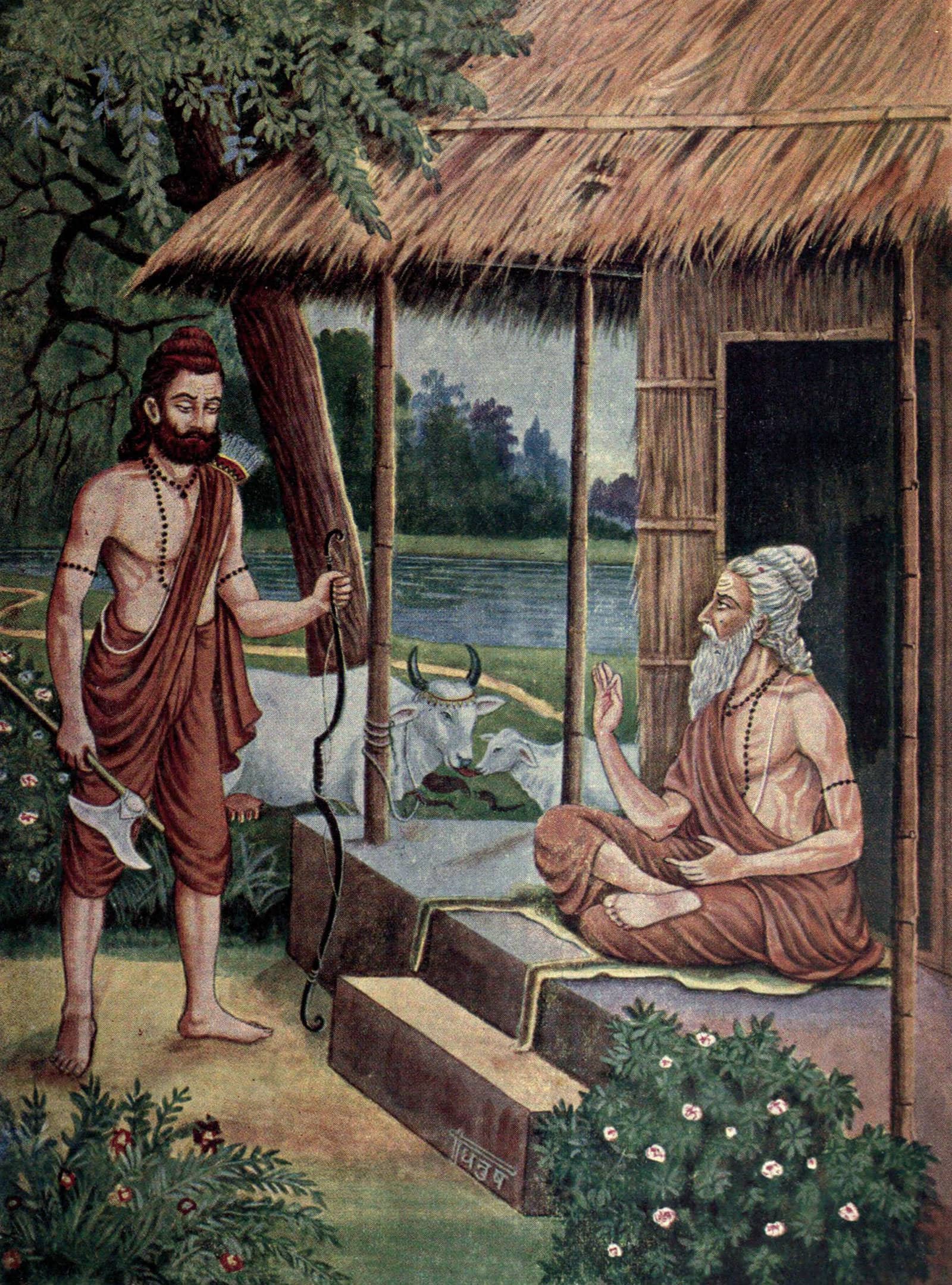
Parshuram (left) with his father- Jamdagni Rishi (right) [Source: https://en.wikipedia.org]
Geography and Social Structure
Location
Malana village is in the Kullu district of Himachal Pradesh, India. At an altitude of 2652m (8701 ft), the village lies in a side valley of the greater Parvati valley. It is 19 kilometers away from the nearest village called Jari which is connected to a roadway heading toward Kasol and Manikaran. It is situated on a gradual slope on a mountain and villagers own land on nearby mountains as well. The village is surrounded by dense forests and the nearest village by foot is Rasol (to the east) which lies across the Rasol pass.
Latitude: 32.062; Longitude: 77.260
Pin code: 175 105
| Village | Block | District | State | Parliamentary constituency |
|---|---|---|---|---|
| Malana | Kullu | Kullu | Himachal Pradesh | Mandi |
| 12882 | 0025 | 026 | 02 | - |
Location of the village [Source: http://www.censusindia.gov.in]
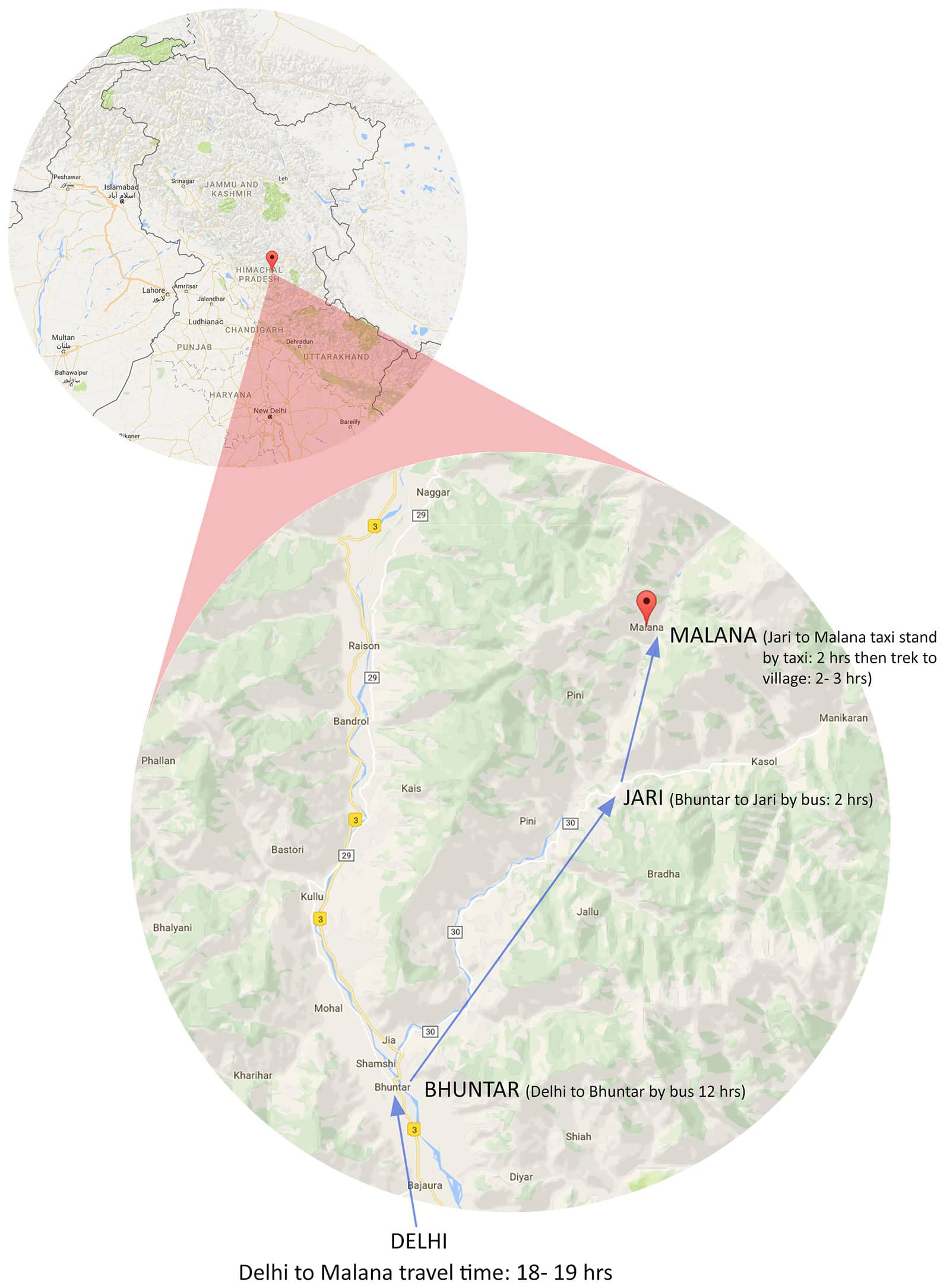
Malana location map
Milestones
| Year | Description |
|---|---|
| Unknown | Village established |
| 1960's | Commercialization of cannabis starts |
| 1970's | Establishment of post office |
| 1984-90 | Electrification |
| 1991-92 | First construction with concrete (new materials) |
| 2001 | Detention of drug mafia First telephone First television |
| 2007 | First guest house First mobile phone First computer |
| 2008 | Construction of road to Malana Electrical fire in village |
| 2013-14 | Installation of trolleys for goods |
Important milestones reached by the village
Demography
The total population of the village (as per Census of India 2011) is 1722; out of which total number of males is 888 and total number of females is 834. The sex ratio of the village is 939 females per 1000 males. The total number of children (0-6 years of age) is 371; out of which 202 are males and 169 are females.
From the most recent data acquired from the Naggar block Village Panchayat Inspector, the population of Malana has increased to 2000. Also, the number of households has risen to 400 as of February, 2018.
| Caste wise distribution | Total number of families | Total number of males | Total number of females | Total population | |
|---|---|---|---|---|---|
| General | Schedule Caste | ||||
| 2016 | 31 | 436 | 1036 | 1011 | 2047 |
Households and population dynamics of Malana [Source: Panchayat Inspector's Office, Naggar]
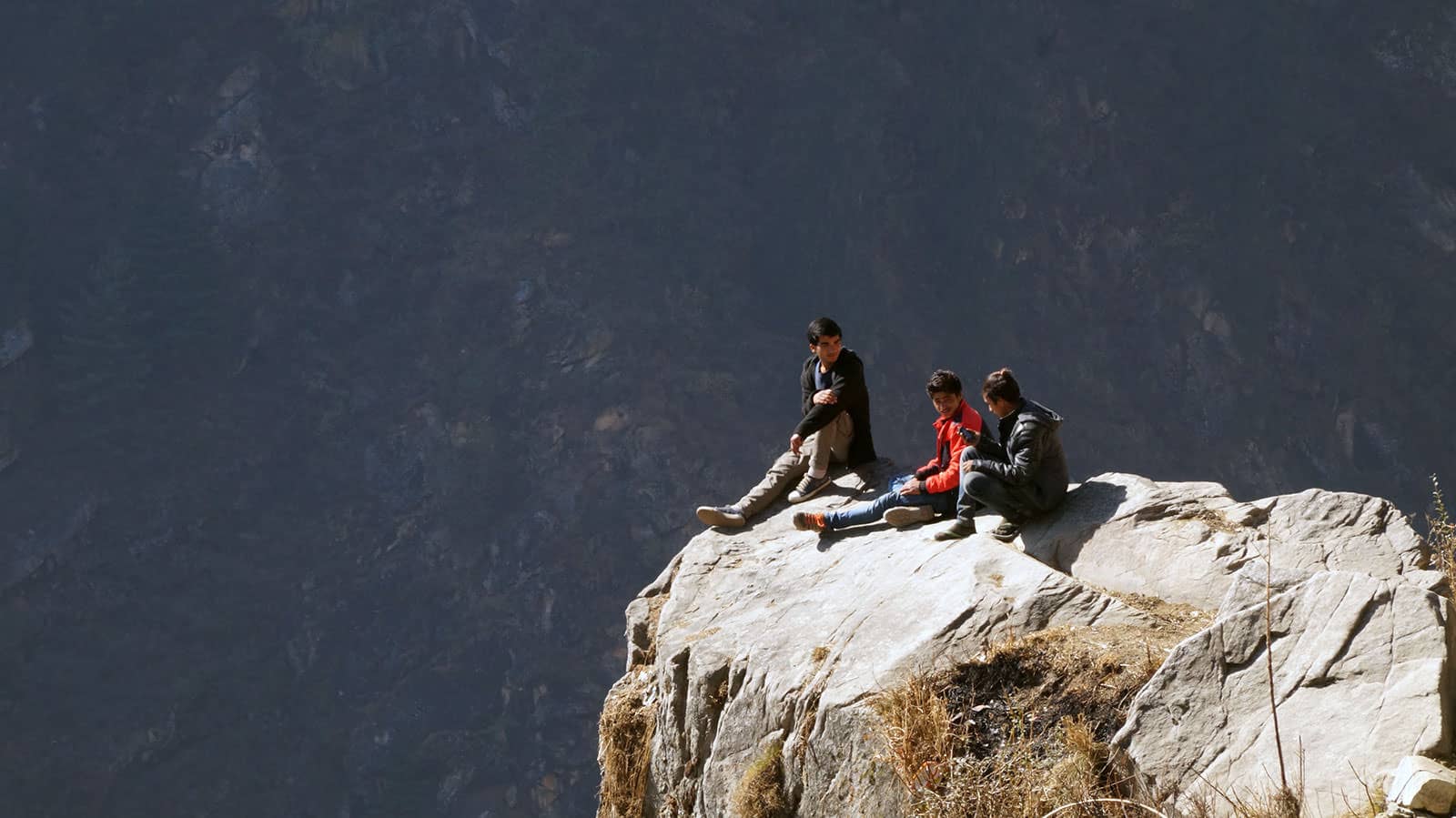
Teenagers having a good time (November, 2016)
Literacy Level
The literacy rate of Malana(as per Census of India 2011) is 31.65 %. The literacy rate of males is 40.54 % and females is 22.18 %. Since, 2001, the literacy rate has gone up by 26 %; out of which the literacy rate in males has risen by 29% and in females has risen by 23 %.
Social Structure
All inhabitants of Malana today, are Hindus. There exists a group of 28 persons belonging to the Scheduled castes who are known as the Lohars. The Malanis treat all other people as untouchables due to their cultural beliefs. To do jobs like playing musical instruments during ceremonies or other festivals in the village, this Lohar family was invited to Malana long ago. Since then, they have grown in numbers and but are still treated as untouchables.
Institutions
| From | To | Institutions | Distance |
|---|---|---|---|
| Malana | Pathankot | Pathankot railway station | 183.3 km |
| Malana | Manali | Tehsil | 85 km |
| Malana | Kullu | District headquarter College |
45 km |
| Malana | Bhuntar | Bhuntar airport | 39.3 km |
| Malana | Jari | Primary health center Veterinary hospital Bank Market High school |
19 km |
| Malana | Dukhra | Police station | 17 km |
| Malana | Nirang | Bus stand Taxi stand |
2 km |
| Malana | Inside the village | Post office Primary school Middle school Gram Panchayat Temple |
- |
Formal and informal institutions
Gender Clock
The working patterns of the inhabitants of Malana change with different months such as April to May, June to August, September to November and December to February.
Women work more than men (discussed later) and wake up earlier than men. Sometimes, men may work on activities such as sheep herding, manual labor or cultivation of crops. Similarly, women too, do not have a rigid clock to follow. People in Malana eat lunch early in the morning and the next meal they eat is dinner at night.
During the months of the winter season (December- February), the villagers get up late and work very less. Income is stagnant; hence, grains and other consumable items are stored for the entire season. Fire wood and grass for live stock is stored as well.
| Time | Activities of females | Time | Activities of males |
|---|---|---|---|
| 5am-6am | Get up and get fresh | 6am-7am | Get up and get fresh |
| 6am-7am | Cook and eat lunch | 7am-8am | Cook/ eat lunch |
| 7am-5pm | Work (any) | 8am-5pm | Work (any)/ Rest |
| 5pm-6pm | Cook dinner | 5pm-6pm | Cook dinner |
| 6pm-7pm | Get fresh/ Bathe | 6pm-7pm | Get fresh/ Rest |
| 7pm-8pm | Eat dinner | 7pm-8pm | Eat dinner |
| 8pm-9pm | Watch TV or Sleep | 8pm-9pm | Watch TV or Sleep |
A general gender clock
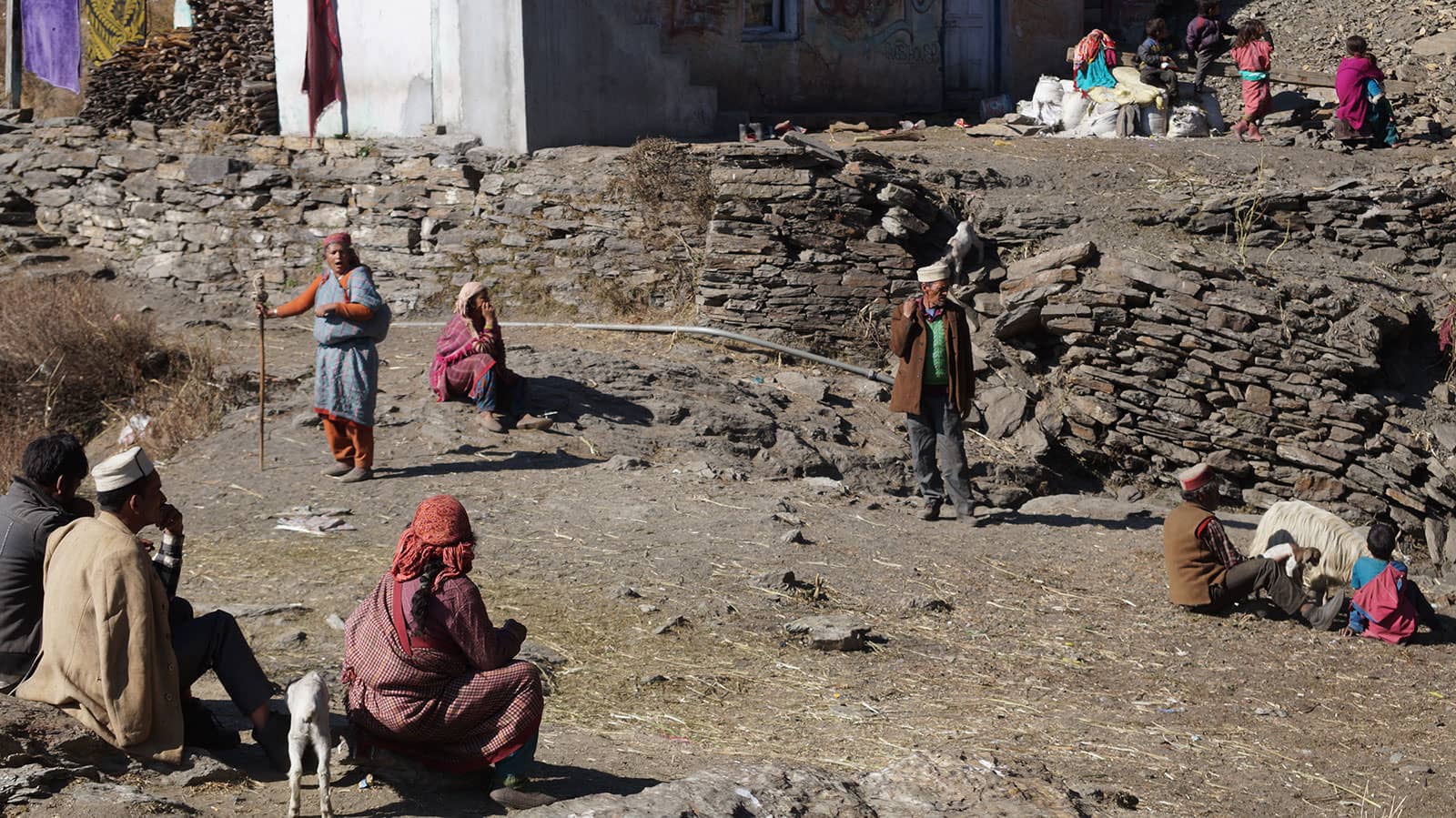
Villagers chatting with each other (November, 2016)
Weather and Seasonality
Weather
The climate is cold. Temperatures drop drastically during the nights and rise during the day. Summers are comfortable to live due to less precipitation. The months of July and August are categorized as rainy due to the south-west monsoon. Temperatures decrease to the least between December and February marking the winter. Snow as high as 8-14 ft may cover the ground and water in taps freezes causing inconvenience. The snow melts in March when the temperature start increasing during the spring season.
Temperature
The climate being cold, the maximum temperature even during the Summer season stays at the mid 20 degrees celsius mark. In the coldest days of the Winter, temperatures may drop to even -15 degree celsius. Due to the mountainous terrain, mild rainfall occurs often in the afternoon. Humidity is low.
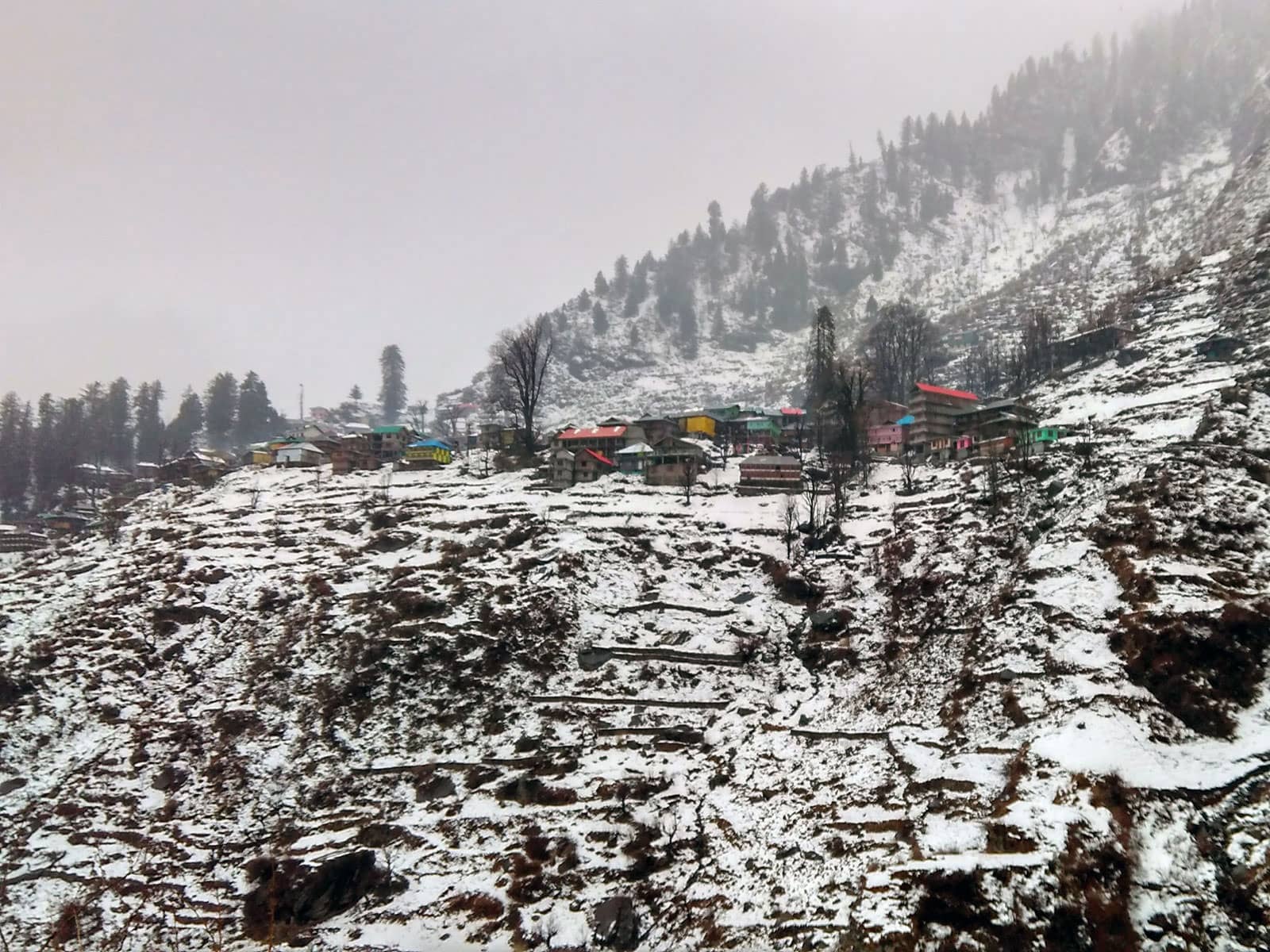
Winter in Malana (Picture courtesy: Amlan Datta)
Cropping Pattern
Other crops such as potato, corn, cabbage, rajma and 'Kattu'(wild fruit) are cultivated for personal consumption whenever land is free (except in winters).
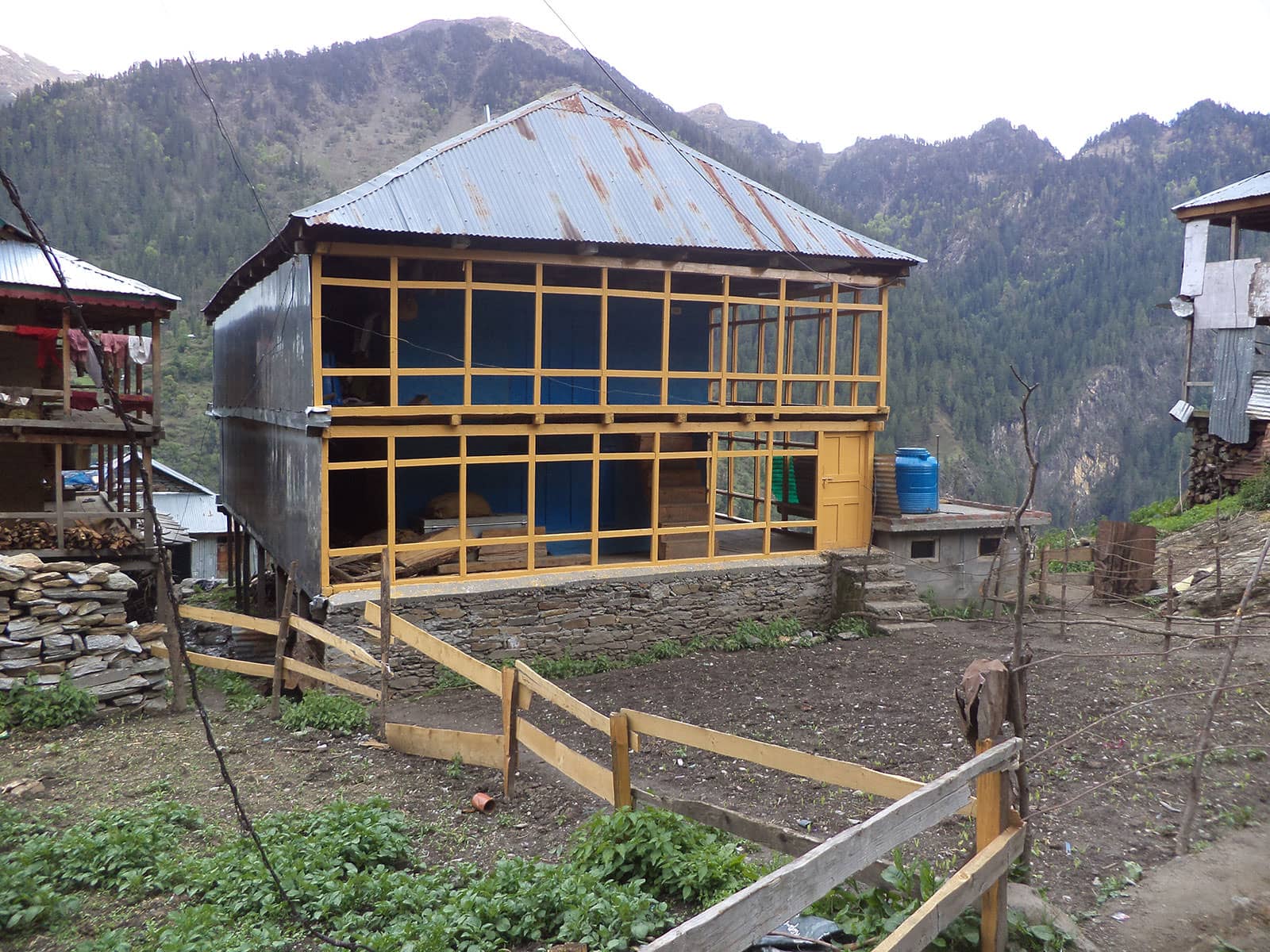
Villagers growing crops in their cottage backyards (May, 2015)
Food Availability
Food items are brought into the village from nearby places such as Jari and Bhuntar. Other than wild fruits and some crops, no other food source is attributed to the village. There is no scarcity of food in any period of a year.
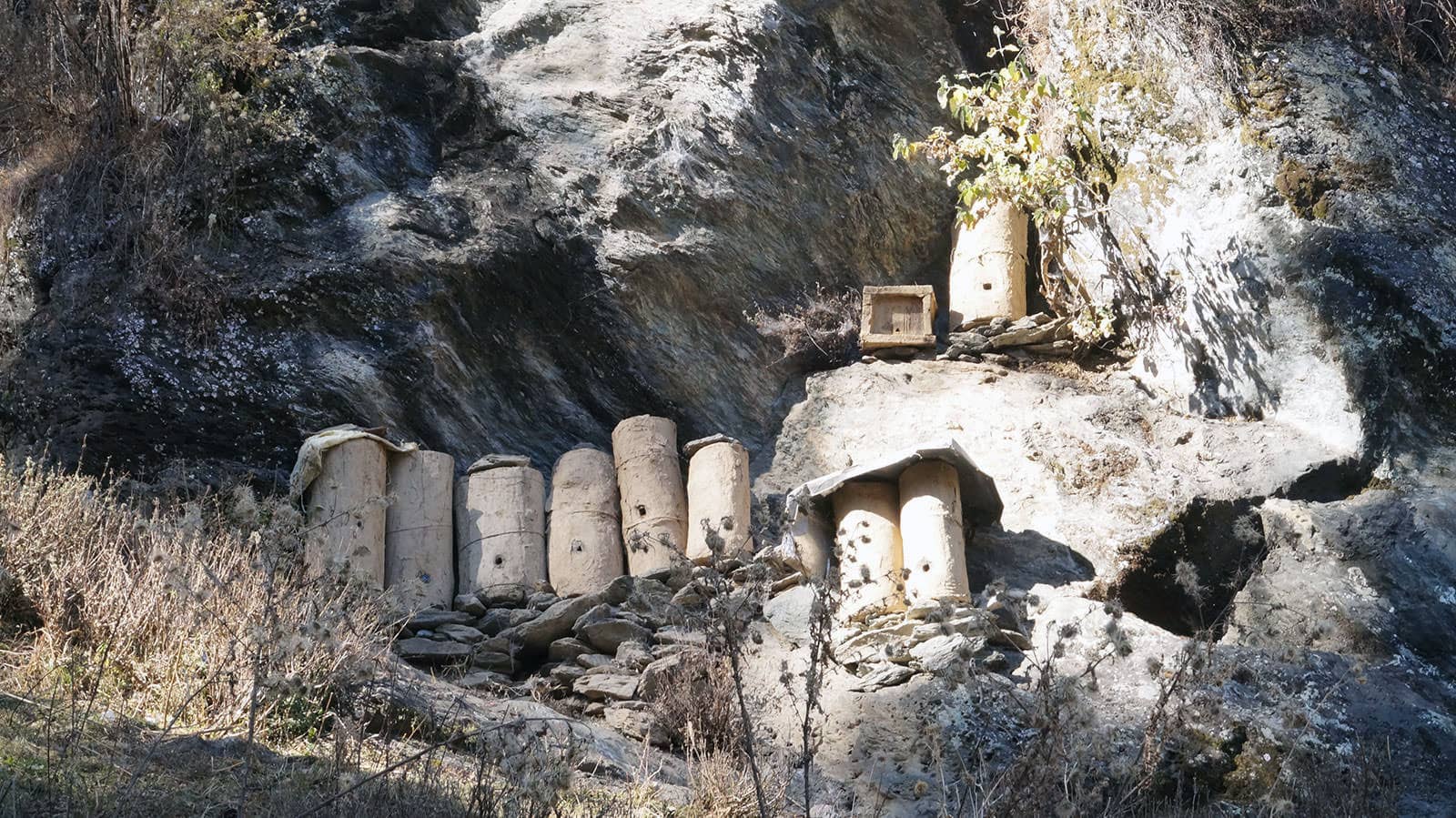
Beehives to harvest honey in the outskirts of Malana (November, 2016)
Diseases
Common diseases are normal occurrences in the village. This includes diseases such as cough, cold, fever, diarrhea, etc. Other diseases such as malaria and diabetes have also been reported in the village.
Migration
People of Malana are known to not leave their village. They can go downhill in the valleys for trade according to the older laws in the village. Marriages in nearby communities such as Rasol and Rumsu are permitted since these communities worship Rishi Jamdagni as their main deity.
The villagers either go to other villages to sell or buy goods to earn a livelihood or to graze their livestock. There are various patterns in which such grazing can take place. Shepherds carry guns and tents along with them to protect from wild animals and harsh weather conditions in the mountains. They graze their sheep at various places and keep moving and return back to the village in a few days. Now, this practice is vanishing fast because the newer generation has found a simple alternative as a source of income than grazing sheep.
This source of income is cultivation of cannabis for which the villagers temporarily shift to their second house near their farms outside Malana village in nearby areas such as the Nirang mountain side, the Magic valley meadow and the Waterfall area patch near the trail to Chanderkhani pass. But, this cannot be counted as migration because this movement is still near the village.
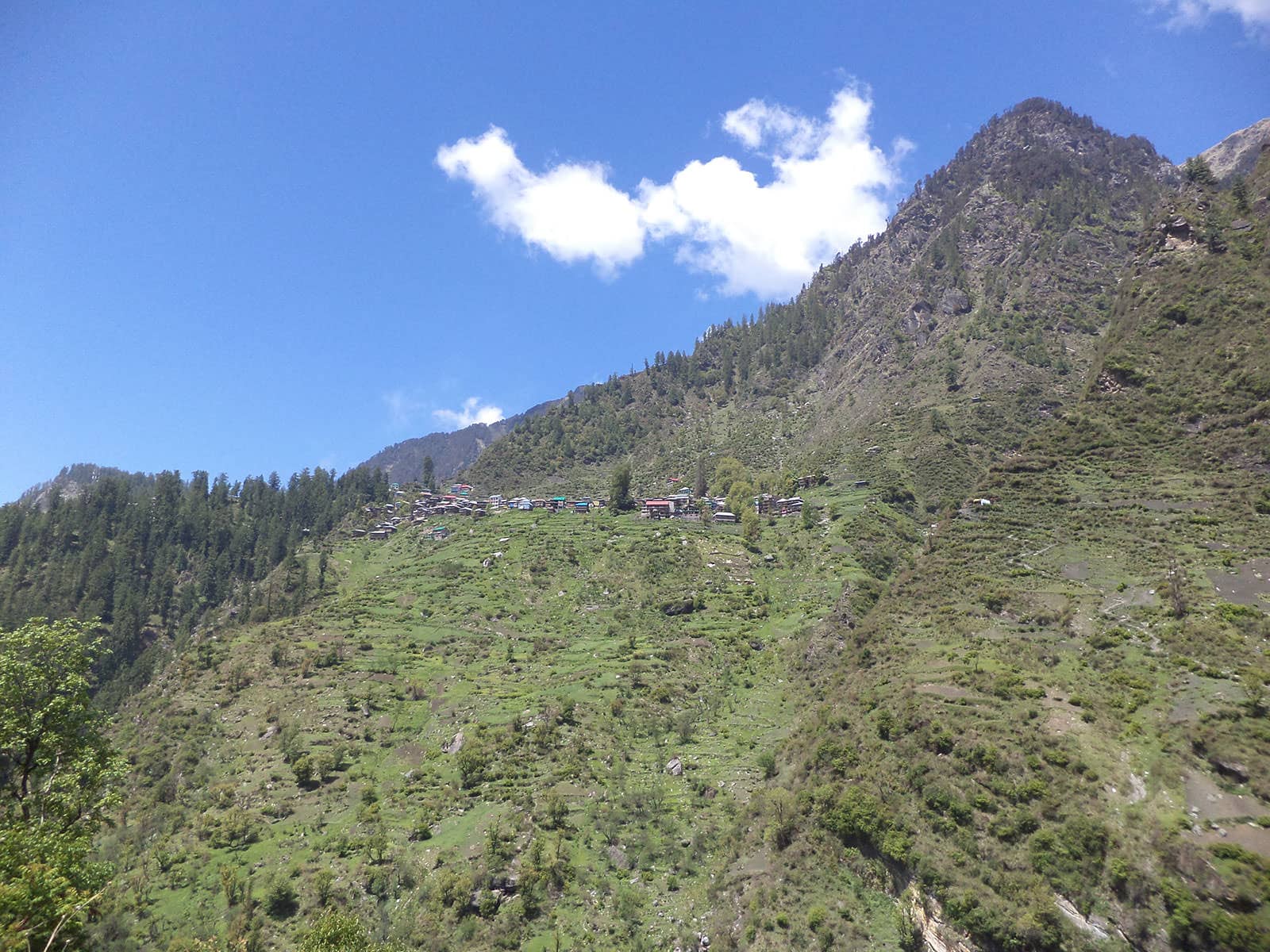
View of Malana village from the Malana taxi stand (May, 2015)
Natural Resources
Land
Being situated on a mountainous terrain, the upper slopes of the village have scanty vegetation while the lower slopes have dense vegetation. The rugged topography and steep slopes have resulted in a thin soil cover. This is restricted only to the gentle slopes around the village.
Very selective crops can grow given the extreme climatic conditions. Hence, the land is not appropriate for large scale agriculture. Crops are cultivated in areas around the village or on nearby mountains. A few pockets inside the village are used as courtyards by the neighboring households where cultivation of certain crops can be found.
People of Malana own land in nearby areas such as Nirang which is the mountain side just opposite to the village and Magic valley which is a meadow about 2 km ahead of Malana near the third dam which is under construction. Most of the land in the demarcated territory of Malana is under dense forestation. Some of it has farms and the remaining has buildings.
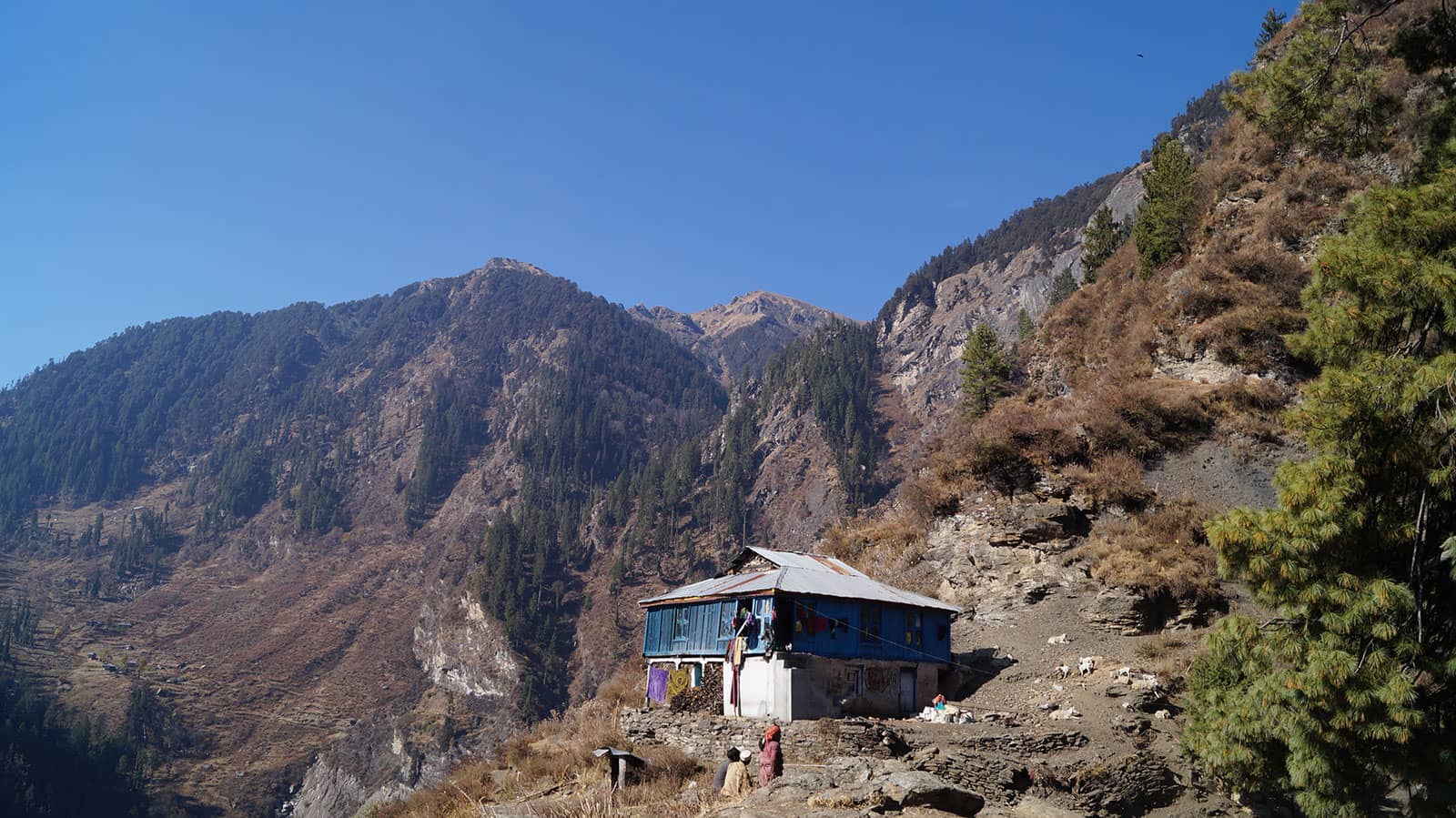
Mountainous terrain around Malana (November, 2016)
Water
Malana nallah is the name given to the stream that flows through the valley at the foothills of the village. Situated about 300 m below the altitude of the village (2652m), it is not used as a source of water supply for basic needs.
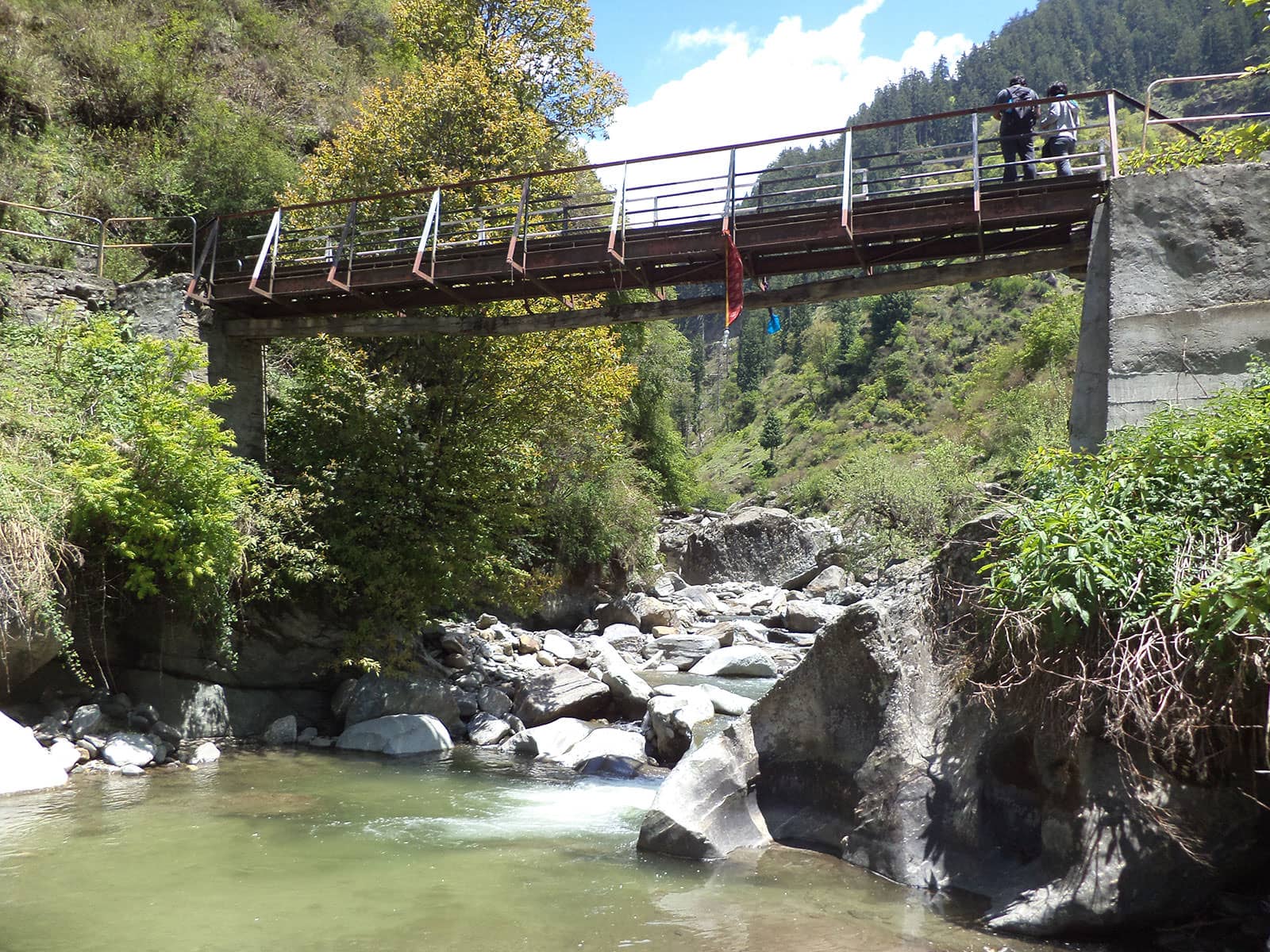
Bridge over the Malana nallah (May, 2015)
There are smaller streams of water that flow around the village from higher areas such as the Chanderkhani pass. These streams are diverted using PVC pipes to about 20-25 points in the village. Many of them have the provision of being turned on with the help of taps.
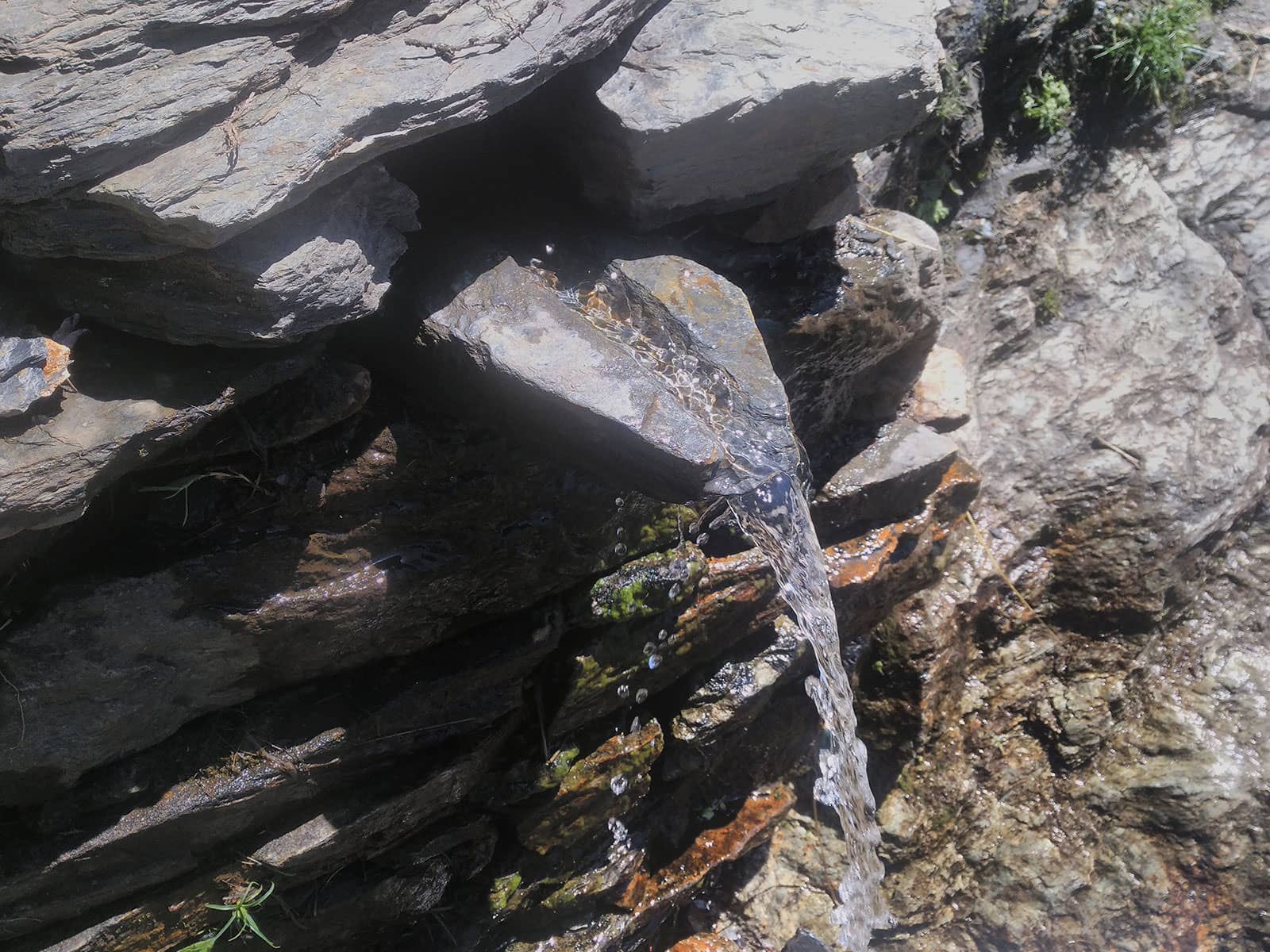
A natural stream of water in the outskirts of Malana (May, 2015)

A tap point inside Malana (May, 2015)
The streams are located to the south-western parts of the village on the route to Chanderkhani pass. Two waterfalls, one in the south-west and one on the north-east also serve as sources of water. These streams flow throughout the year. Water freezes in the winter and causes great inconvenience to the villagers. There are two water tanks in the upper area of the village but are not in use.
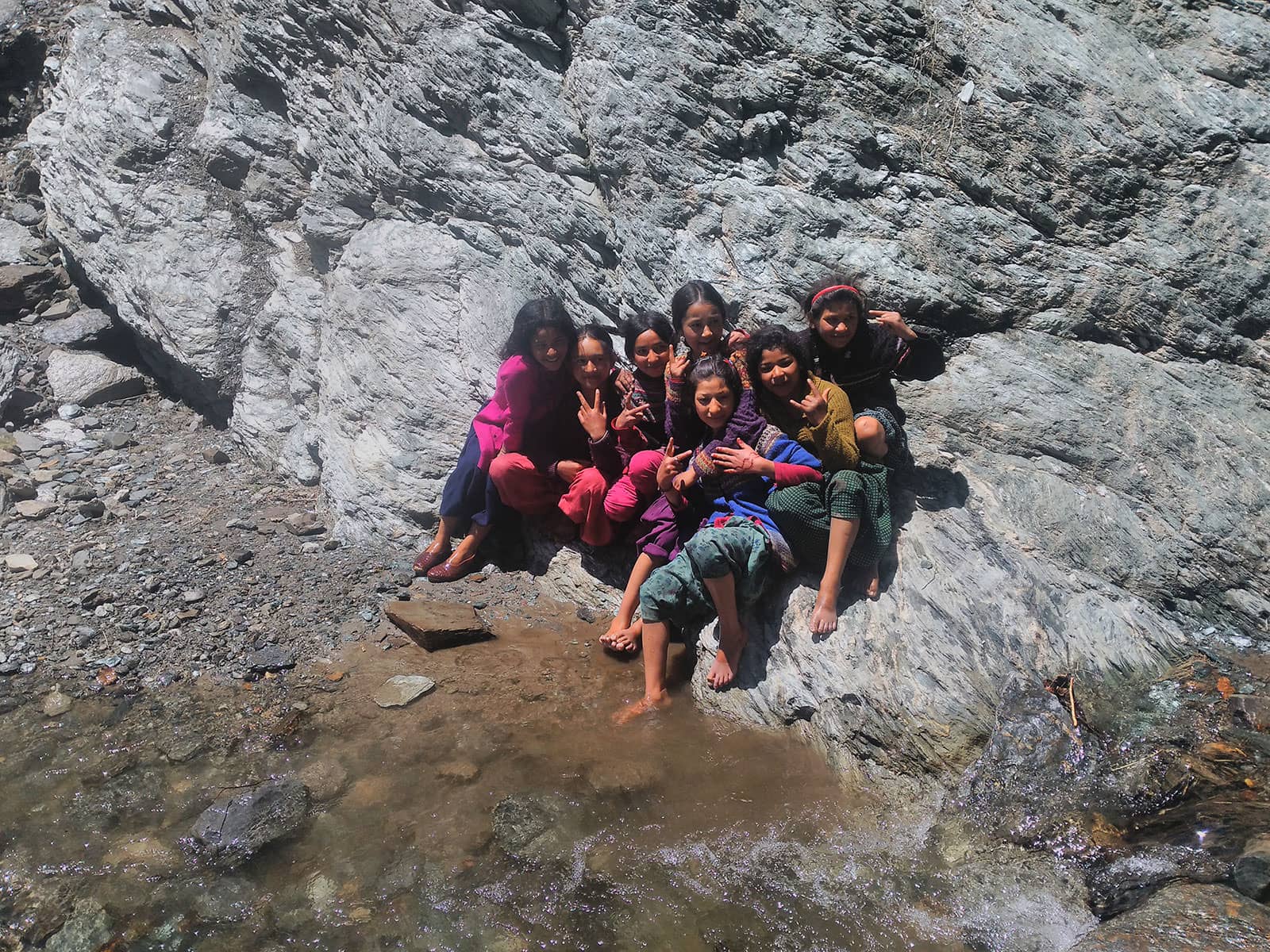
Little girls playing near a stream (May, 2015)
Forestry
The higher slopes are rocky and have scarce vegetation. The lower lying areas are very dense. Trees belong to hard wood temperate species such as Tosh, Kail and Deodar. The villagers collect firewood throughout the year and store it for the winter season when going out in the forests due to extreme climate is a great inconvenience. Diverse Himalayan flora and fauna exhibit the beauty of these ranges. Animals such as musk deer, leopards and the Himalayan black bears inhabit the forests along with a myriad of bird species. Encounters with wild animals are common and usually the shepherds lose their sheep being hunted by carnivores.
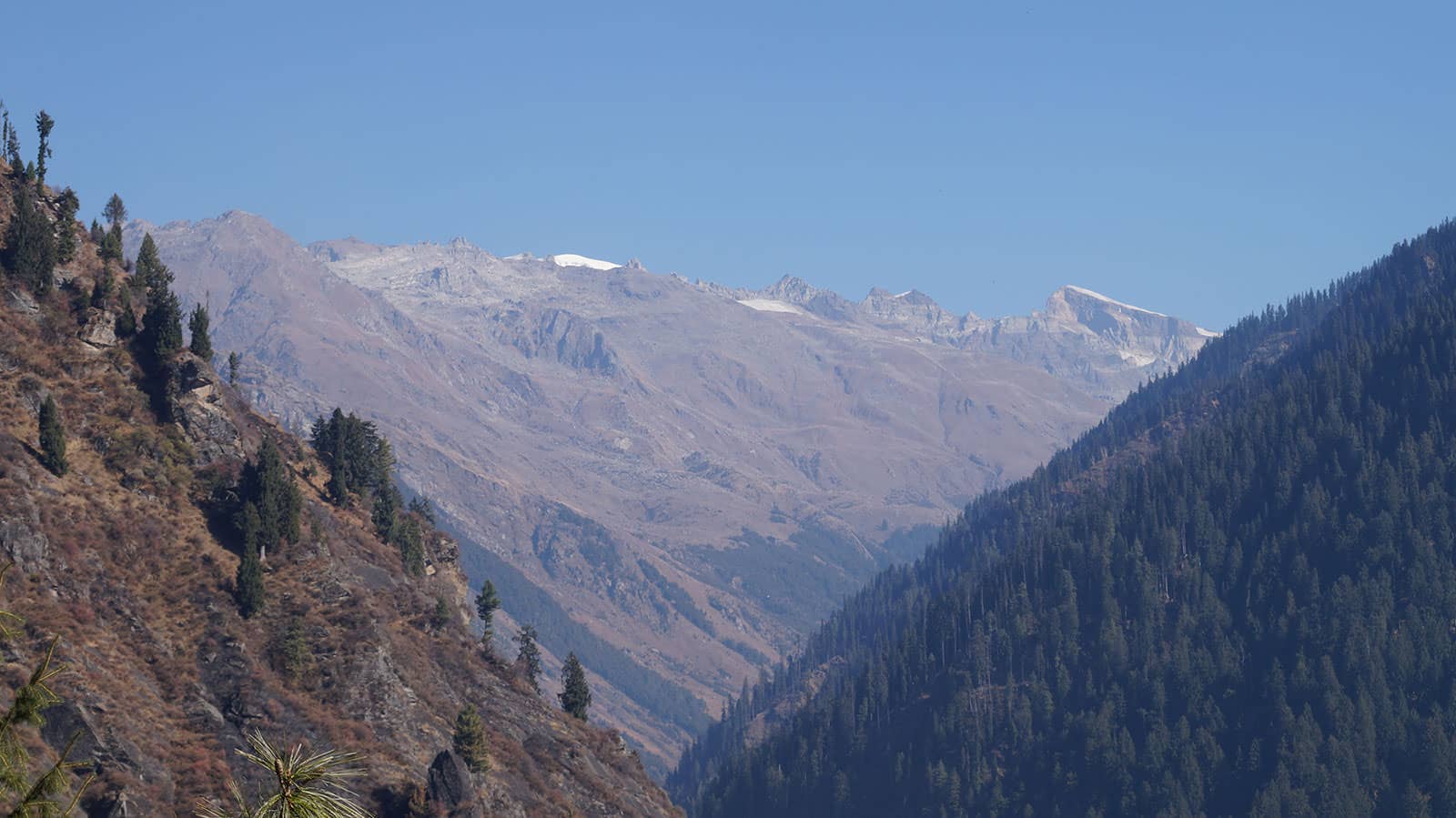
Vegetation cover near Malana (November, 2016)
Infrastructure
Roads
Malana does not have a direct road connecting it with nearby villages. The road is a 'kuchcha' road built for heavy vehicles to access the construction sites of the dams proposed over the Malana nallah. This road is very steep at some places, making it very difficult to drive on.
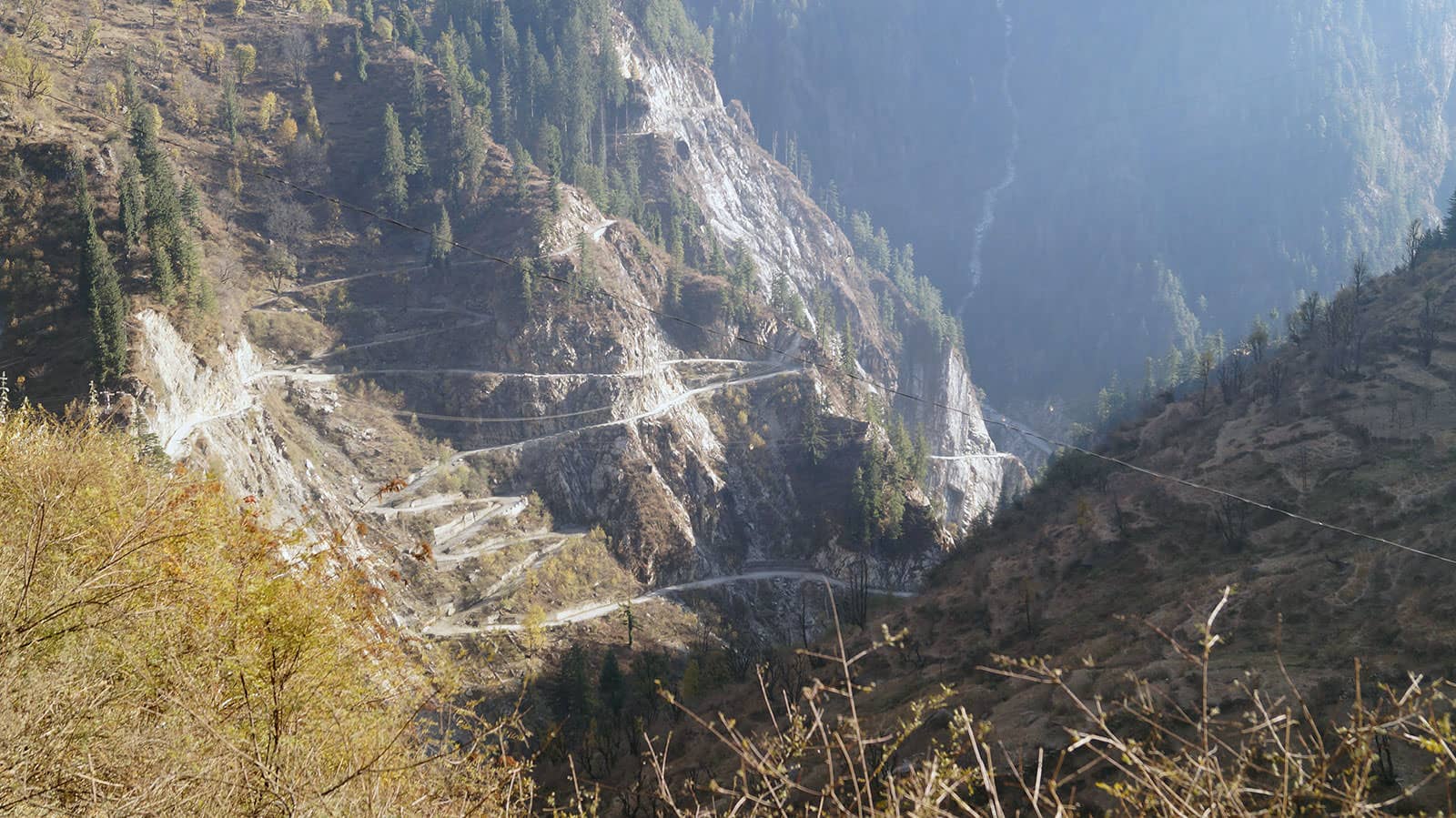
Road to Malana from Jari village (November, 2016)
One must get down at the Malana taxi stand which is on the other side of the valley that houses the village. This place is called Nirang. Then he/she must walk downhill toward the valley and has to cross over the Malana nallah via a steel bridge. Then, a tiring trek toward the village uphill which takes about 90 to 120 minutes would bring the person in the village which is again, situated on a gradual slope.
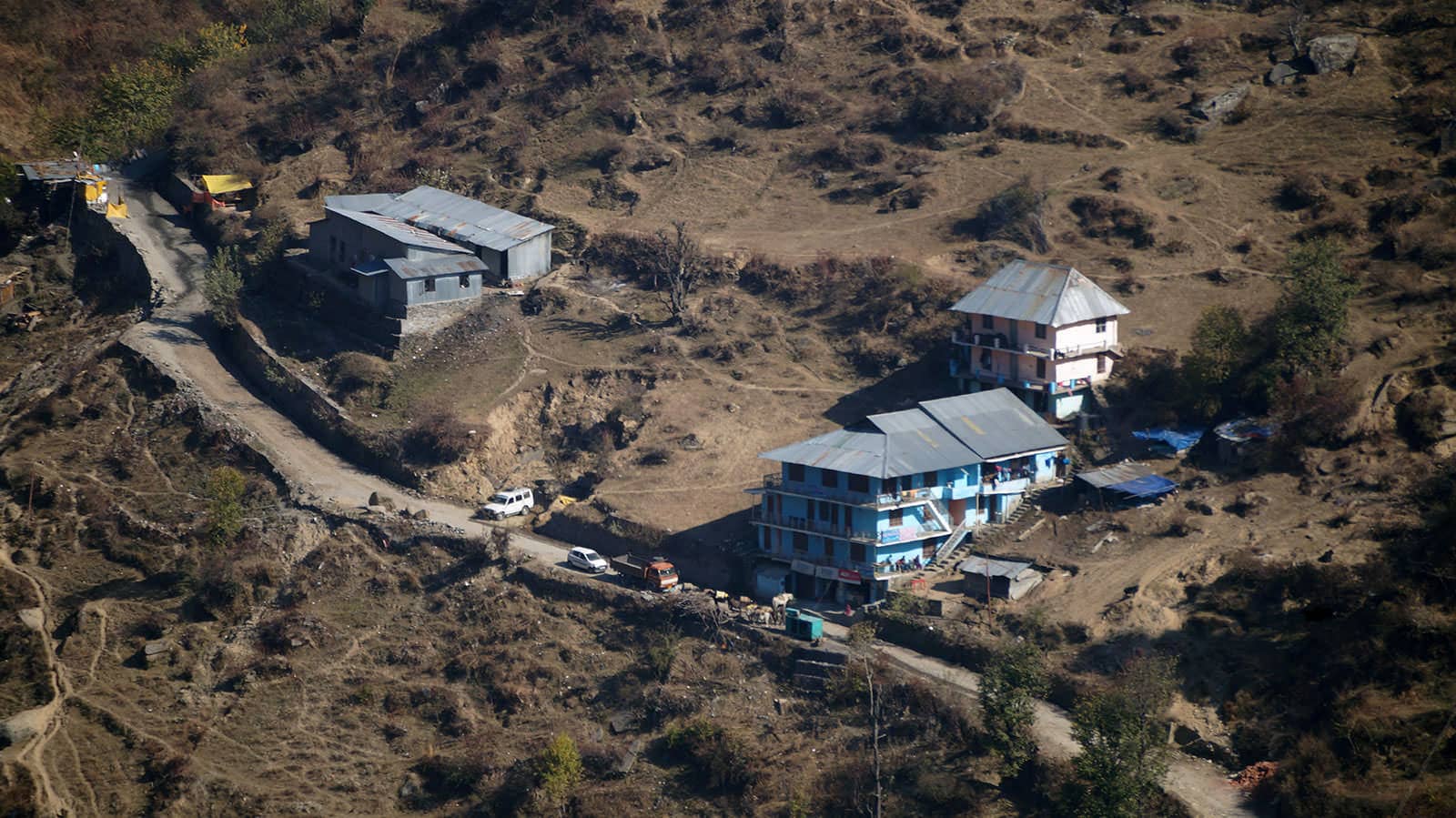
The other side of Malana village known as Nirang (November, 2016)
Inside the village, there is no scope for driving any vehicles or cycles. Concrete footpaths are present at many locations but the rest of the passage ways are all natural soil cover. Footpaths are accompanied by open drains at one side or the center making these walkways extremely unpleasant to walk on. Stone steps have been installed at a few places where walking would have been otherwise been very difficult since the soil layer is thin and slippery.
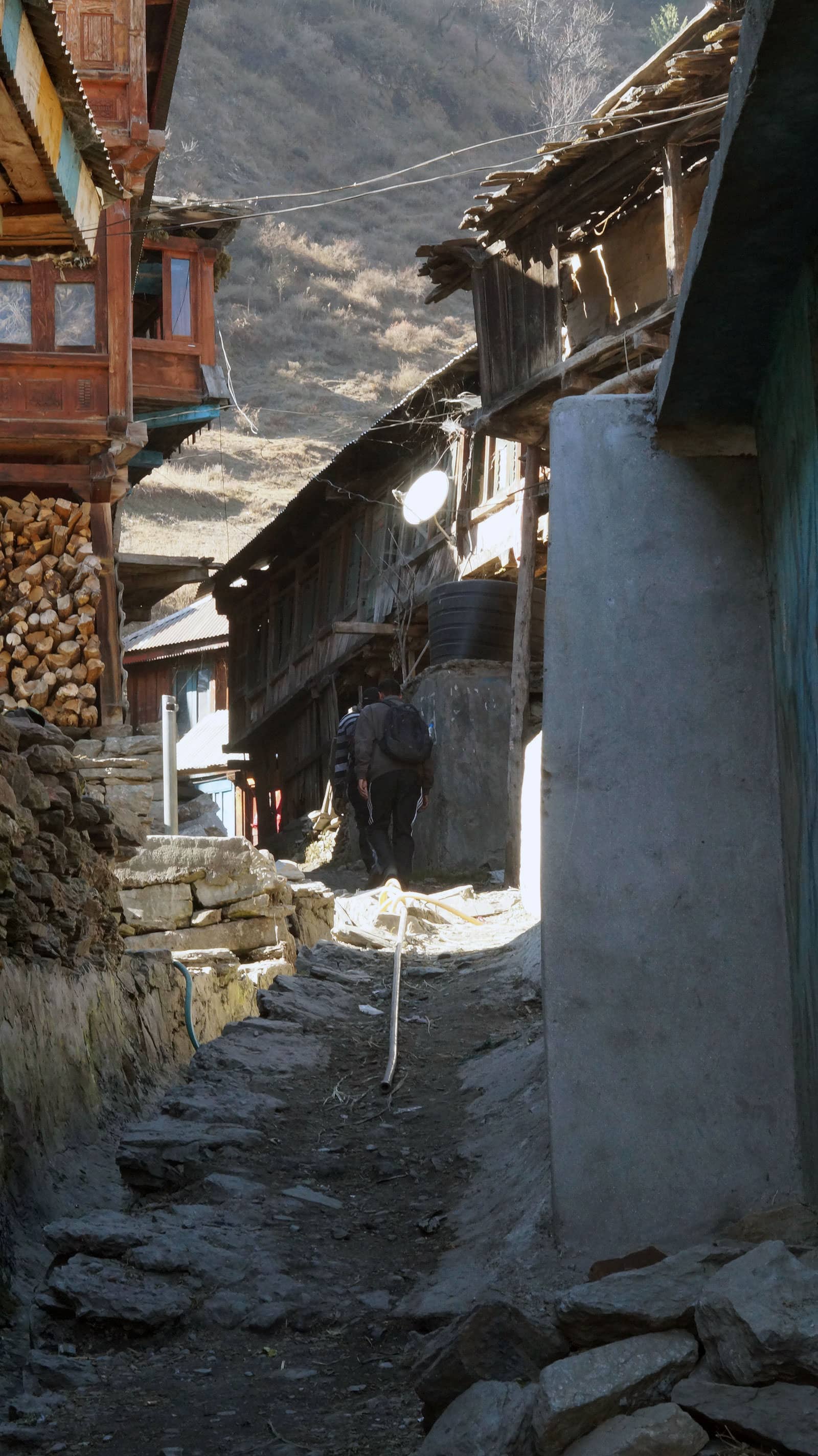
Narrow lanes inside the village (November, 2016)
Electricity
The village was electrified in the mid 1980s. All the buildings have access to electricity. Although it's availability is a major issue in the winters because maintenance of electric poles is a problem in the extreme climate and 8-14 feet of snow.
Drainage
Malana does not have a proper drainage system. Earlier, flowing water would take away wastes along its course downhill. But now, because of non-biodegradable wastes that get stuck in various places around flowing water, the neighborhood is extremely dirty. Water is always flowing which is a relief because water stagnation is not an issue, but, at the same time, it continuously brings wastes downhill and hence, needs to be addressed as a serious sanitation issue.
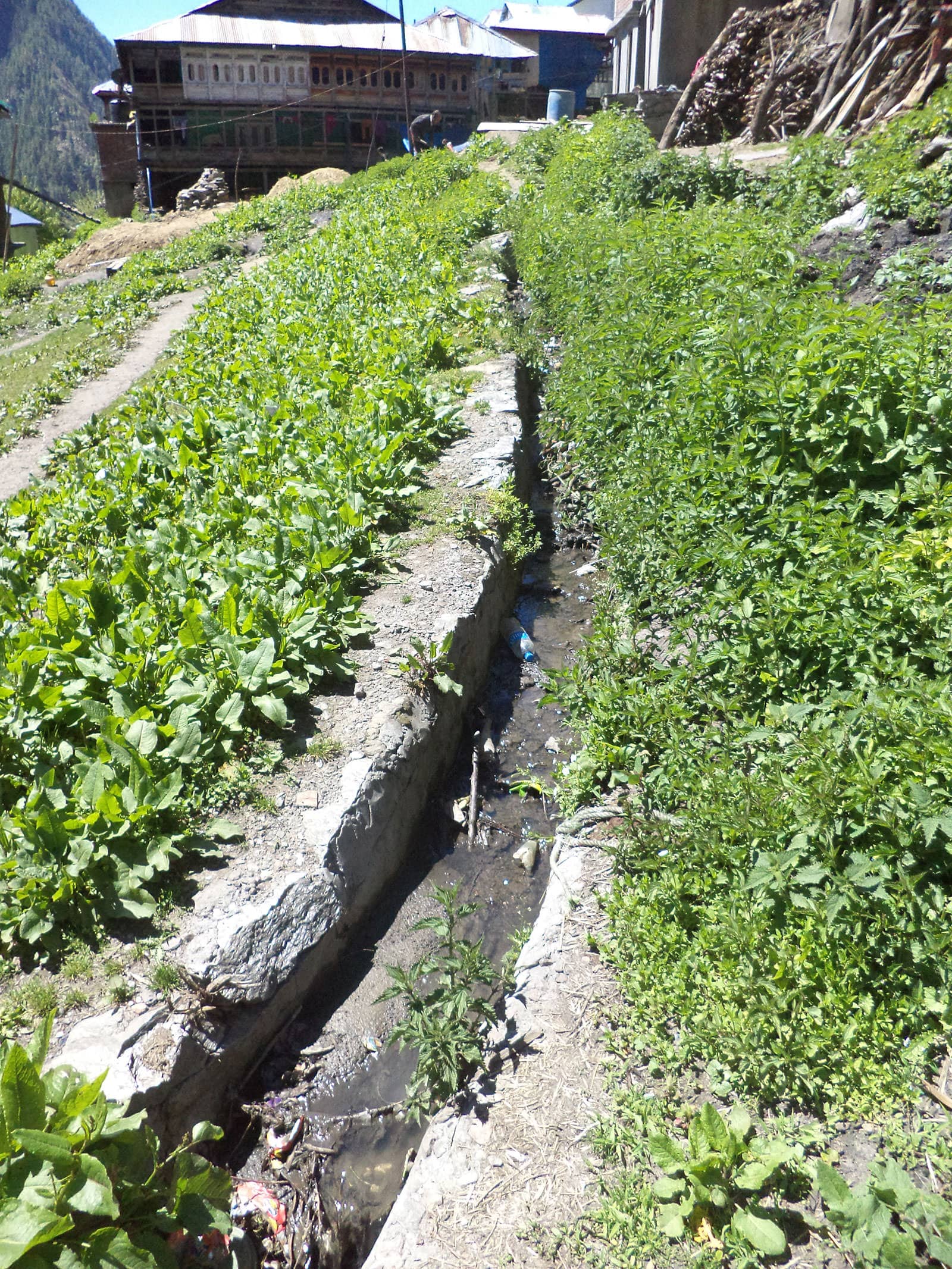
A cleaner drain unlike most in Malana (May, 2015)
Communication
The post office was established in the village long ago in the 1970s. Today, the village has two network providers- Idea and Airtel. Landline service was also available before but mobile phones have become a trend. Almost every individual owns a mobile handset, sometimes even of the latest specifications. Mobile repair and electronic shops are also present in the village. A cybercafe with internet service a few computers were also set up in 2014.
Social Infrastructure
Education
Two schools are established by the government in Malana. One is a pre-primary school and the other is a primary and secondary school (till class tenth). The school buildings have been provided to the govt. on lease by the villagers since they own the land in the immediate vicinity. To pursue higher studies (class eleventh onward), students must be enrolled in colleges in Kullu which is the nearest major town.
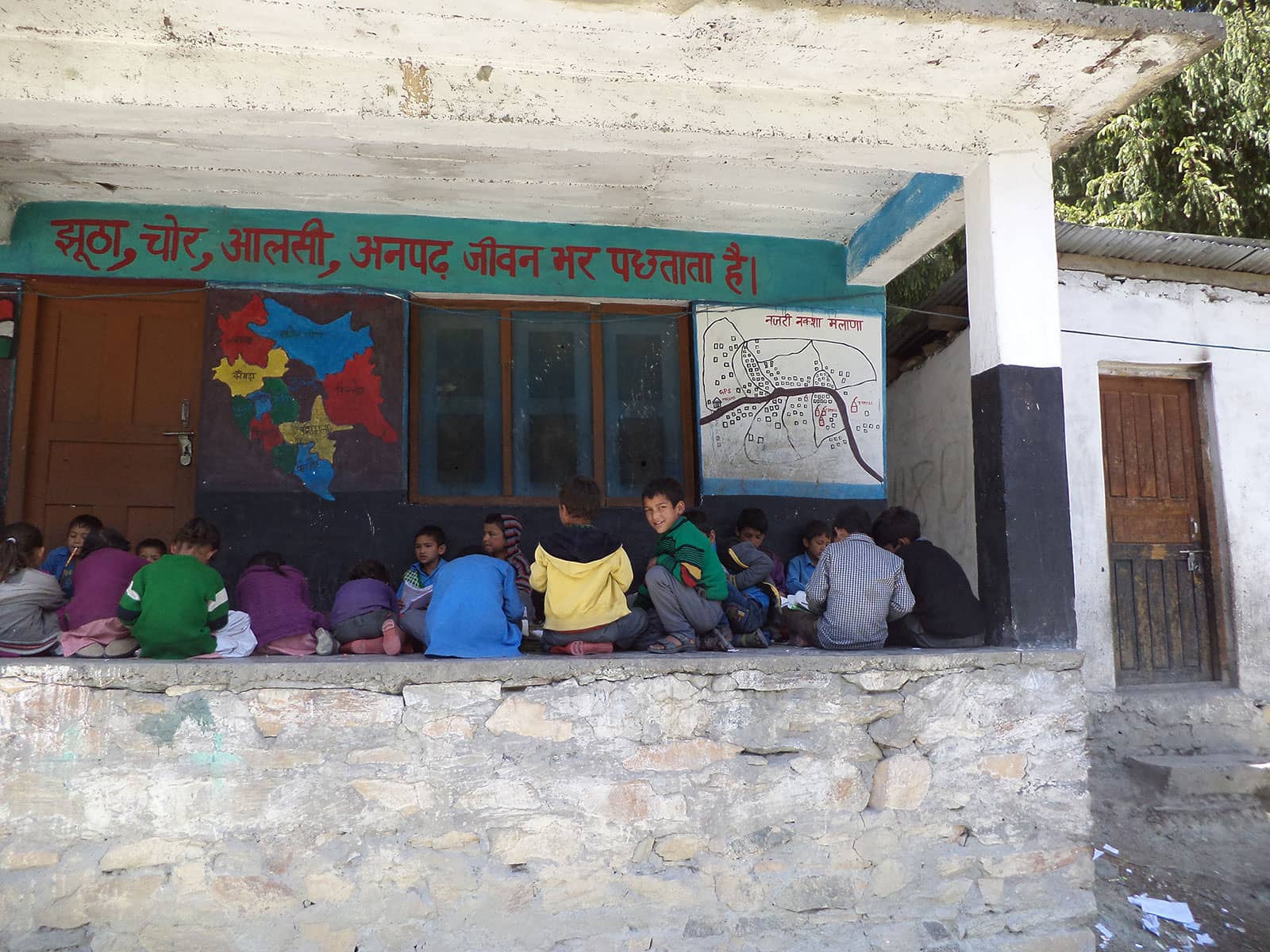
Primary school (May, 2015)
Currently, about 30-40 students study in the pre-primary school and around 175 students study in the primary and secondary school. Four teachers travel to the village from nearby villages such as Jari to teach the kids of Malana. The schools lie on the outskirts of the village to the south and are two separate buildings. Toilet facilities are provided as a different unit for the school nearby. The first floor in an upcoming building in the central square of the village is proposed to house the school. It is under construction now (2016). Its ground floor is expected to provide space for a clinic.
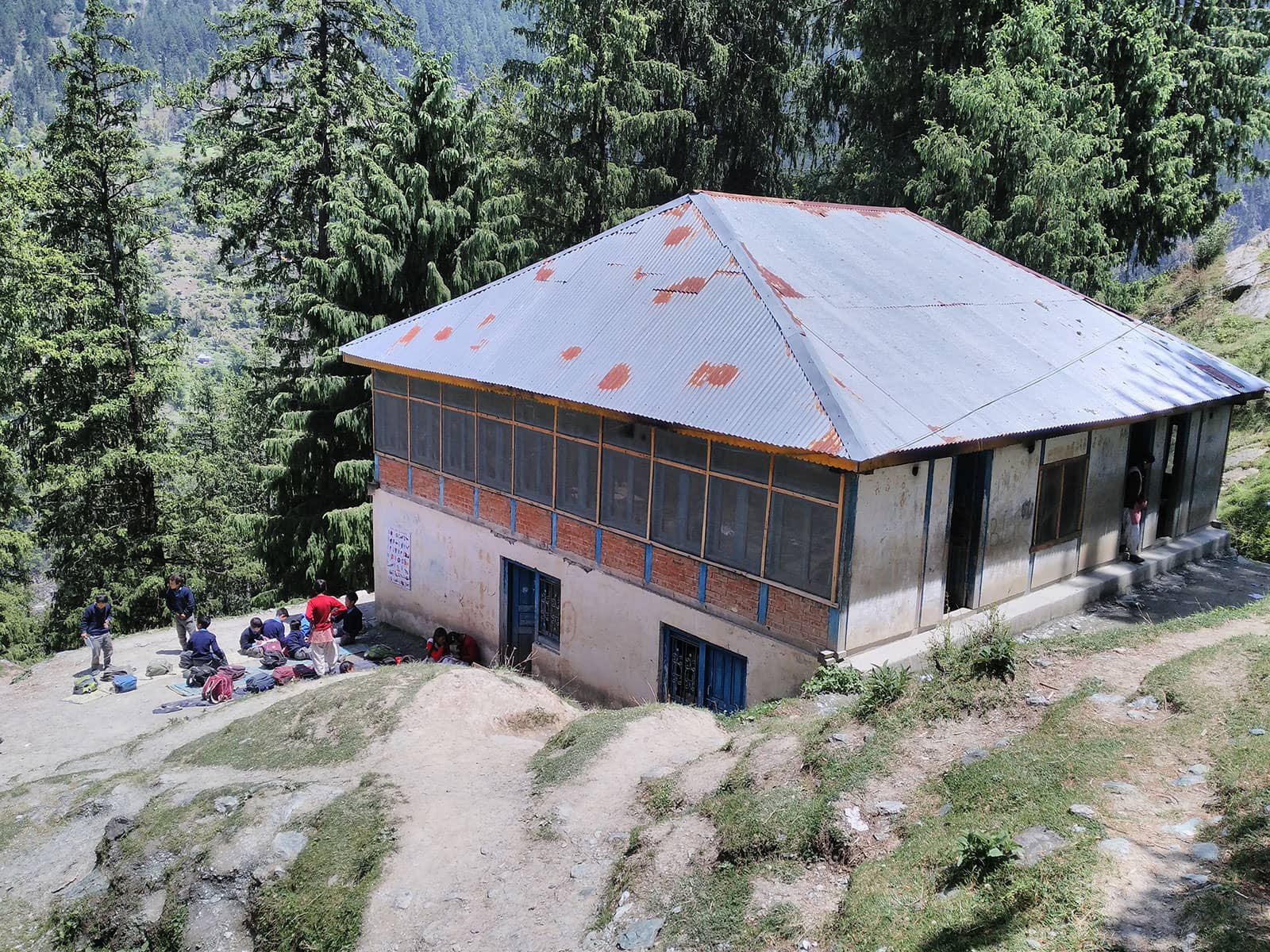
Secondary school (May, 2015)
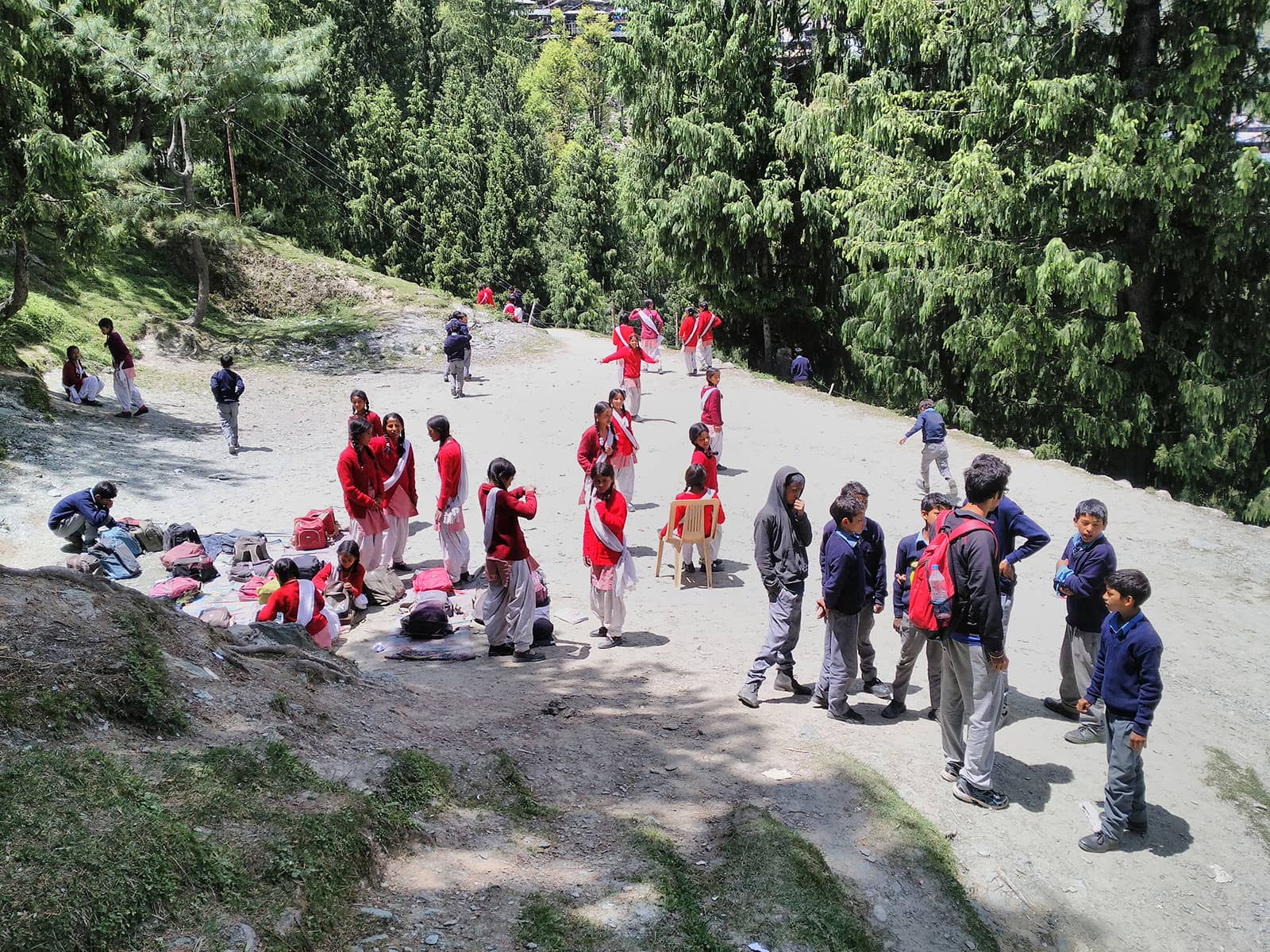
Students of the secondary school (May, 2015)
Health
For the treatment of diseases, villagers have access to a clinic and a medical store in the village itself. More serious diseases can be treated in Jari where better healthcare facilities are available. A new clinic is being built in the central part of the village which is proposed to be bigger in size and will offer better facilities than the older one.
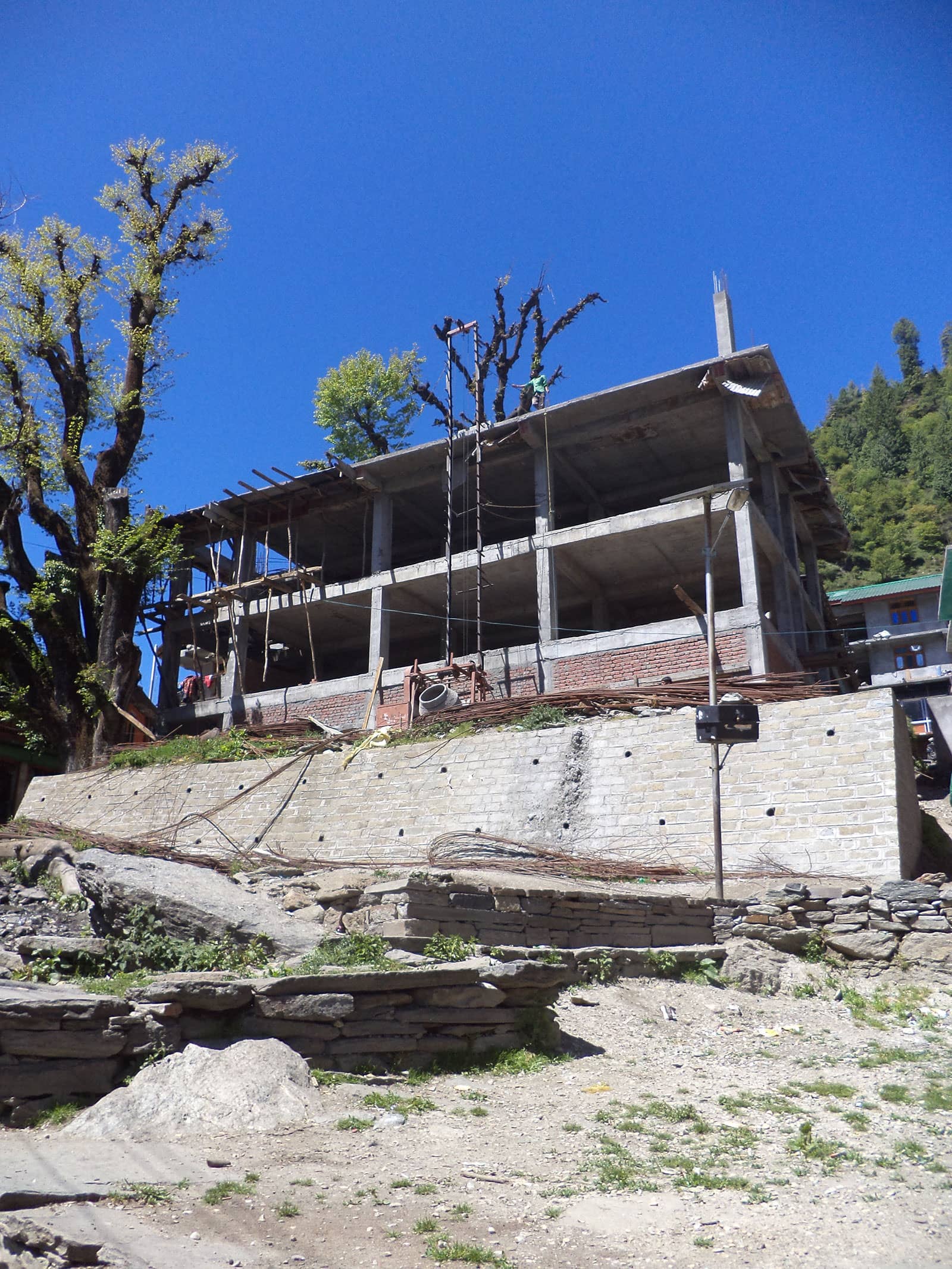
Construction of a new building near the temple complex with school at the top and clinic on the ground floor (May, 2015)
Defecation
Under the "Himmothan Pariyojana Extension-HP, Phase-III", a Water and Sanitation (WATSAN) intervention was initiated in 2011 in many villages including Malana. Toilets were installed in the village and then villagers started following the trend of building toilet blocks outside their houses.
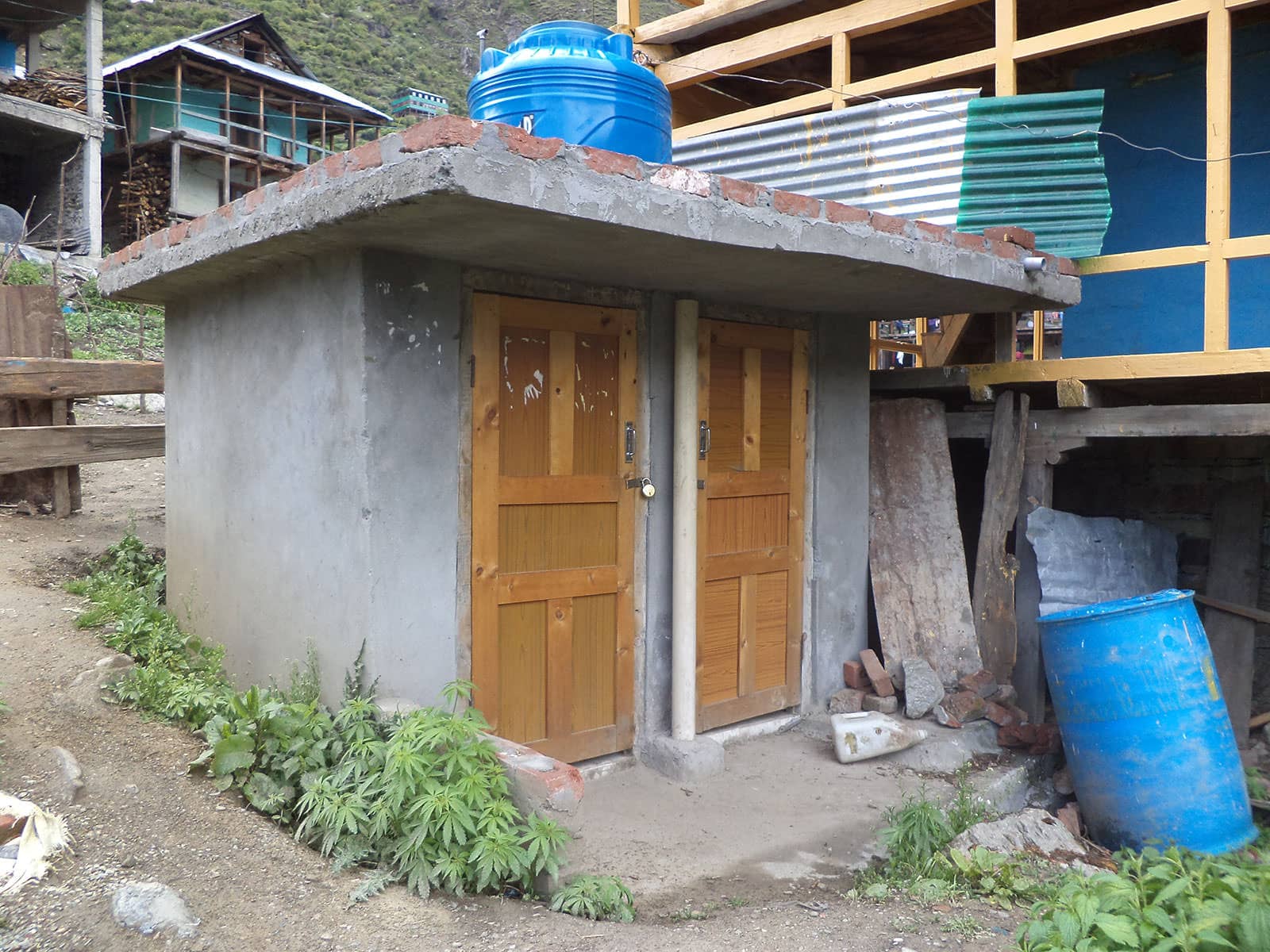
Twin pit toilets installed recently (May, 2015)
Drinking Water
There are smaller streams of water that flow around the village from higher areas such as the Chanderkhani pass. These streams are diverted using PVC pipes to about 20-30 points in the village. Many of them have the provision of being turned on with the help of taps.
These water points also act as places where drinking water is collected. Concrete platforms can also be seen built around such water points. These water points often play the role of community spaces where women can be found chatting, washing clothes or cleaning utensils.
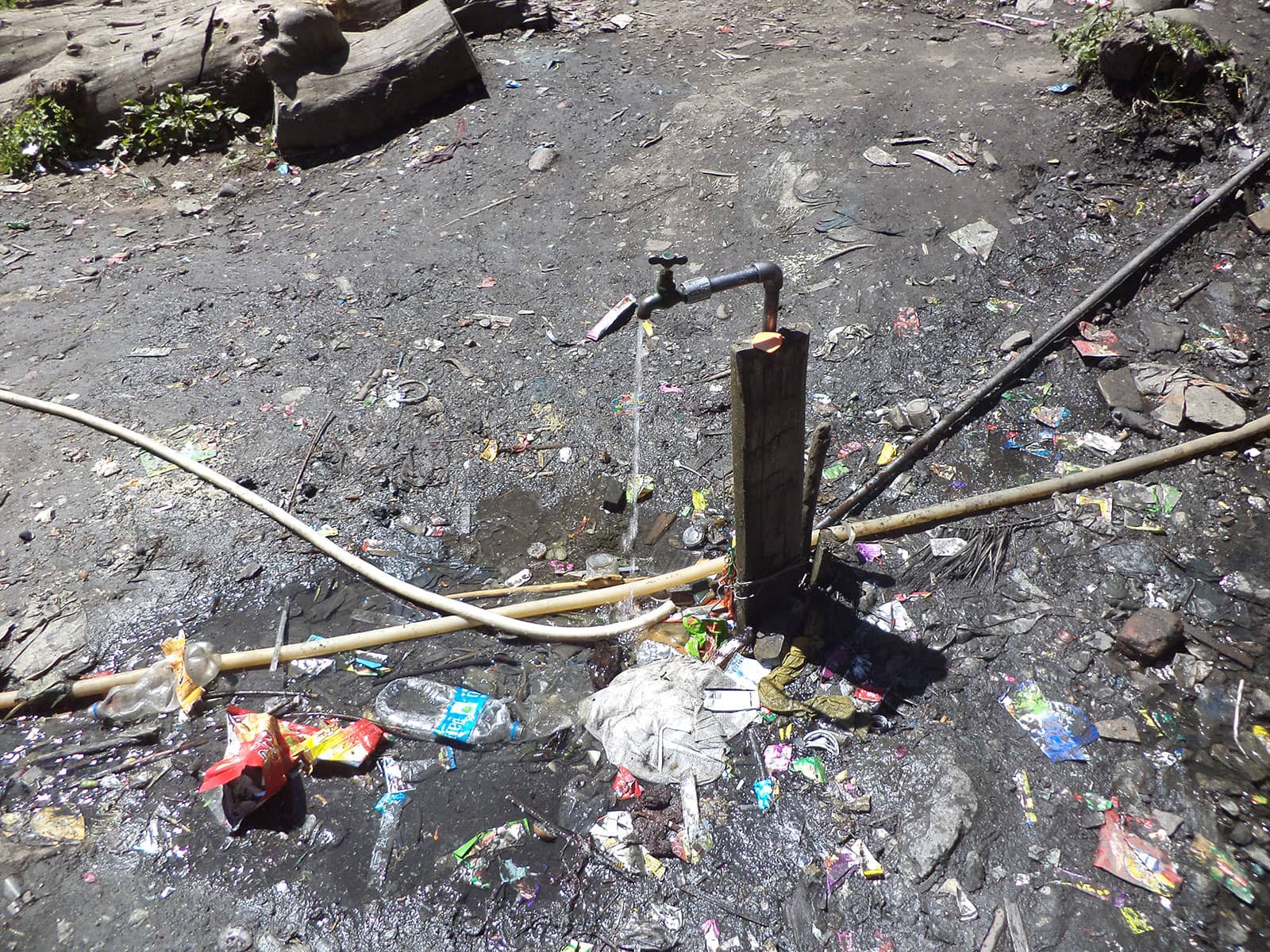
Water tap point in the middle of the village (May, 2015)
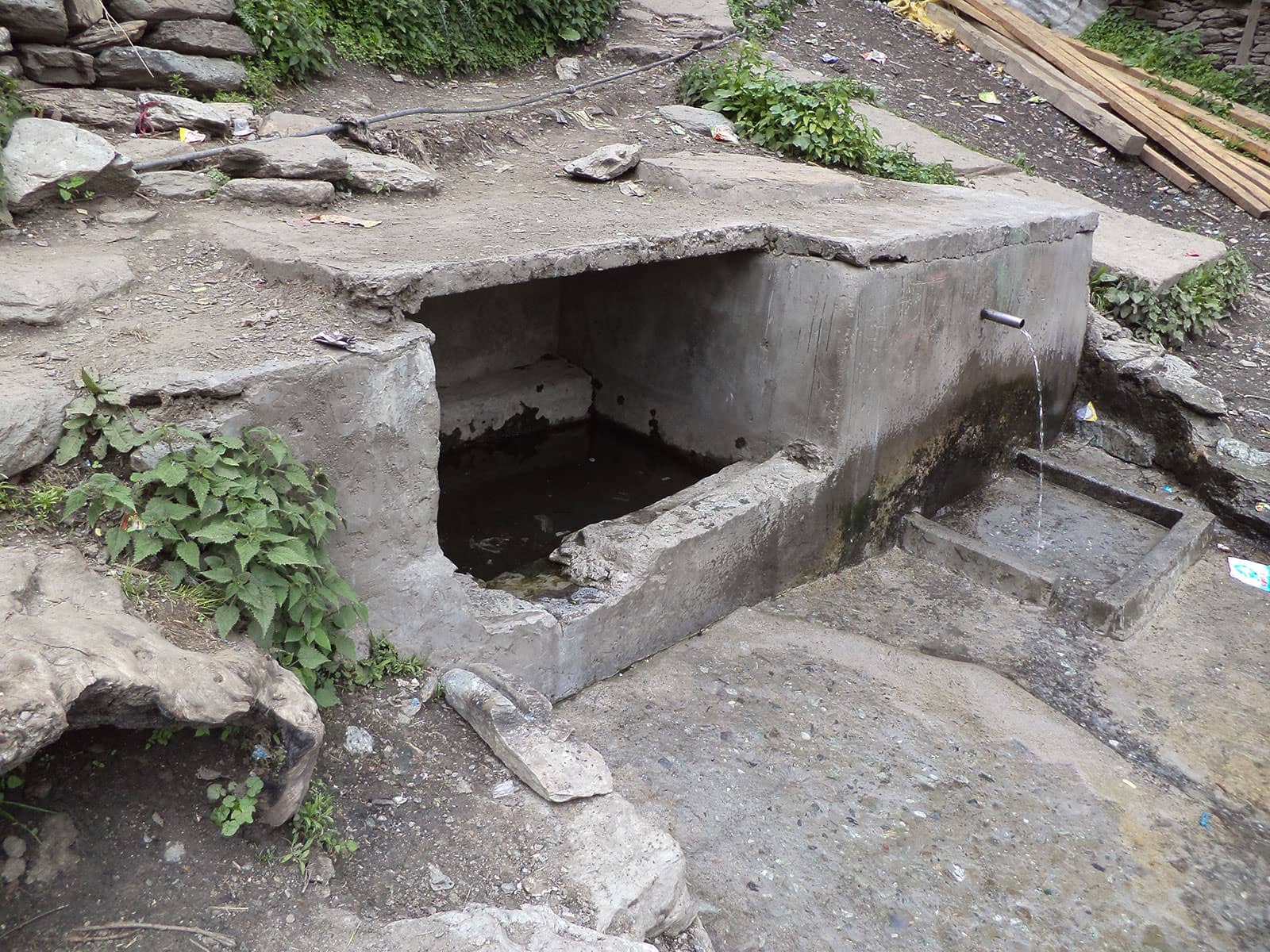
Water point at the northern edge of the village (May, 2015)
Cultural Places
Malana has a Temple complex in the center of the village where a temple is located for the worship of the main deity- Rishi Jamdagni or Jamlu Devta. In this main temple, food is also stored which is given to the priests as an offering for their services.
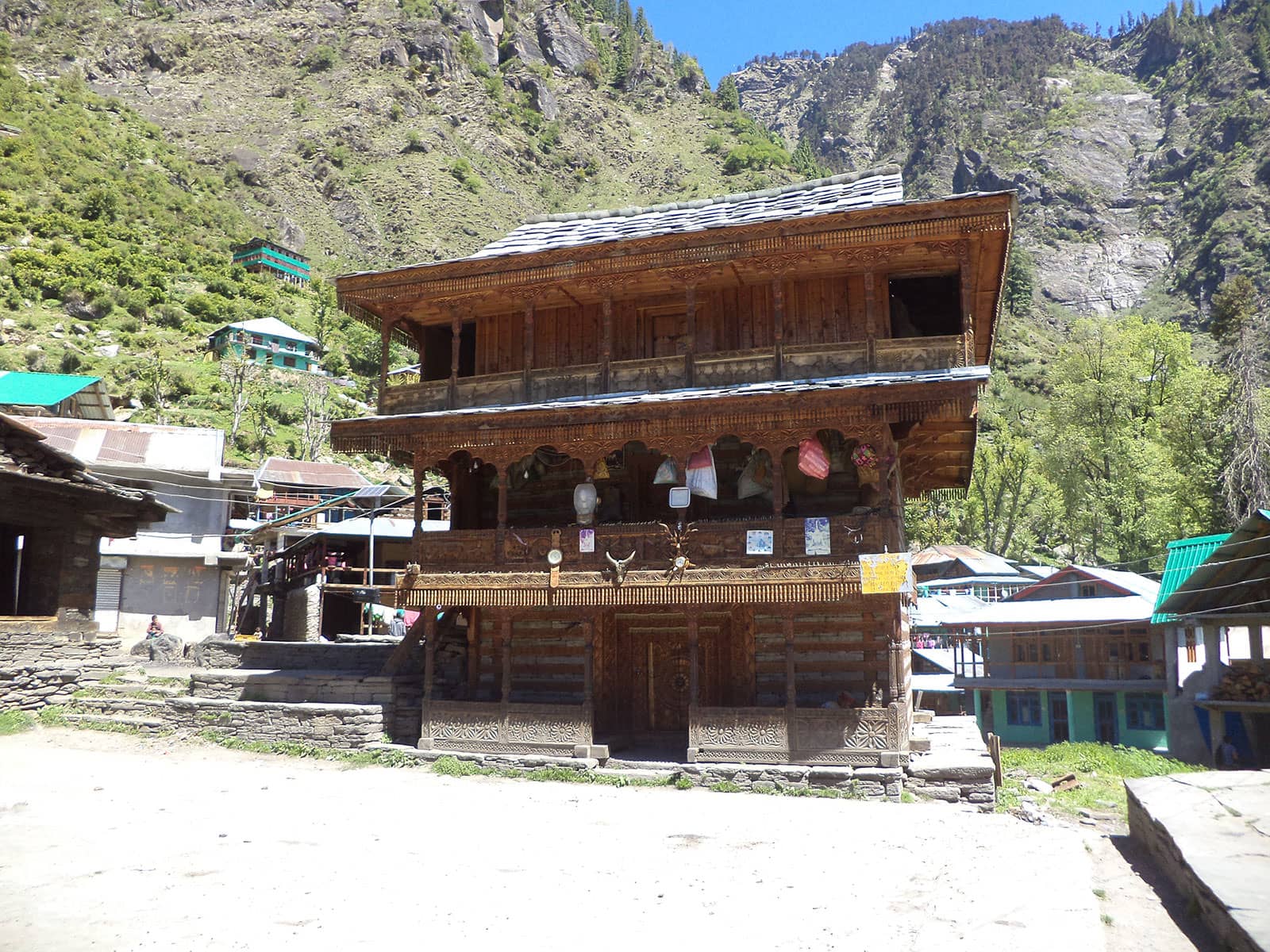
Main temple of Rishi Jamdagni in the temple complex (May, 2015)
Along with the temple, a Dharamshala is present. Villagers call it their parliament where the Gram Panchayat sometimes hold meetings. Members of the Gram Panchayat have discussions here. A second Dharamshala is constructed for lower caste people from nearby villages as a place to stay during festivals.
A central courtyard in front of the temple contains a small patch of lawn which is believed to be grown there by Parshuram- an avatar of Lord Vishnu and son of Rishi Jamdagni and Renuka Devi. It is believed that this patch of grass marked the beginning of the village. Nobody can enter this patch of lawn and a heavy fine of Rs. 2500 is charged to offenders, including the villagers.
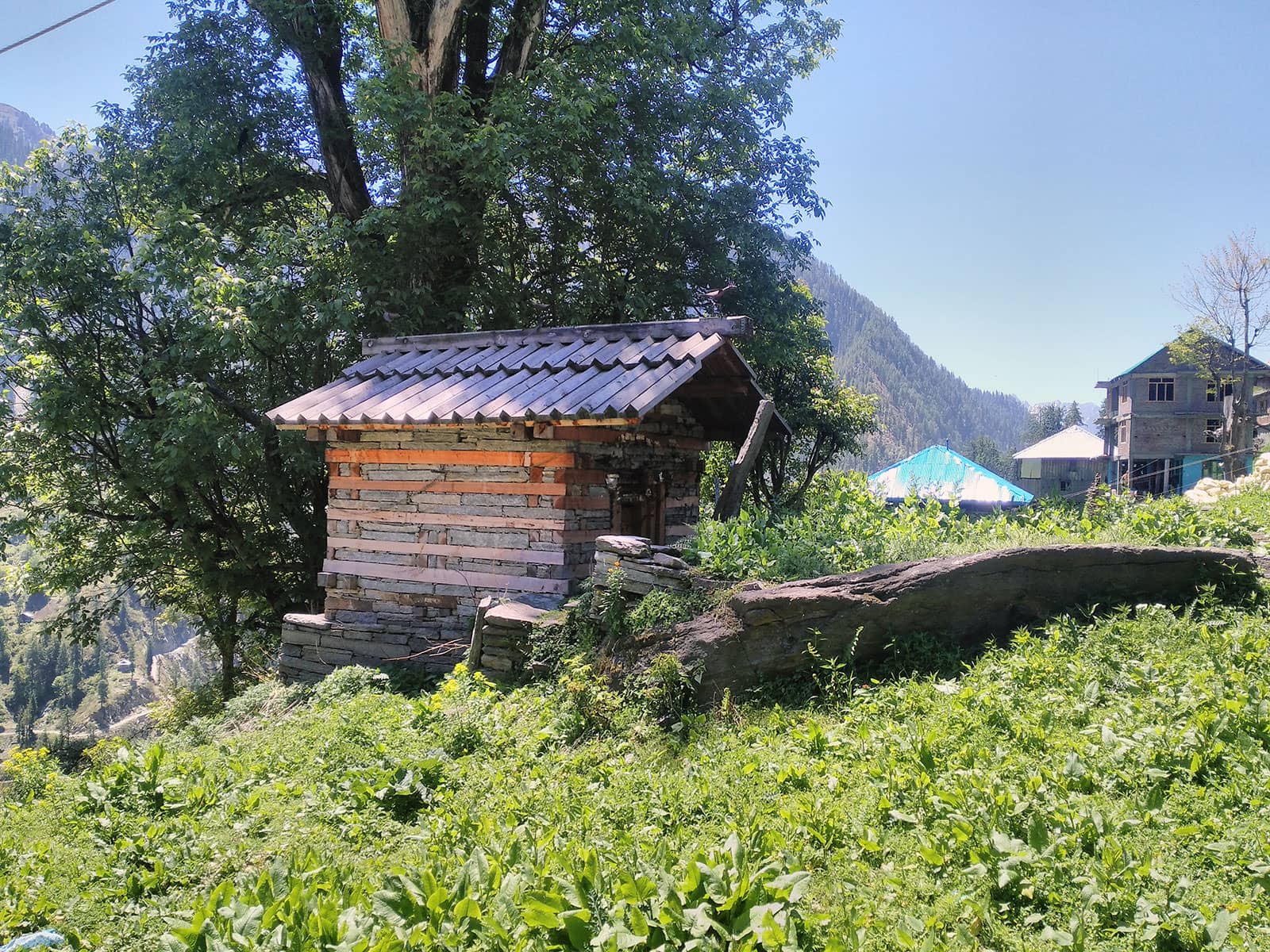
Temple of Renuka devi (May, 2015)
On the other side of the courtyard is the Lower court of the village. It is a raised platform made of stone and covered with concrete where disputes are resolved amongst the villagers. Visitors are not allowed to enter this place and even the villagers are required to remove their foot wear before entering this platform.
Opposite to the platform is a stepped area leading to pathways heading different directions inside the village. Also, another Dharamshala stands near the central courtyard which is used by the family of a deceased person to stay till the final rites of the dead person are performed.
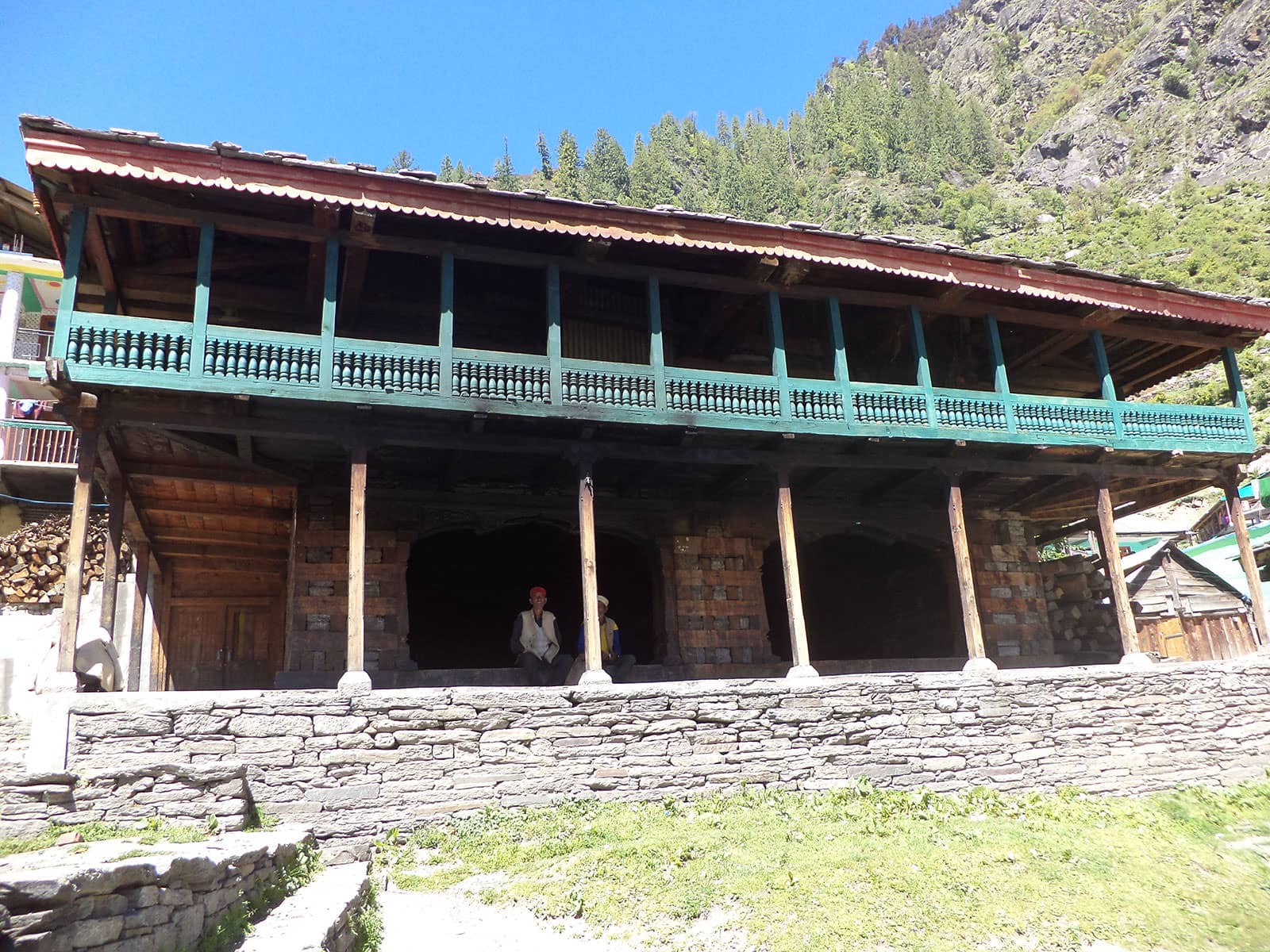
Dharamshala for the relatives of the deceased to rest (May, 2015)
Recently, in 2016, an amphitheatre has been built in front of this temple complex, next to the lower court. A stepped seating area and an open ground have been placed here for the inhabitants of Malana to celebrate functions such as marriages or other get-togethers. This place was earlier a dumping ground on which stones were piled up and soil was used as a cover to construct an open ground.
Other cultural places include the house of the Pujari (main priest), a shrine to Rishi Jamdagni near two huge Deodar trees in the north, a temple to Renuka Devi in the north-eastern part of the village. There is a twin temple located in the northern part of the village whose roofs are joined. One building is dedicated to storing treasury and goods belonging to Rishi Jamdagni such as musical instruments used during festivals. The other one is a sanctuary to the same.
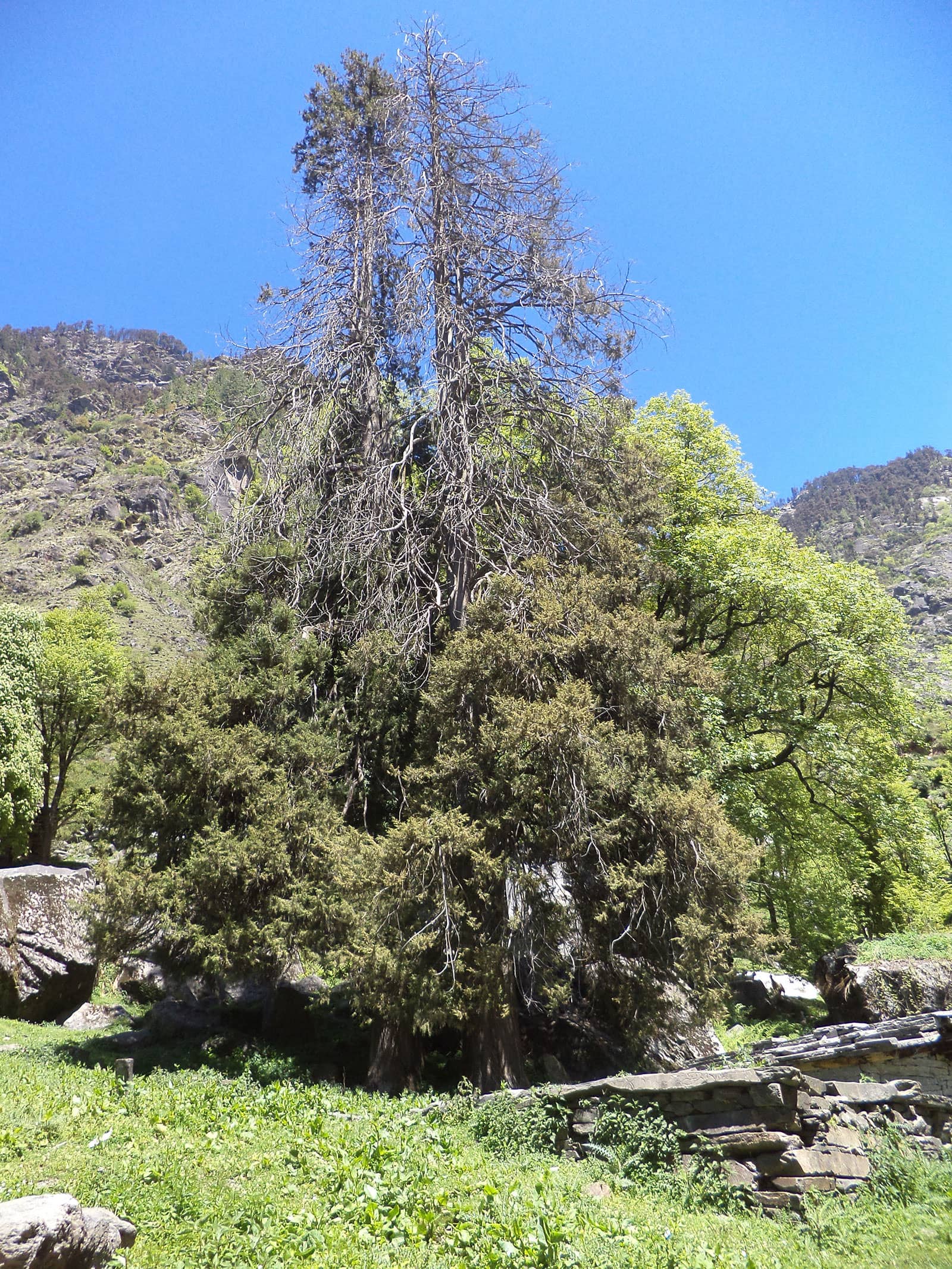
Shrine of Rishi Jamdagni near the two holy Deodar trees in the northern part of the village (May, 2015)
The main temple and the twin-temples were burnt along with around 150 houses during the electrical fire of 2008 and were rebuilt in 2009 by craftsmen of nearby areas. Although the older proportions were retained during reconstruction, spectacular craftsmanship can be seen on the facades of these temples which were not present earlier.
In the southern part of the village at one of the highest points of the village, is a huge Deodar tree. Next to this tree are a few rocks where goat/ sheep sacrifices are made during festivals. From this location, the entire village can be seen.
For the people of Malana, all the cultural sites belong to Rishi Jamdagni and no individual owns these areas.
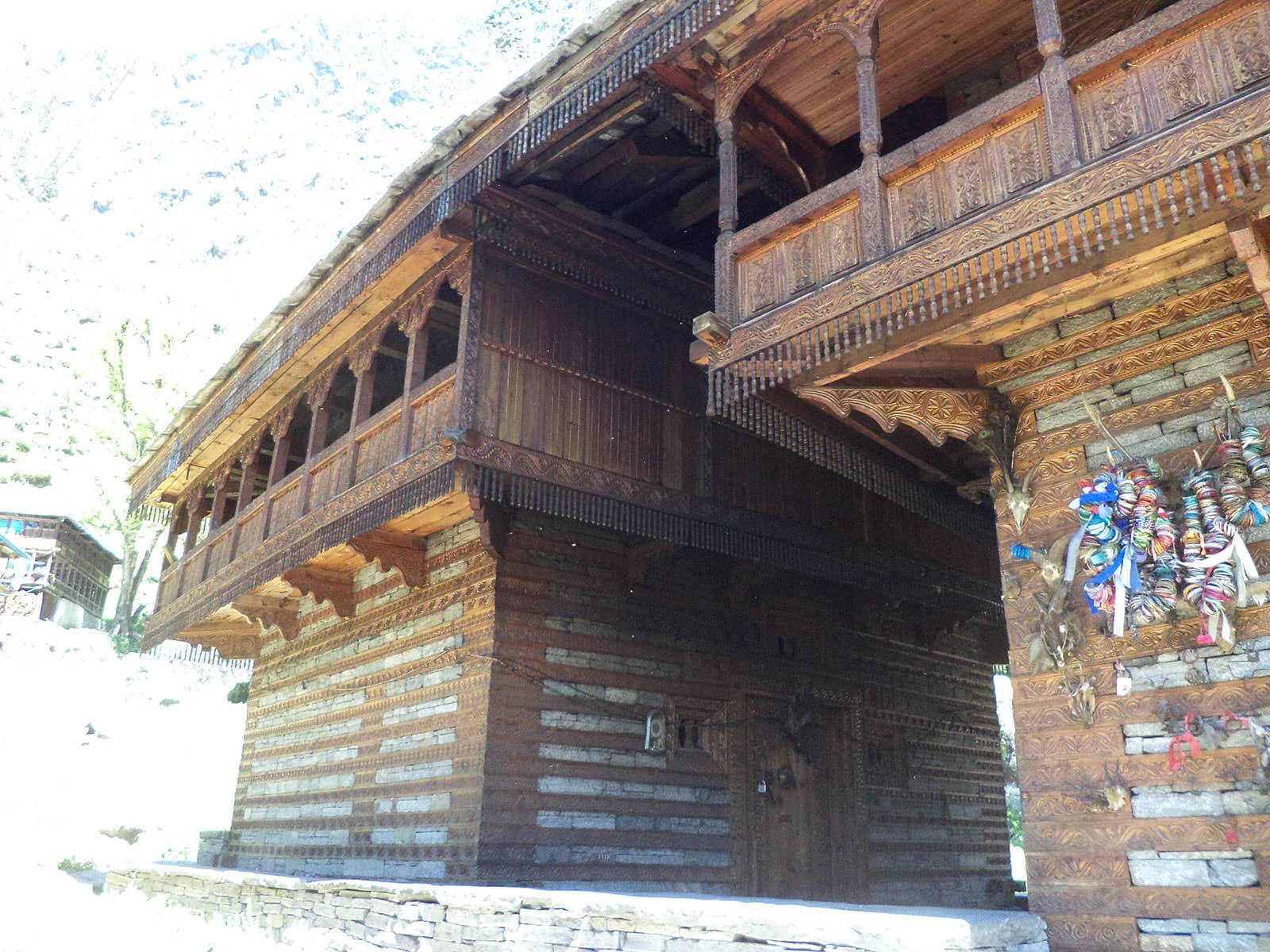
Twin temples of Rishi Jamdagni. The building to the left is used as a treasury of the God (May, 2015)
Micro-enterprises
There are several small shops set up by the villagers in Malana. Most of them are along the route that trekkers use during their walks through the village. These include an electronics shop, a small video game parlor, a newly setup cyber cafe, and the rest are grocery shops out of which two big ones lie immediately next to the new three storey building that is proposed to include the clinic and the schools near the temple complex and the open ground amphitheatre.
Also, there is a ration shop near the open ground next to the amphitheatre where the locals can obtain food grains at cheaper prices.
Bank
There is neither a bank nor an ATM in the village. The nearest banks are in Jari- Punjab National Bank and Canara bank. There is a Debit card swiping machine available for tourists in a newly set up cyber cafe where money in cash can be obtained after paying a fee.
After the introduction of the new Rs. 500 and Rs. 2000 notes, majority of villagers travelled to Jari to exchange the older notes for newer accepted ones. This also led to many villagers opening bank accounts for the first time.
Transport
Concrete steps have been installed at many parts of the trek toward Malana from the Malana taxi stand and also inside the village.
A trolley service was installed in 2013-14 for villagers to transport goods from the taxi stand to the lower part of the village at a nominal fee. The trolley is called 'Spen' in the village and can carry up to 50 kg at once. The trolley takes about 5 minutes to carry goods over the valley saving both time and energy. One machine that runs on oil can operate two such trolleys. There are three machines in the village toward the lower side of the village facing the valley, but only one is in use right now.
There are donkeys which carry goods such as cement or other building materials from the Malana taxi stand to the village. This service was provided before the trolley was installed and is still an efficient mode of transport.
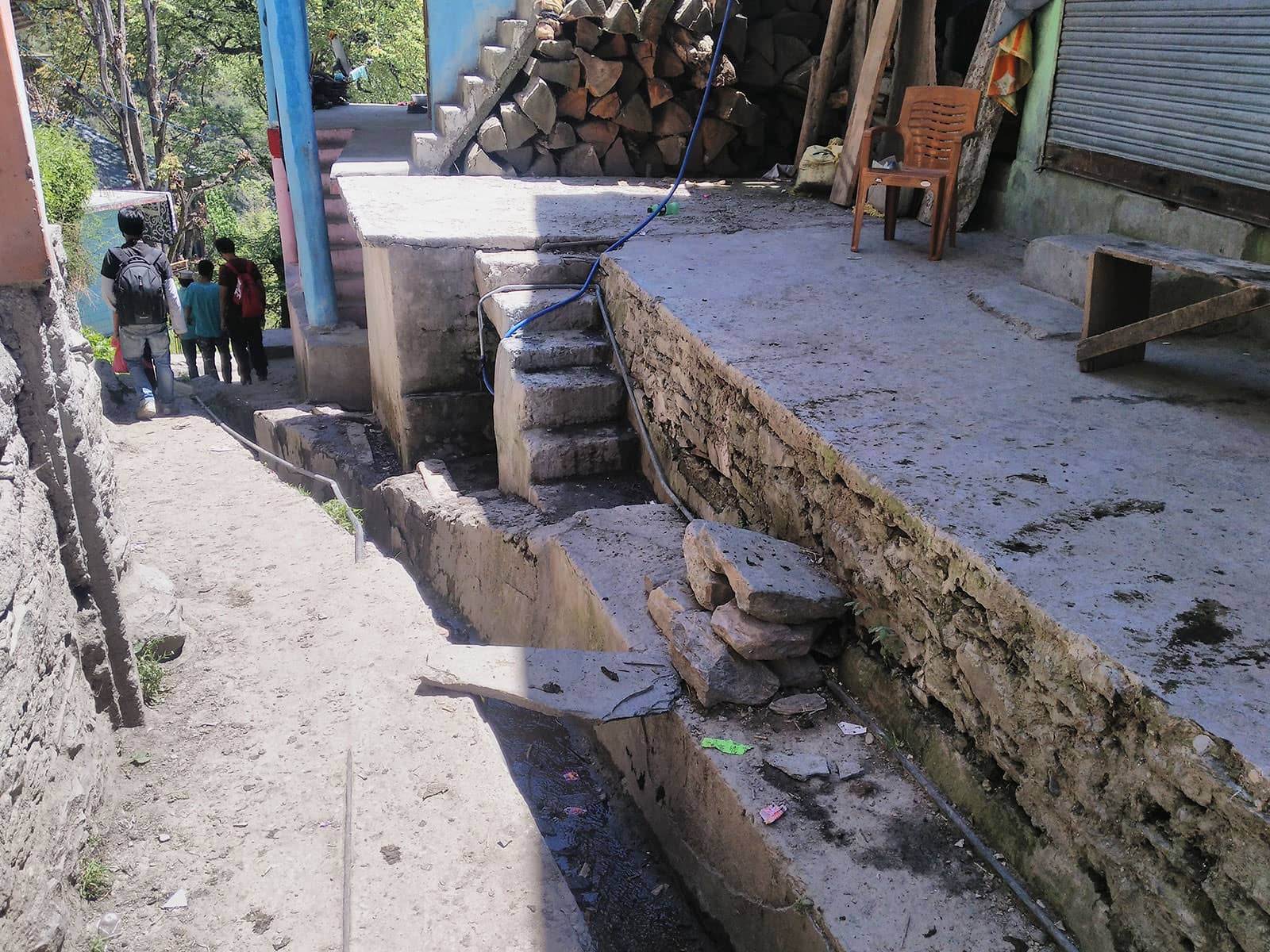
Concrete footpaths and staircases (May, 2015)
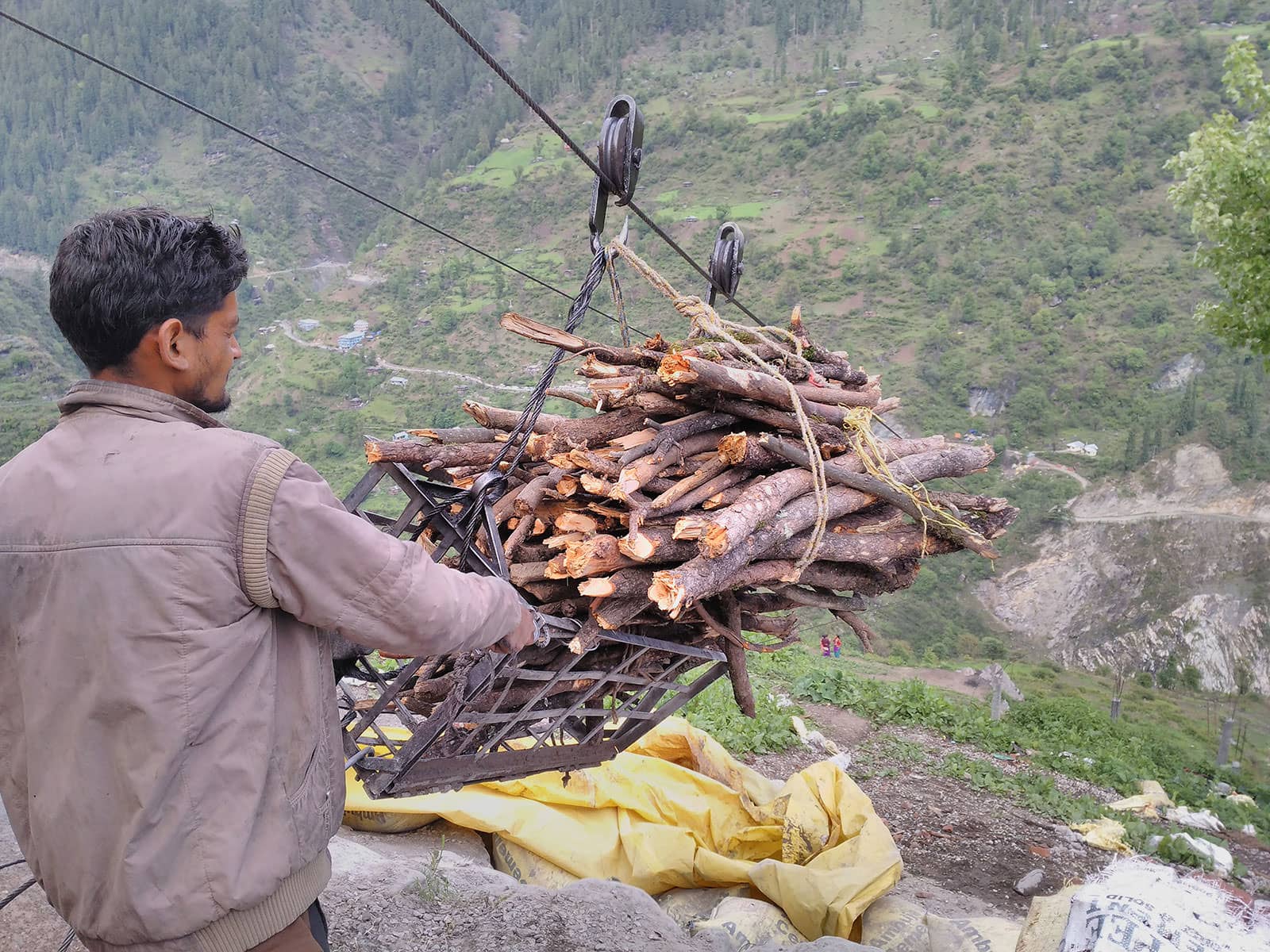
Trolley service called 'Spen' (May, 2015)
Tourism
There are nine guest houses in the village, the first one being the 'Dragon' guest house founded by Prem Sharma in 2007. This marked the beginning of commercialization in the village.
| Guest house name | Number of rooms available |
|---|---|
| Dragon (est. 2007) | 14 |
| Chand view | 14 |
| Hill top | 4 |
| Diamond | 4 |
| Moon light | 4 |
| Rudra | 4 |
| Malana view | 4 |
| Goonj | 4 |
| Himalayan village | 4 |
Guest houses in the village
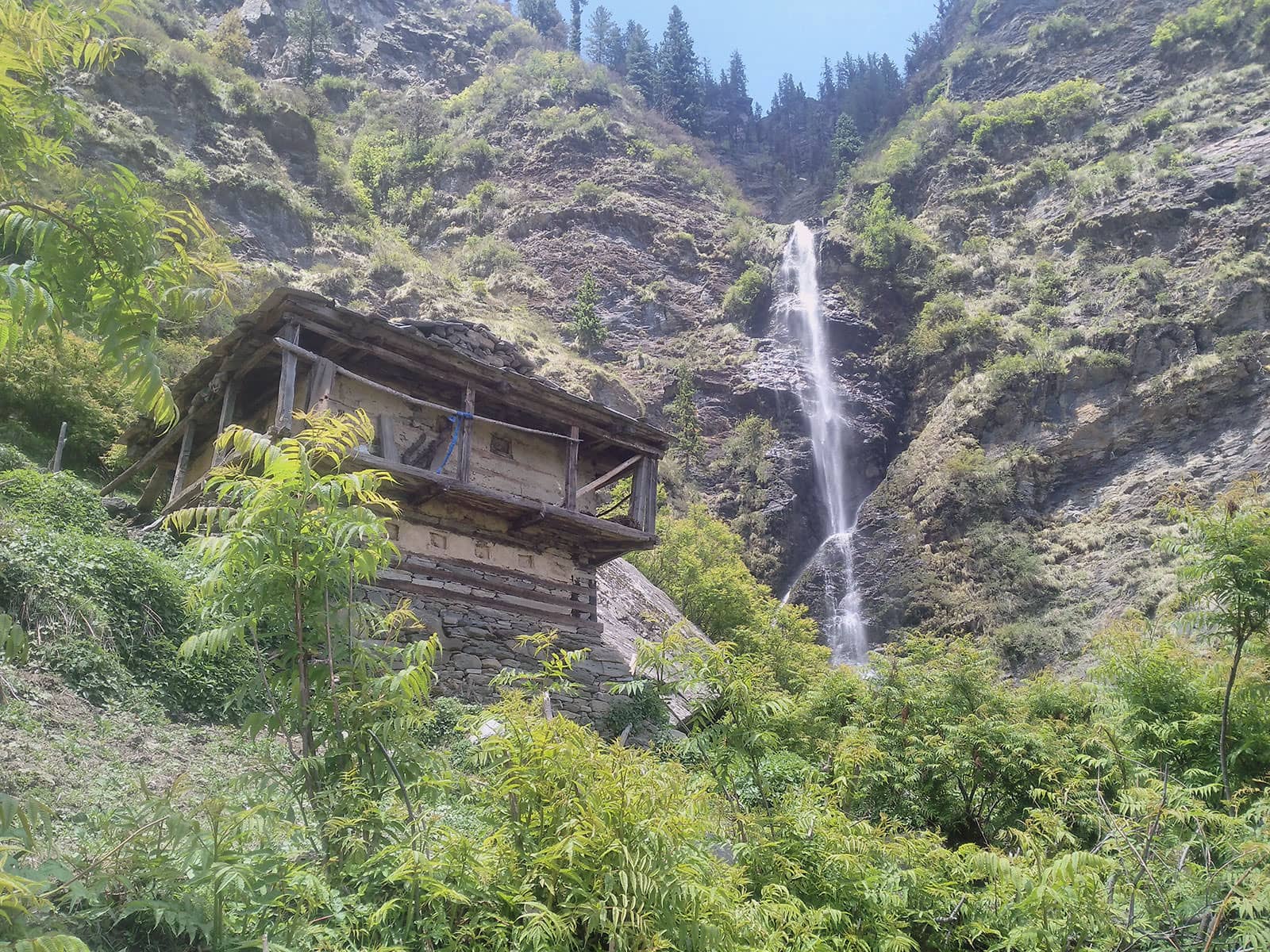
Malana waterfall is one of the tourist attractions here (May, 2015)
Camping services are also available at Nirang and the Magic valley areas near Malana. The facilities available are preliminary but the guest houses are doing their best to upgrade to technologies such as free Wi-Fi, 24 hour hot water supply and television sets.
At an average, around 100 tourists visit Malana every day in the months from March to October. Then the tourist numbers reduce to about 10 a day in November and 2 a day from December to February when the village is covered in snow.
Restaurants are located at both higher and lower sides of the village usually connected to their guest houses and various cuisines such as Italian, Israeli, Chinese and Indian are served to the visitors.
The trolley service may also be used by visitors to transport their luggage from the taxi stand over the valley to the village to save time during the two hour trek to the village. Porter services are also available inside the village to carry baggage.
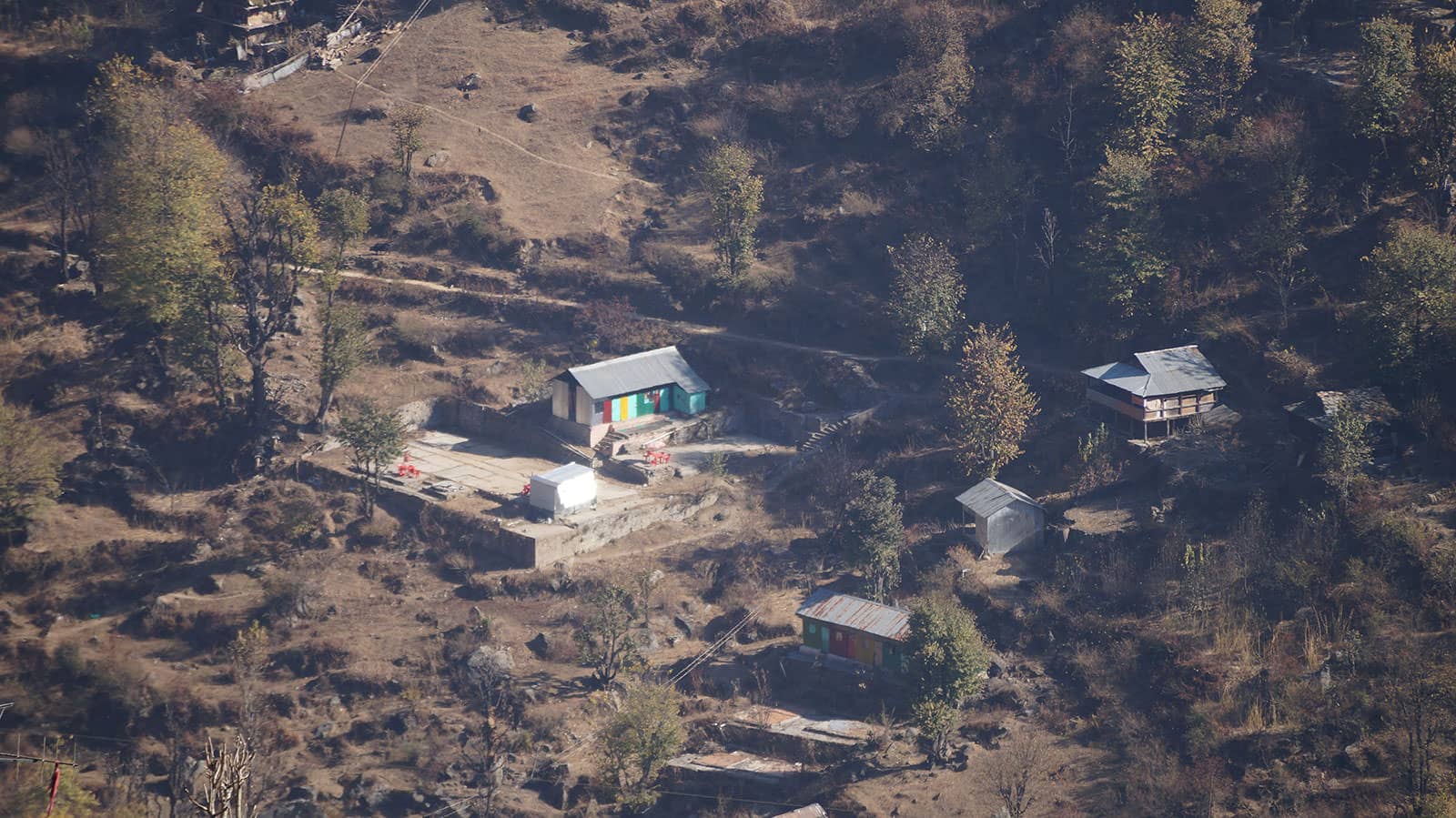
Camping site at Nirang (November, 2016)
Local Economy
Source of Income
The average family income is around 1 lakh rupees per annum. Due to rise in the selling price of Malana creme that is cultivated locally, its sale has given a great rise to income of the villagers.
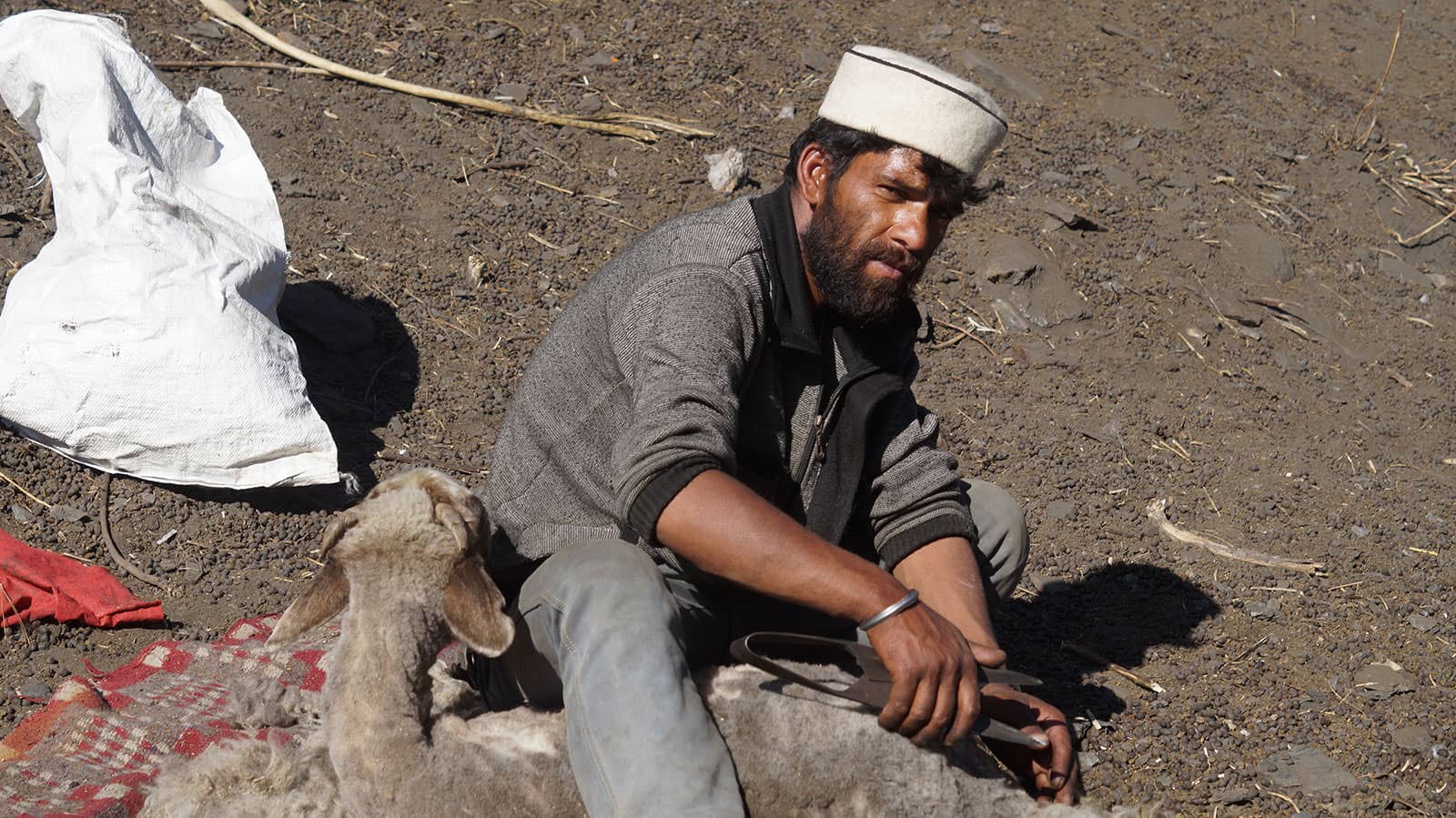
Man fleecing his sheep (November, 2016)
Livelihood
The major income source is the sale of Malana creme in the village itself. Another great source of income is the sale of wild herbs. These herbs are found in the mountains in the months of March and April after the snow melts and are sold at high prices to dealers from the cities. These herbs are also exported to countries like China.
Sale of wool in nearby villages, manual labor such as carrying goods into the village or work as porters and jobs provided to the inhabitants are other income generating activities.
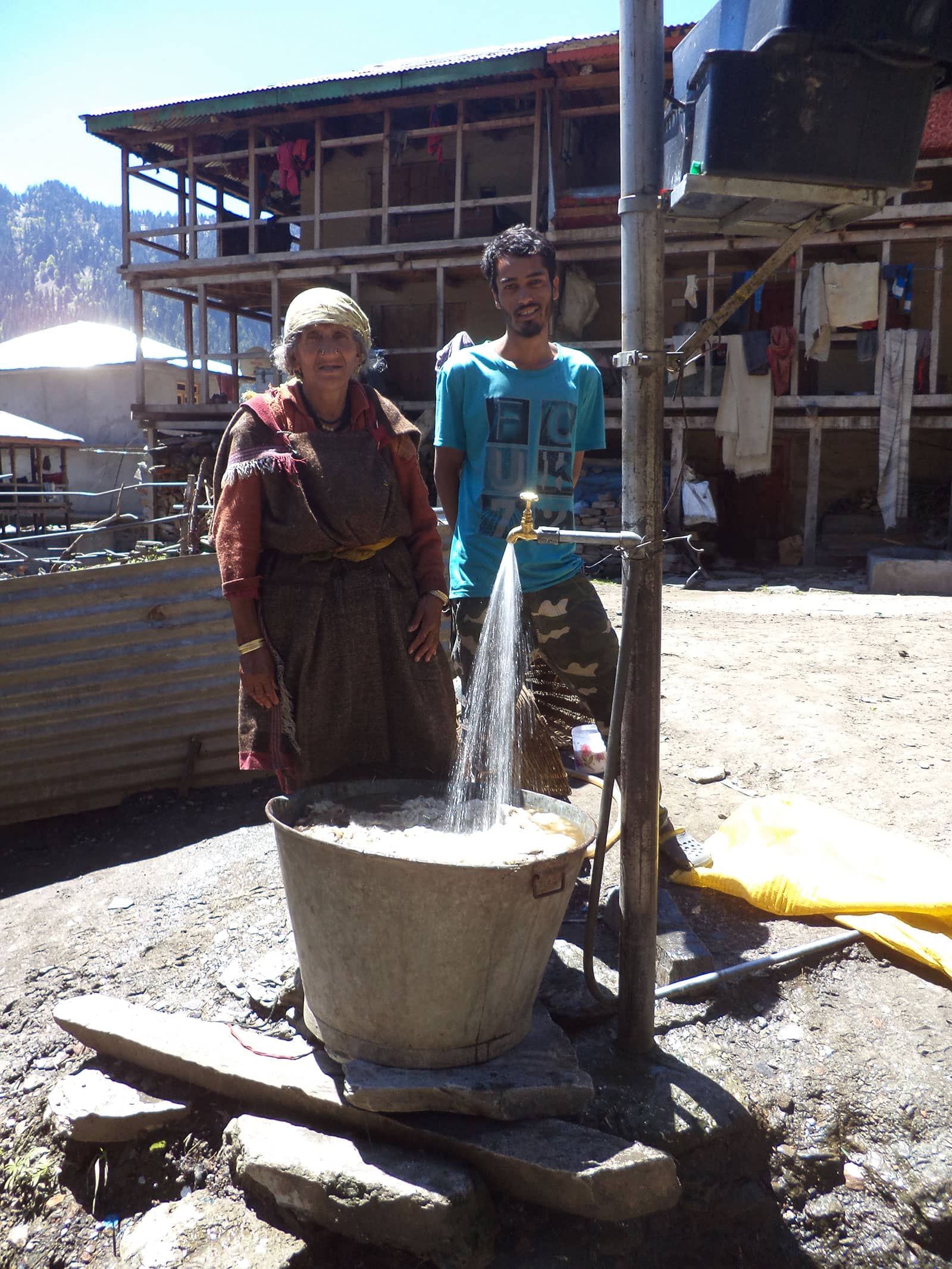
Old woman cleaning sheep fleece (May, 2015)
Primary and Secondary Occupation of Villagers
Malana is an agrarian economy. Most of the cultivation today is concentrated on production of cannabis. The other occupation is the collection of herbs as mentioned above. These two constitute the backbone of the income of the villagers. The secondary occupations are manual labour and sale of wool.
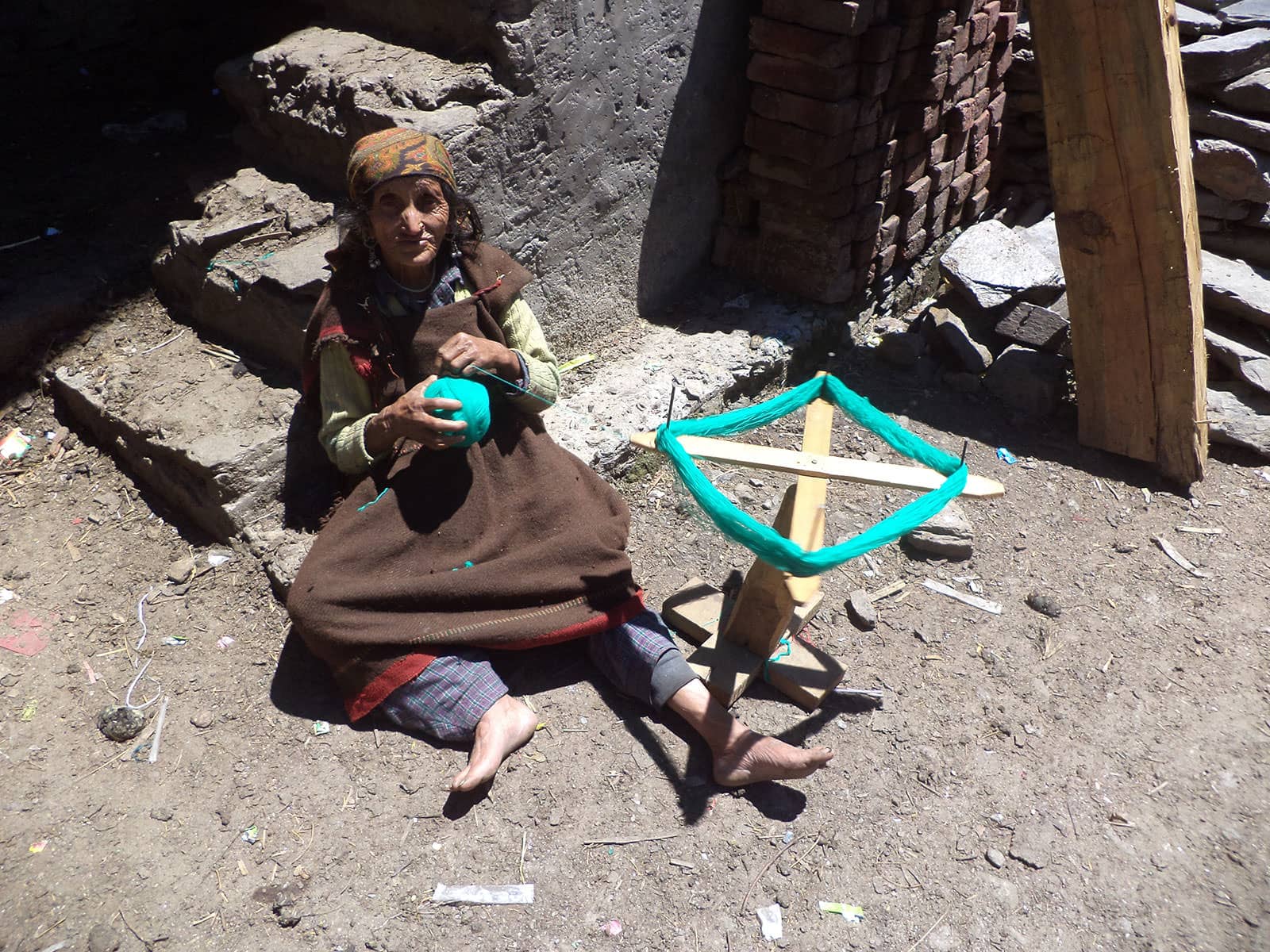
Old woman spinning yarn (May, 2015)
Land Holding Pattern
Land in the neighborhood of the village belongs to the villagers. Some inhabitants having higher purchasing power own major businesses such as taxi services, shops or renting/ leasing of property to others, hotel businesses etc. About 20 of such rich families have great turnovers annually while the rest are poor and include mainly marginal workers.
Despite this, most of the villagers own two houses- one inside the village and one outside near their farm. During the harvesting season of cannabis or other crops, these villagers shift to the houses built near the farms so that they can tend to these crops better. Areas where the people of Malana own houses are the Nirang mountain side, the Magic valley meadow and the Waterfall area patch near the trail to Chanderkhani pass.
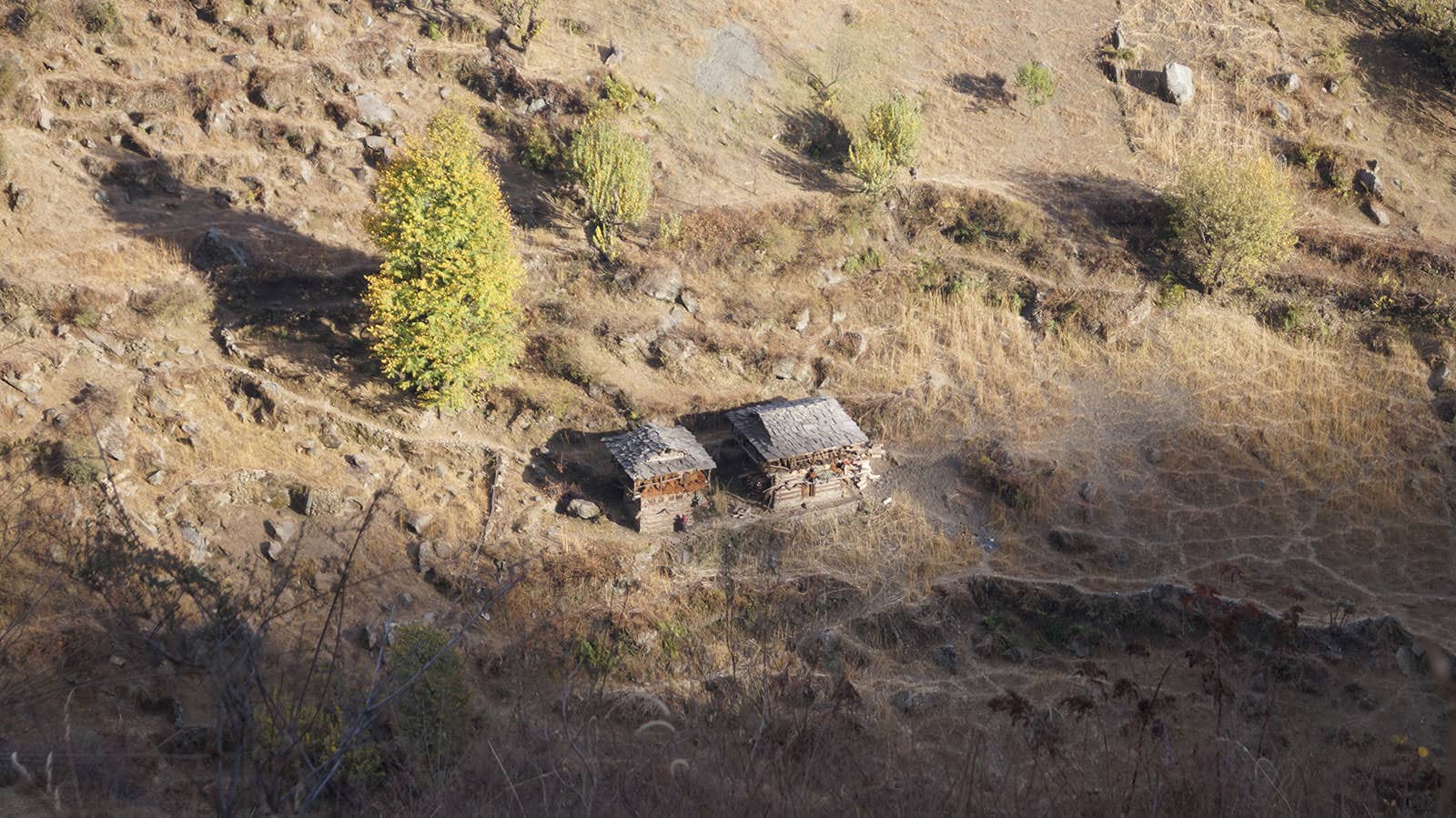
Houses ouside the village near farms (November, 2016)
Consumption
Products
Consumable products range from the most basic grain stock to cornflakes and olive oil. Also for commercial goods, unlike other nearby isolated settlement, Malana offers a wide scope. From basic clothes to JBL speakers, many of the modern-day luxuries are also readily available here.
Food Availability
Today, majority of goods are imported into the village. This also includes food items. Their availability is maintained uniformly throughout the year as purchasing power in Malana is comparatively higher than what might be expected.
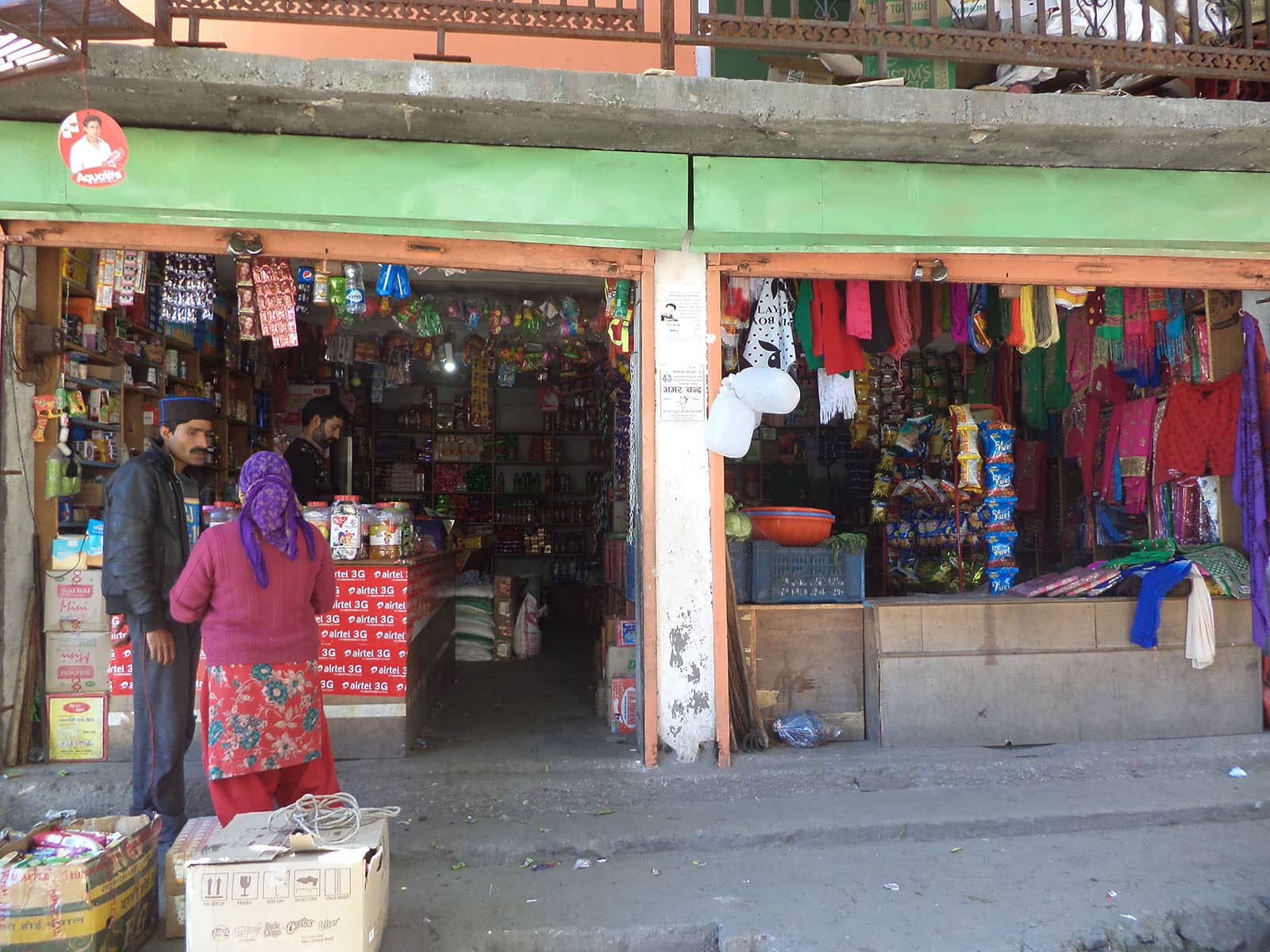
Malana's largest grocery store. Most inhabitants find all their necessities here (May, 2015)
Forestry
The village is divided into two parts- Dharabher (upper Malana) and Sarabher (lower Malana). The lower caste Lohars live at the bottom most part of the village in the north. Only a person living in Dharabher can construct another building in Dharabher. And only a person living in Sarabher can construct another building in Sarabher.
From the site visits, it was observed that the southern part of Malana has more old Kath-khuni houses than the northern part. This is because the fire in 2008 burnt these wooden houses in the north beyond the main temple of Rishi Jamdagni. Newer construction sites can be seen in the north and north-western parts of Malana. Now, concrete houses are favored as wood has become very expensive to construct with. Due to newer construction materials, the number of floors in each house has also increased, the tallest one being four storeys high near the Lohar residence in the southern part of the village.
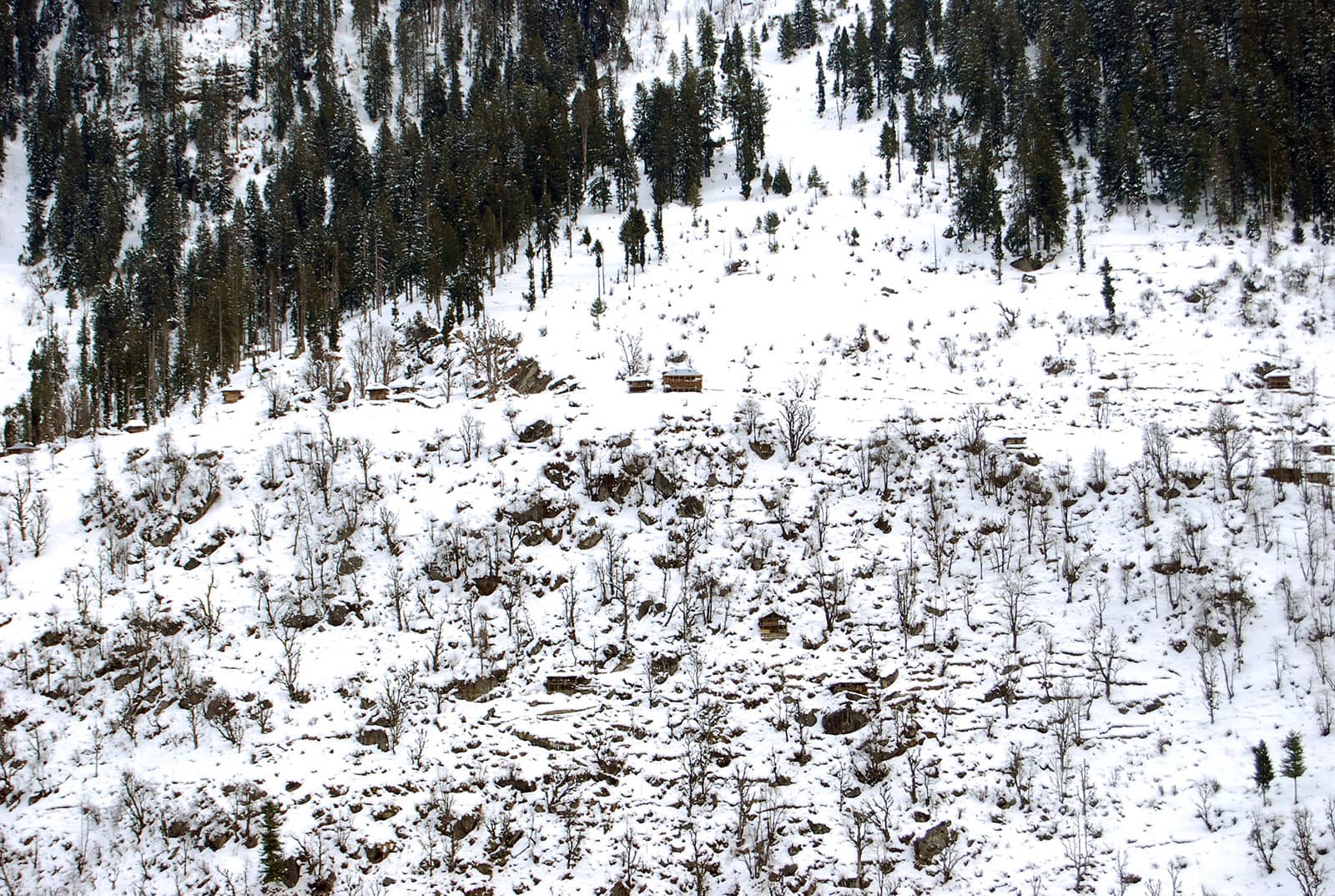
Difference in forest cover with increasing altitude (Picture courtesy: Amlan Datta)
Credit
There is no system of lending money in the village. Instead, the villagers collaborate to help an acquaintance, friend or a family member to gather money and lend it to the person in need. No interest is charged and the repayment is done as per the negotiation. If the repayment is not done, the person may even be pardoned. This system reflects the mutual respect and understanding these villagers have for each other.
If credit is not available when needed, the villagers approach banks for loans. These loans are taken only in cases of emergencies or for buying luxury products or vehicles.
SHGs
BOM-BOM charitable trust was founded by Amlan Datta while he was shooting his film "BOM aka One Day Ahead of Democracy" in the village in 2009. It offers training to the locals in a few economic activities specific to Malana. Although very progressive in nature, currently, it needs additional funds.
Few NGO's have also made failed attempts to clean the village and to convince the locals to stop the cultivation of cannabis and instead grow other cash crops.
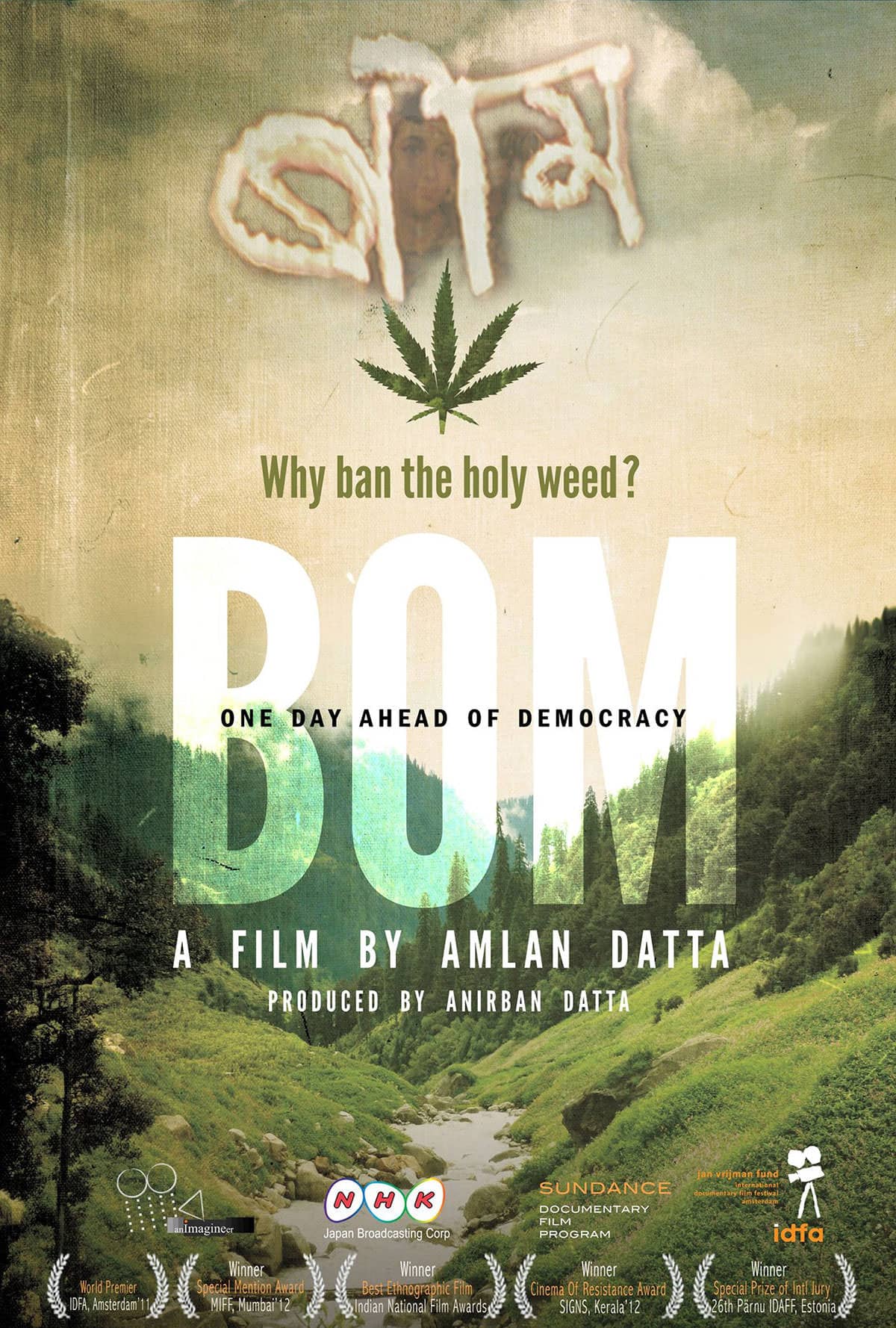
Poster of movie BOM aka One Day Ahead of Democracy by Amlan Datta, available on the Google Play Store

Political and Governance System
Political System
People are aware of political parties such as BJP and the Congress. The currently elected Sarpanch- Bhagiram is a supporter of the BJP. Although, administration in the village follows older norms and hence political parties and their agendas have little influence in the village.
Old Governance System
The village had a democratic set up and the village council was called 'Hakima' and consisted of Goor (village Oracle), Pujari (village head priest) and Kardar (village council speaker) representing higher court and Jestha the lower court. Pujari and Kardar were hereditary posts and the representatives of Rishi Jamdagni. 'Kardar' was second in hierarchy. There were four elected members from the village called Jestha (permanent members of the council). Each Jestha could select one more member called 'Pogudar' and total elected members added to eight. Out of these eight, one person was elected as the Pradhan (Sarpanch) and the other was known as the Upapradhan.
Magdu, the 'Goor' of Malana died in 1985 and nobody has taken his place so far. Any person could become the Goor, who is then regarded as the voice of the village god. He is said to be possessed by the spirit of Rishi Jamdagni. Once the Goor is identified, he is directed to wear a cap and keep long hair. On certain occasions the Goor dances in ecstasy and is possessed by the holy spirit of Rishi Jamdagni. On such occasions the Goor directs the villagers and also listens to their woes. Goor has an important position in the village council and is always consulted before making any judgment.
[Source: Exhibition- Malana ShangriLa in the Himalayas]
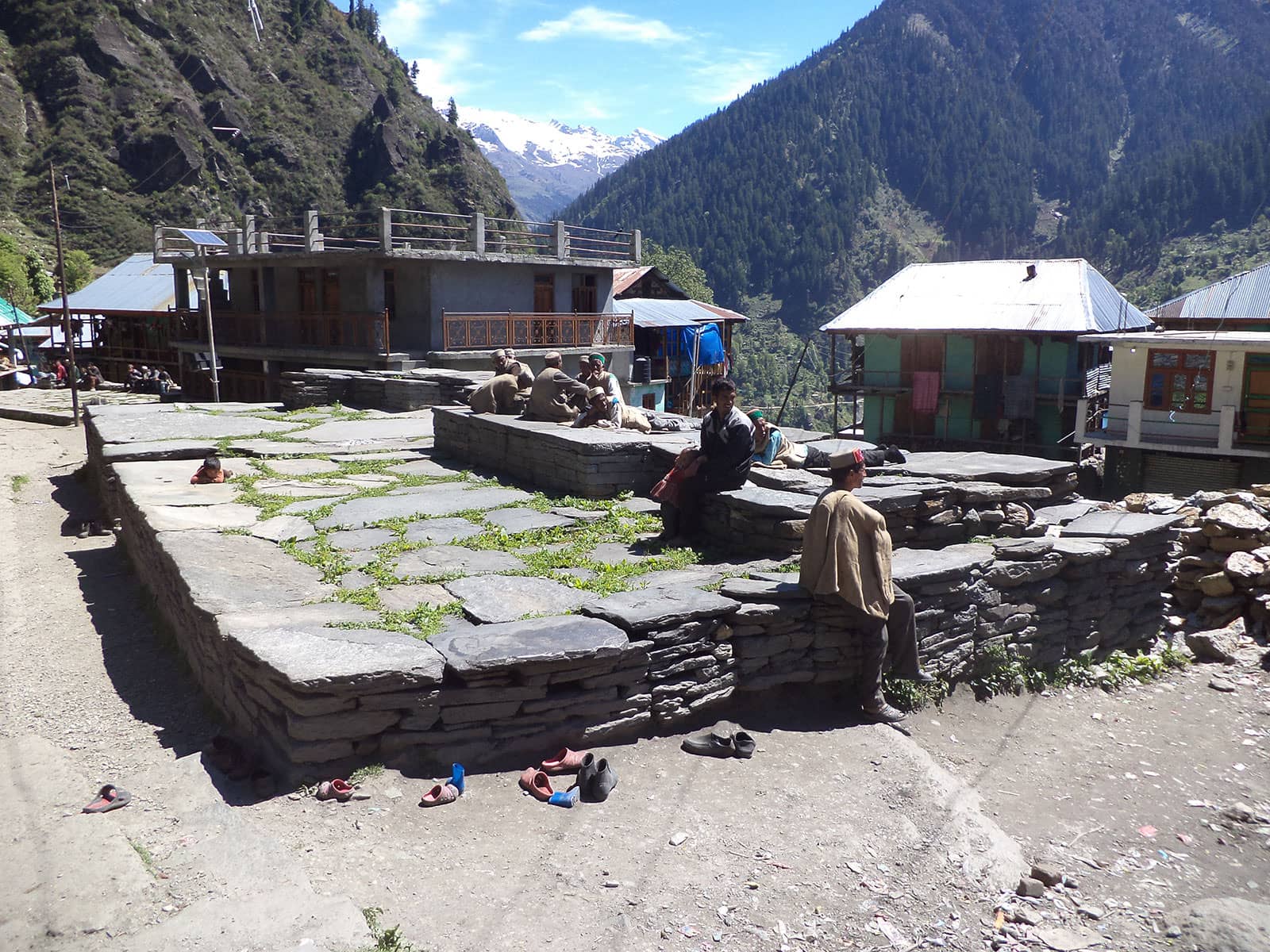
Lower court of Malana (May, 2015)
Present Administrative System
Gram Panchayat
The village is divided into 7 wards. Each ward has an elected representative and he/ she is known as the Panch of his/ her respective wards.
All villagers including the Lohars have one equal vote. The Sarpanch and the Vice Pradhan are chosen every five years along with the seven Panch(s) of the wards. The voting for all the representatives is done at the same time using stamps. These nine elected representatives constitute the Gram Panchayat.
Gram Sabha
A formal meeting is organized by the members of the Gram Panchayat twice a month. The aim of this meeting is to solve the issues that the villagers have. Here, the villagers are heard equally and ask the Gram Panchayat to solve disputes or can place their demands/ mention expectations for development etc.
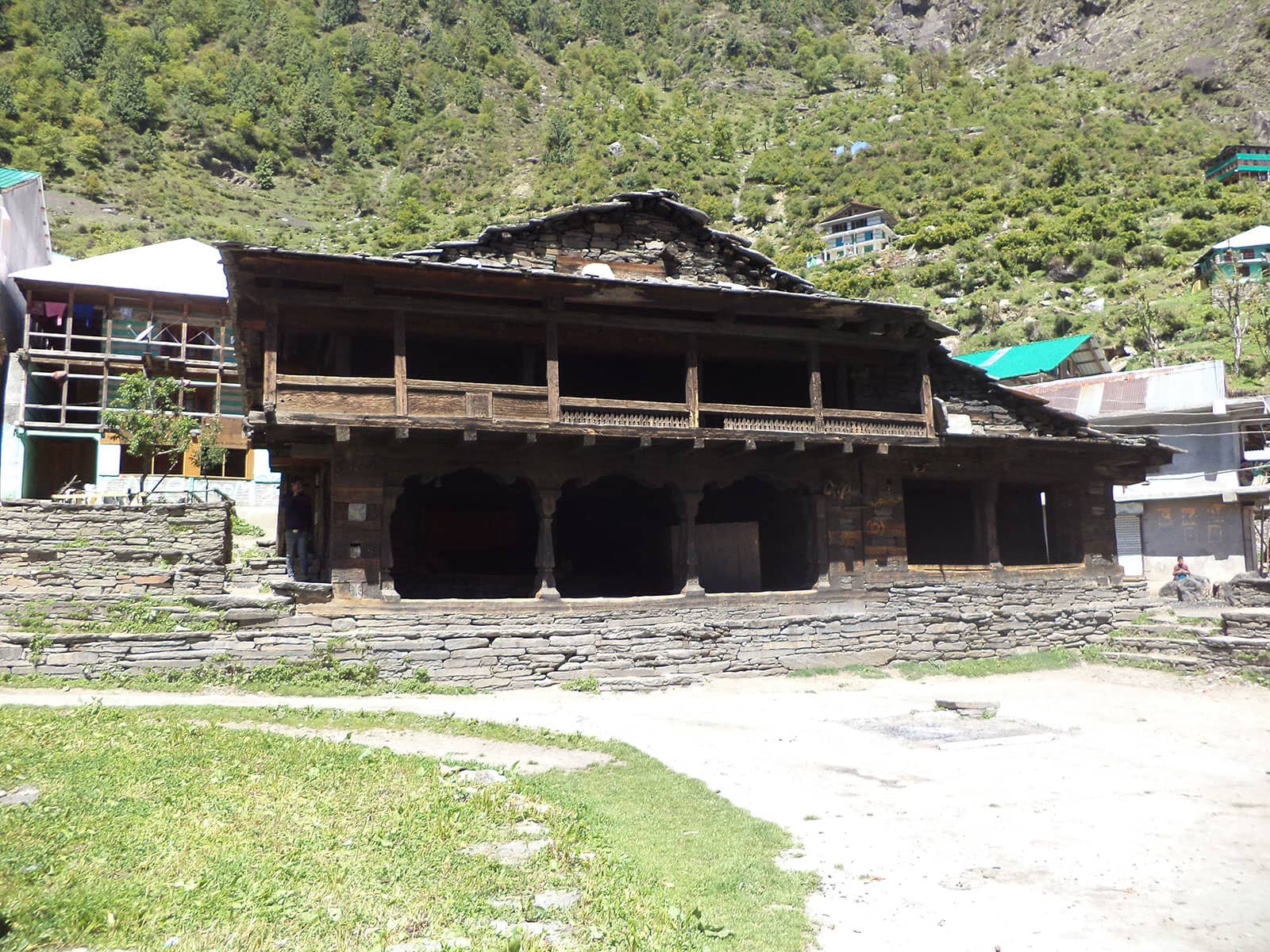
Villagers call this the 'Parliament' where the Gram Panchayat meets (May, 2015)
Government Schemes
People of Malana have been provided with various government schemes in terms of providing labour, alternative crops to cannabis cultivation and village development infrastructure. Two of these are mentioned below.
MNREGA
National Rural Employment Guarantee Act 2005 (NREGA), later renamed as the "Mahatma Gandhi National Rural Employment Guarantee Act" (MGNREGA), is an Indian labour law and social security measure that aims to guarantee the 'right to work'. It aims to enhance livelihood security in rural areas by providing at least 100 days of wage employment in a financial year to every household whose adult members volunteer to do unskilled manual work.
WATSON Scheme 2013
To address the core areas of concern in the Himalayan region, Sir Ratan Tata Trust Mumbai with its partners have launched an initiative "Himmothan Pariyojana". The broad objective of the project is to improve community health by providing safe drinking water & sanitation facilities to the rural people. The project requires a 10% cash contribution from the beneficiary community to propagate a right of ownership on the project, the rest of 90% cost of the project is funded by SRTT/NRTT. After successful implementation of the project in other states of the country, SRTT initiated to execute WATSAN (Water and Sanitation) project under "Himmothan Pariyojana Extension-HP, Phase-III" in state, selected SATHI as a supporting organization and decided to execute WATSAN in Pachhad & Shilai block of district Sirmour (HP).
[Source: http://sathihp.com]
Status of Gender
Men
Most men do not work daily and can be seen lazing around near the main temple complex and the lower court area. This system of men not working has been present in Malana for centuries. Men may undertake activities such as herding sheep, working in farms and manual labour. Specifically, men are involved in trade. Women are not involved in trade. So, in one way, men bring money in the house.
Women
Women of Malana are majorly involved in various day to day activities. They wash clothes, clean utensils, work in farms, cook food, gather firewood and may also do manual labour. Clearly, domestic activities are undertaken by women. Below is a chart explaining the social standing of women in Malana.
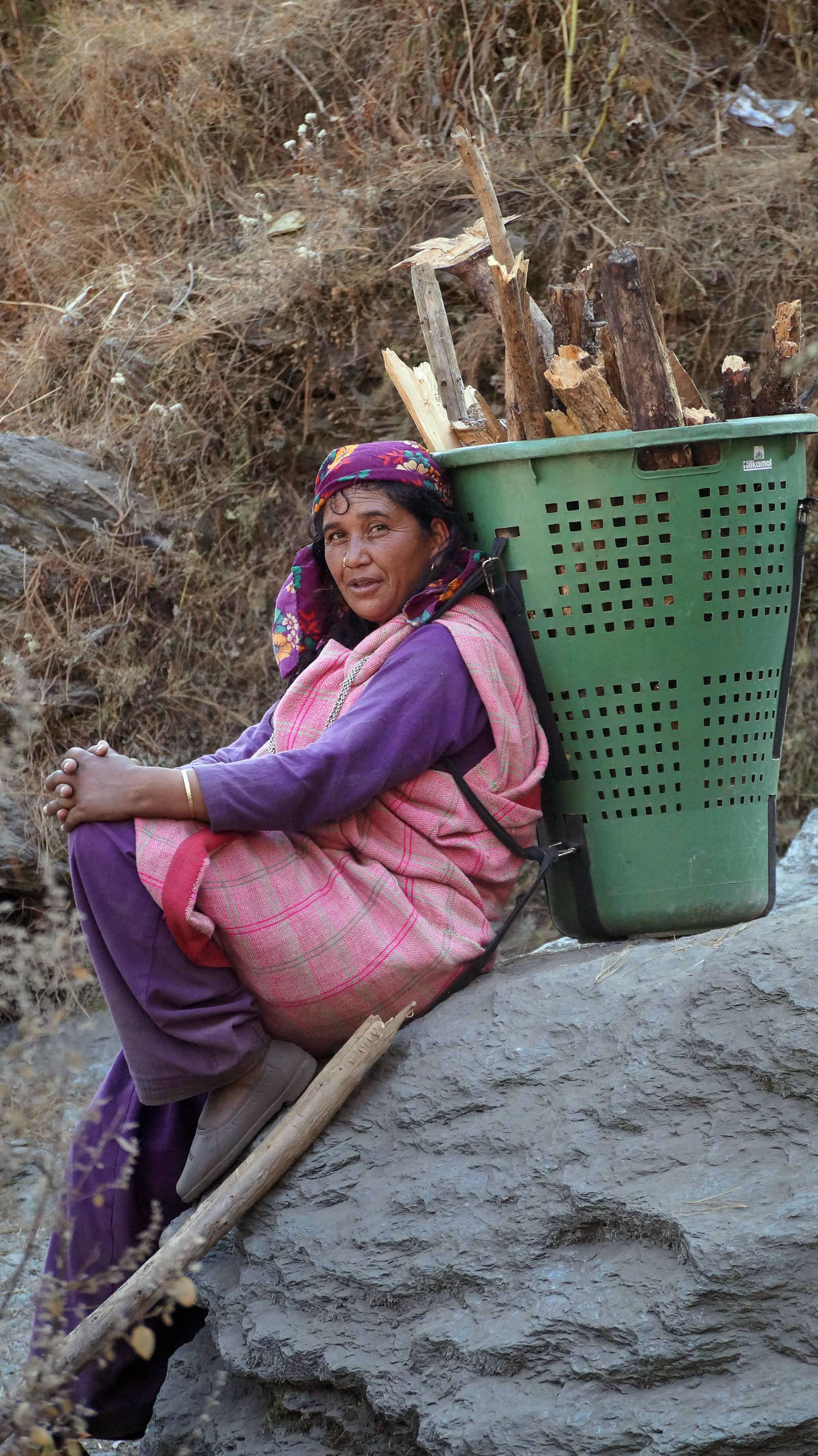
A young woman carrying firewood to store for the upcoming winter season (November, 2016)
Gender Analysis
| Women's' participation in Politics | Women have equal rights as men and participate in politics and also get elected |
| Agriculture | Work is divided between the men and women. Both may do manual work such as sowing, ploughing and harvesting |
| Land | Men and women have equal right to ownership of land obtained either from their ancestor or purchased/ leased |
| Labour | Men and women receive equal wages for work |
| Education | Just as many girls go to school as boys. Although these numbers are very less, no such priority is given to any gender |
| Marriage | Child marriages are prevalent in both genders. But, the average age of girls getting married is less compared to that of boys (as low as 12 years) |
| Family planning | Women and men, both have equal right to decide the number of children in the family |
| Dowry | Very little dowry is given by the girl's family to the boy's family |
| Divorce | Divorce requires consent from both the man and the woman and is a very easy process where Rs. 20 are offered to Rishi Jamdagni and immediately, the divorce is in effect |
| Decision making | Every household has a head and the head is the eldest male. Here, this head is the decision maker of the family |
| Control over finance | Since most money matters- trade and other exchanges are resolved by men, women have little or no control over finance in the household |
Gender analysis
Culture
Fairs and Festivals
"Malana Fagli" and "Malana Shaun" are the two main festivals of this village . "Malana Fagli" is celebrated in mid of February whereas "Malana Shaun" on 15th of August.
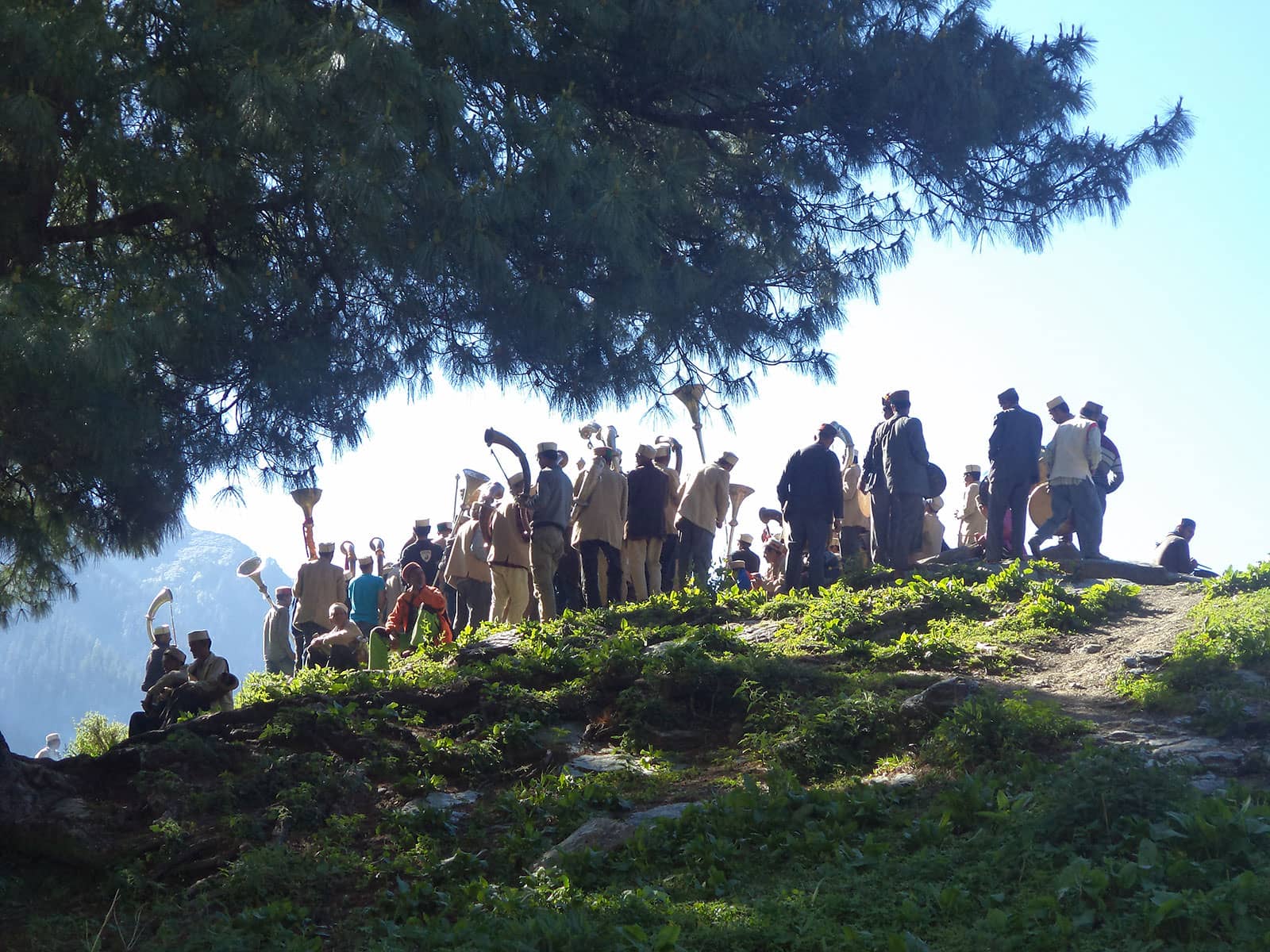
Locals celebrating an occasion (May, 2015)
Marriage and Divorce
In Malana, people get married at a very early age of 13-14 years. The marriage can be an extremely quick affair as well as the rituals are not complex. The bride and the groom wear traditional outfits. The groom along with his family visits the bride's house. The groom's friends or other acquaintances may also accompany him. At the girl's house, rice, chapati, dal and meat is served. The bride's parents present gifts to the couple and bless them. Then the groom carries a torch- 'Mashal' in his hand and the bride follows him to his house where she settles down. This ceremony has no elaborate rites or rituals and the priest is not present either. And, therefore is known as Rakshasi marriage. The ceremony usually costs around Rs. 50,000.
The people of Malana are allowed to either marry inside the village or in a nearby village known as Rasol where Renuka Devi, wife of Jamdagni Rishi is worshipped as main deity. If somebody marries outside these territories, he or she may not be allowed to return to the village.
Divorces are common in the village. A meager sum of Rs. 20 has to be offered to the Devta in the temple and the priest declares the separation. According to the old rules, an arrangement of basic necessities such as a house, food, etc. has to made for the woman after the divorce. People of Malana can marry multiple times. Men are allowed to have more than one wives while women can remarry after divorce. In case the husband dies, the widow can remarry after one year.
[Source: Exhibition- Malana ShangriLa in the Himalayas]
Death
The people of Malana identify their last rituals as the purest in the valleys. The body of the deceased is burnt the same day if possible or the next day in case of death at night near the Malana nallah. The body is placed on a pyre and then set to fire till the body turns to ashes where the remains are left. The family or acquaintances of the deceased move into a Dharamshala built near the temple complex till these rituals are over. They may also stay here till the house of the deceased is purified by a goat sacrifice.
[Source: Exhibition- Malana ShangriLa in the Himalayas]
Dispute Redressals
In case of a dispute, the issue is raised in the lower court where the Gram Panchayat acts as the council. Both parties are heard and the judgment is announced. In case of dissatisfaction by this judgment, the higher court can be accessed. Both these courts are present in the village. The court is not rigid in its decisions and may revise them in the interest of the village. If the accused wants to address the police in this case, he has to pay a fine of Rs. 1,000 to the council.
The judiciary of Malana has its own way of administering justice. In most cases the guilty is fined. In case of theft the offender has to return the whole amount and pay a certain amount to the treasury. In case someone revolts against the administration and judiciary, his property is seized and the person is not allowed to stay in the valley. In case of theft or misuse of the God's treasures, the stones are tied to culprit and he is pushed down the mountain slopes.
[Source: Exhibition- Malana ShangriLa in the Himalayas]
There was another practice of making justice by the court of Malana which is no longer continued. Here, two lambs were brought on the platform belonging to the two people who have a dispute. A plant which acted like poison was sought from the mountains and kept in the hand. At the same time, one slit was made on the necks of the lambs by their owners and the herb was put inside and the wound was stitched back. Soon, one of the lamb would die and the other one would be standing. The person whose lamb would die first was deemed guilty and had to admit defeat even if the judgment was wrong. Later the loser would accompany the winner to his/ her house and make peace.
Socio-cultural Beliefs
- The people of Malana consider themselves as upper castes and all outsiders as lower castes or impure. They refrain from touching others and heavy fines are levied if an outside touches or clicks pictures of the temples in Malana. Many people here, especially the elders still follow these traditions while the newer generations may shake hands without botheration.
- Adultery and incest are not taboo subjects in the village and are very common among the villagers. Also, smoking or selling cannabis is normal in the village. It is considered to be the 'Holy weed' and even children and old people can be seen carrying Malana 'creme'. Interestingly, alcohol is banned in the village since two years because of its violent implications.
- Men spend their time playing cards in the temple complex and the women are expected to do the daily chores. Girls as young as 10 years also carry firewood on their backs and can be seen cleaning utensils or washing clothes. Child marriages are normal.
- Only the Pujari of the village is allowed to wear a white turban and he has a separate two storey beautiful house near the temple complex. There are many other customs that the priest has to follow. The position of the Pujari is passed on to the boy in the same family.
- Despite considering outsiders as impure, the people of Malana are very cordial in religious matters. In the past, they have been known to allow visitors to stay at their homes for several days. Because of this, Malana is also known as the "Valley of Refuge".
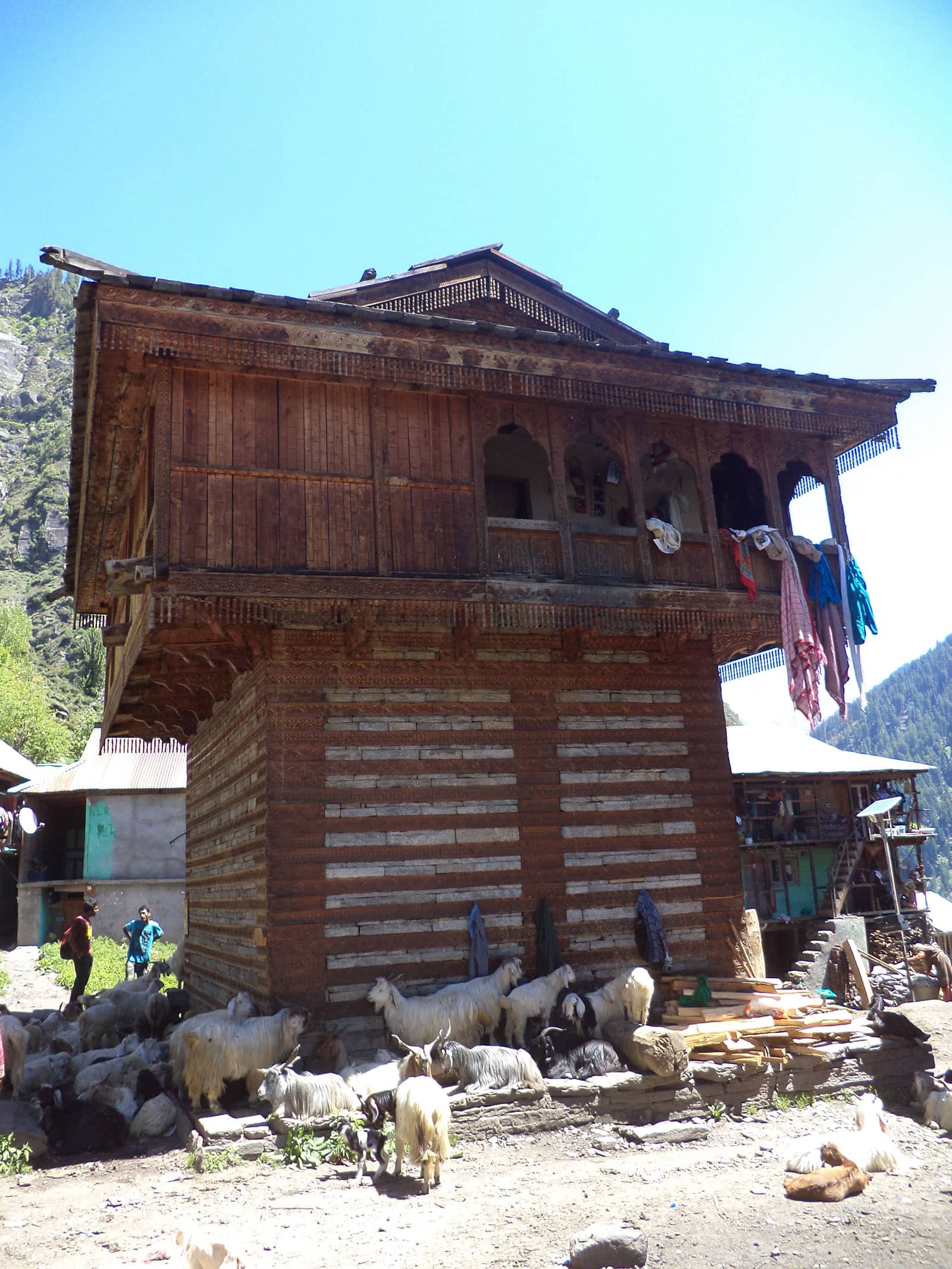
Two storey house of the head priest or 'Pujari' (May, 2015)
Architecture and Construction
Old Style of Construction
The older parts of the village have been built using wood and stone that were locally available. Old houses in Malana are two or three storeys high and each floor has a specific name and purpose. The ground floor is called 'Khudang', which acts as a cattle shed and where the firewood and fodder for the sheep and goats are stored. The first floor called 'Gaying' is used to store eatables, wool and for weaving woolen fabric. The top floor with an overhanging balcony is called 'Pati'. It is the actual living quarter.
After the fire of 2008, around 150 houses burnt down in the northern part of the village. This can be noticed easily because older Kath-khuni buildings are majorly found in the southern side of the village.
Unlike the villages in the Shimla district, villages in the Kullu and Parvati valley have the absence of tall Tower Temples which functioned as granaries, look out points or as fortifications during invasions. Malana does not have any tower suggesting that it never needed one because it has always been a peaceful community and the main temple is also used as a granary of Rishi Jamdagni.
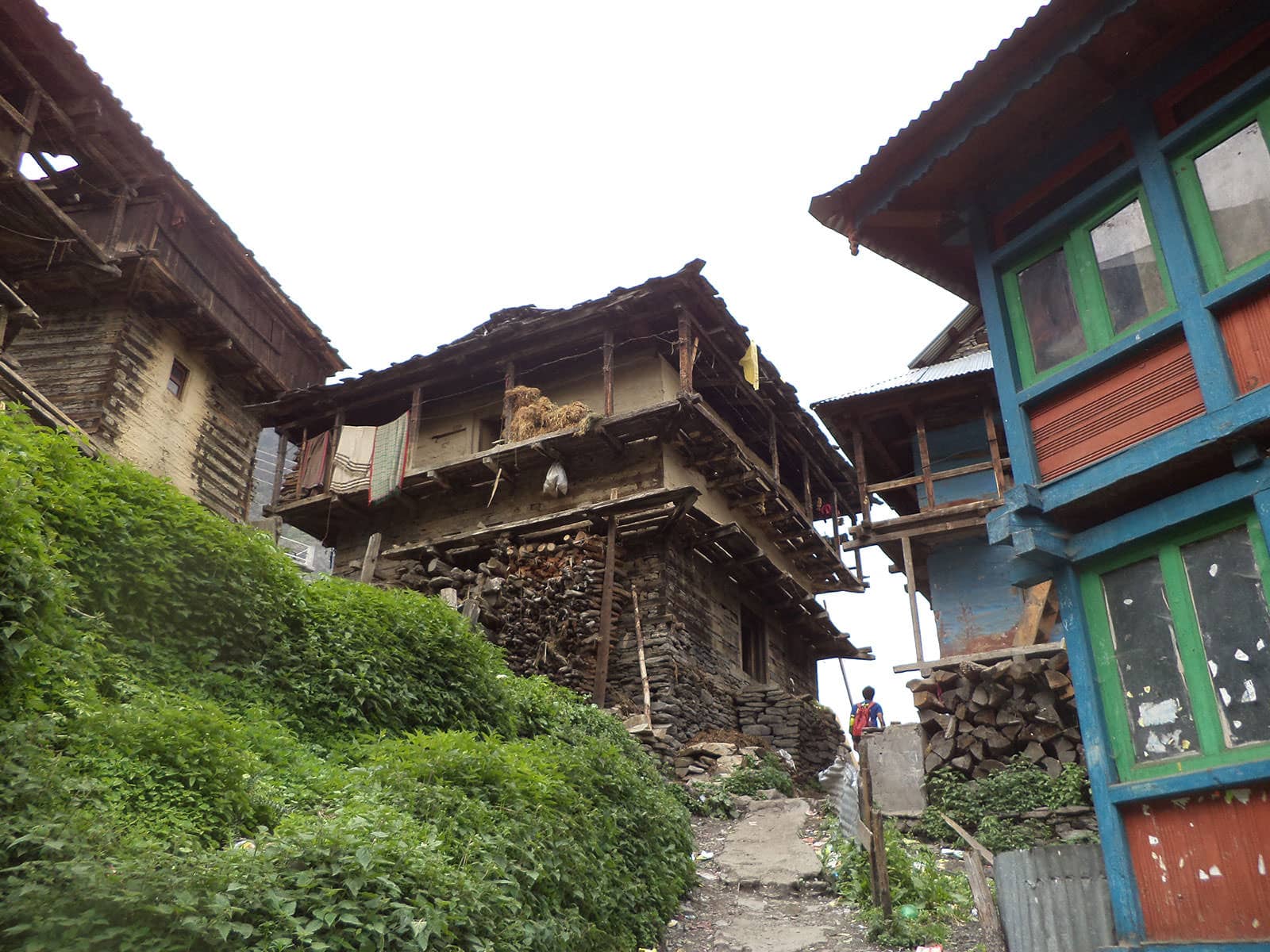
Old construction with Kath-khuni style of architecture (November, 2016)
New Style of Construction
The new buildings are being constructed using cement concrete with corrugated sheets being used as roofs. This is because cutting trees for timber has been banned by the forest department and now, only temples or other public buildings can be built using wood. This has made obtaining wood very expensive in comparison with materials like cement.
Stone is still relatively cheap and can be obtained from nearby quarries at Rs. 1 per stone. Cement sacks weighing about 70-80 kg available at Rs. 335 a sack are available in the village at a cost of Rs. 550. A sack of sand weighing 30 kg is priced at Rs. 200 in the village while a quintal of rebar costs around Rs. 3,300. These materials are available at higher costs in the village because they need to be transported from lower lying areas such as Jari. Labour charges are around Rs. 600 a day and additional arrangements are to be made for their stay in the village. Hence, construction is probably the most expensive affair in the village.
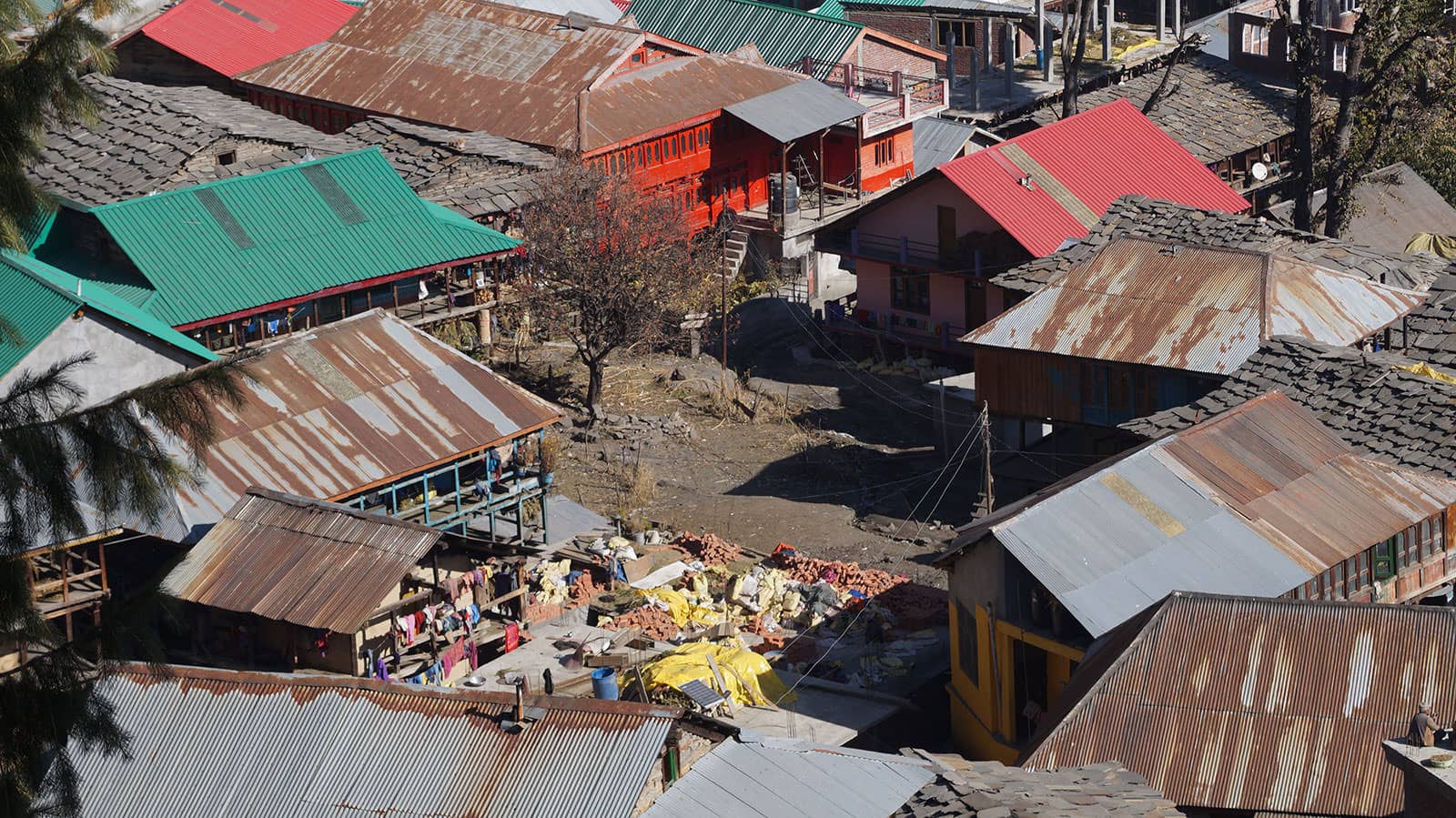
A building under construction using bricks and mortar (November, 2016)
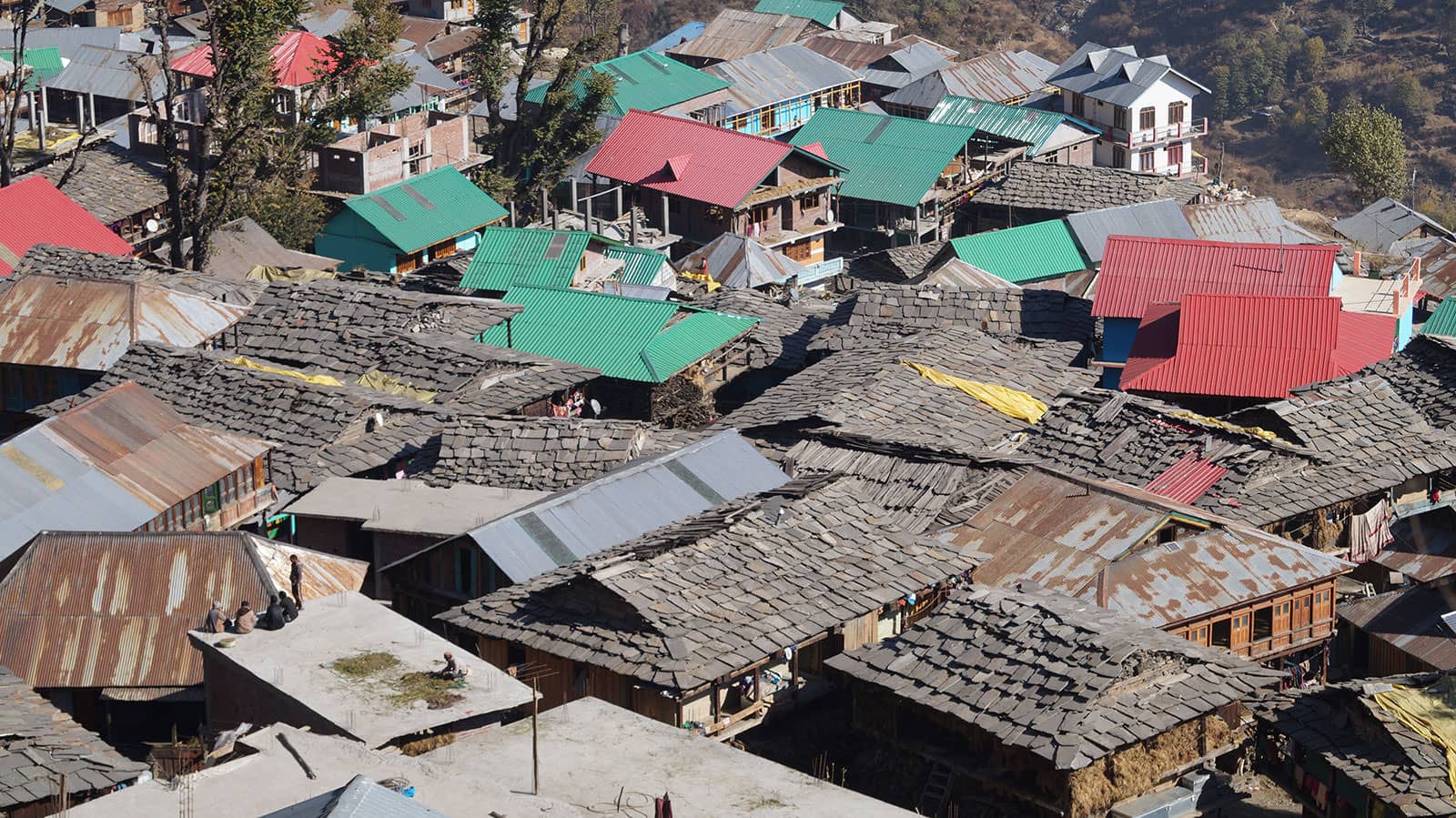
A very dense neighbourhood (November, 2016)
Built and Unbuilt Spaces
The village is densely populated and hence, most of the buildings are extremely close to each other. There are several open pockets in between these buildings and act as community spaces. These courtyards may vary in size and are usually near water points. Some of these courtyards are raised platforms made of stone and covered with cement concrete on top.
Near the temple complex, a similar platform is built as the lower court of the village and during the day, men can be seen playing cards or smoking cannabis.
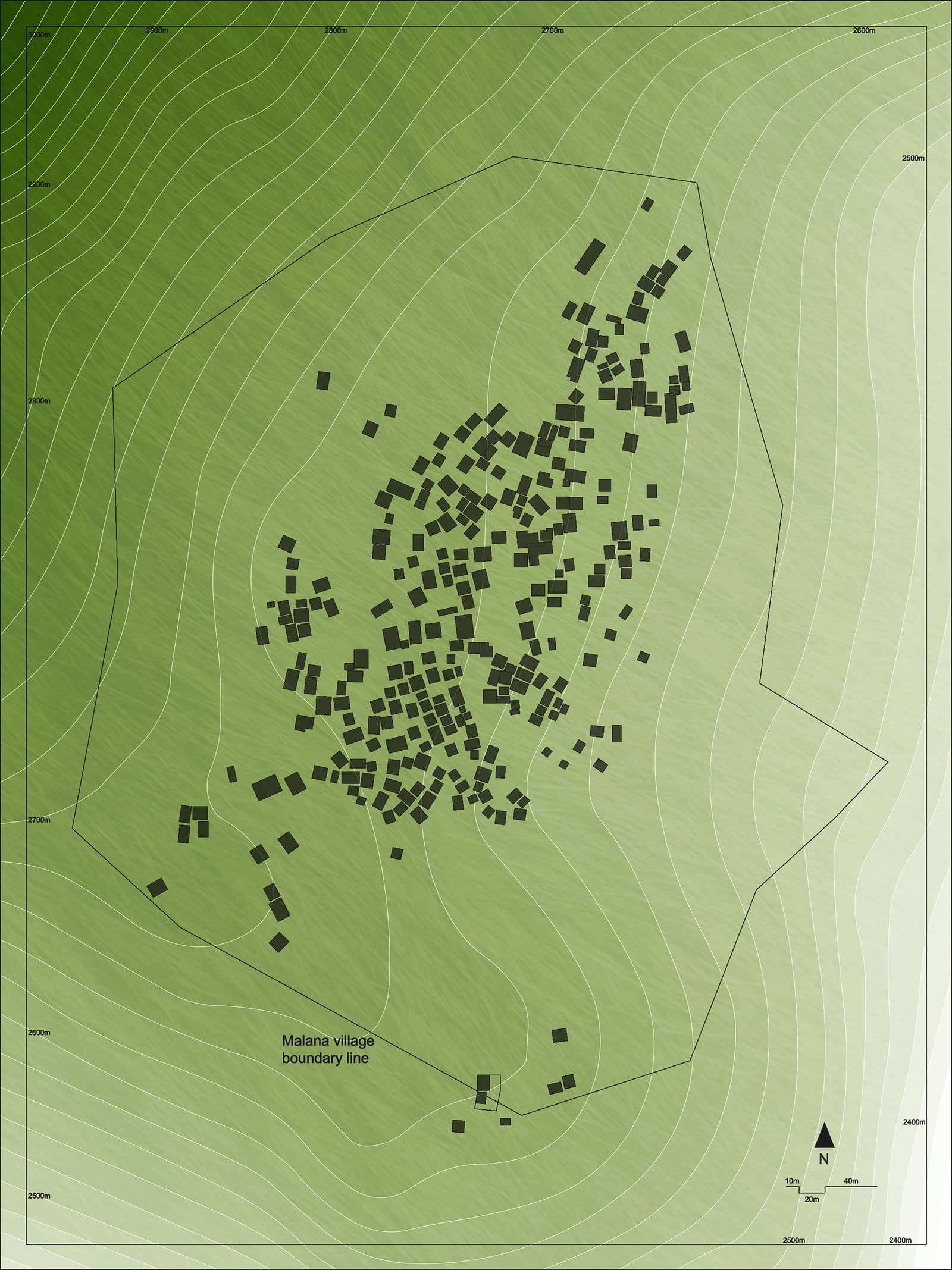
Gradients, built and unbuilt spaces in Malana
Evolution of the Village
The village seems to have evolved from the main temple complex where the Dharamshalas may have followed the construction of the main temple of Rishi Jamdagni and later, with the increase in population, houses must have spread out in different directions. Today, majority of the construction sites can be seen either in the higher lying areas in the north-west or lower lying areas in the eastern directions. No space is available in the central core of the village for further development.
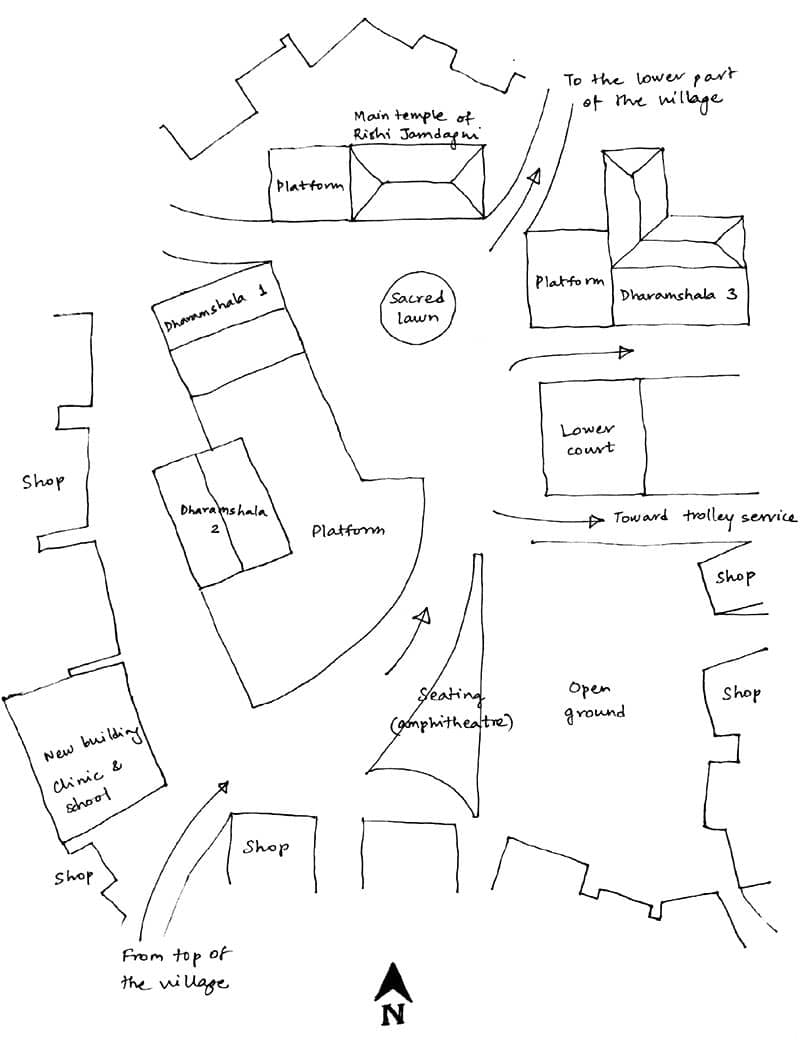
Hand drawn sketch of temple complex and surrounding public amenities
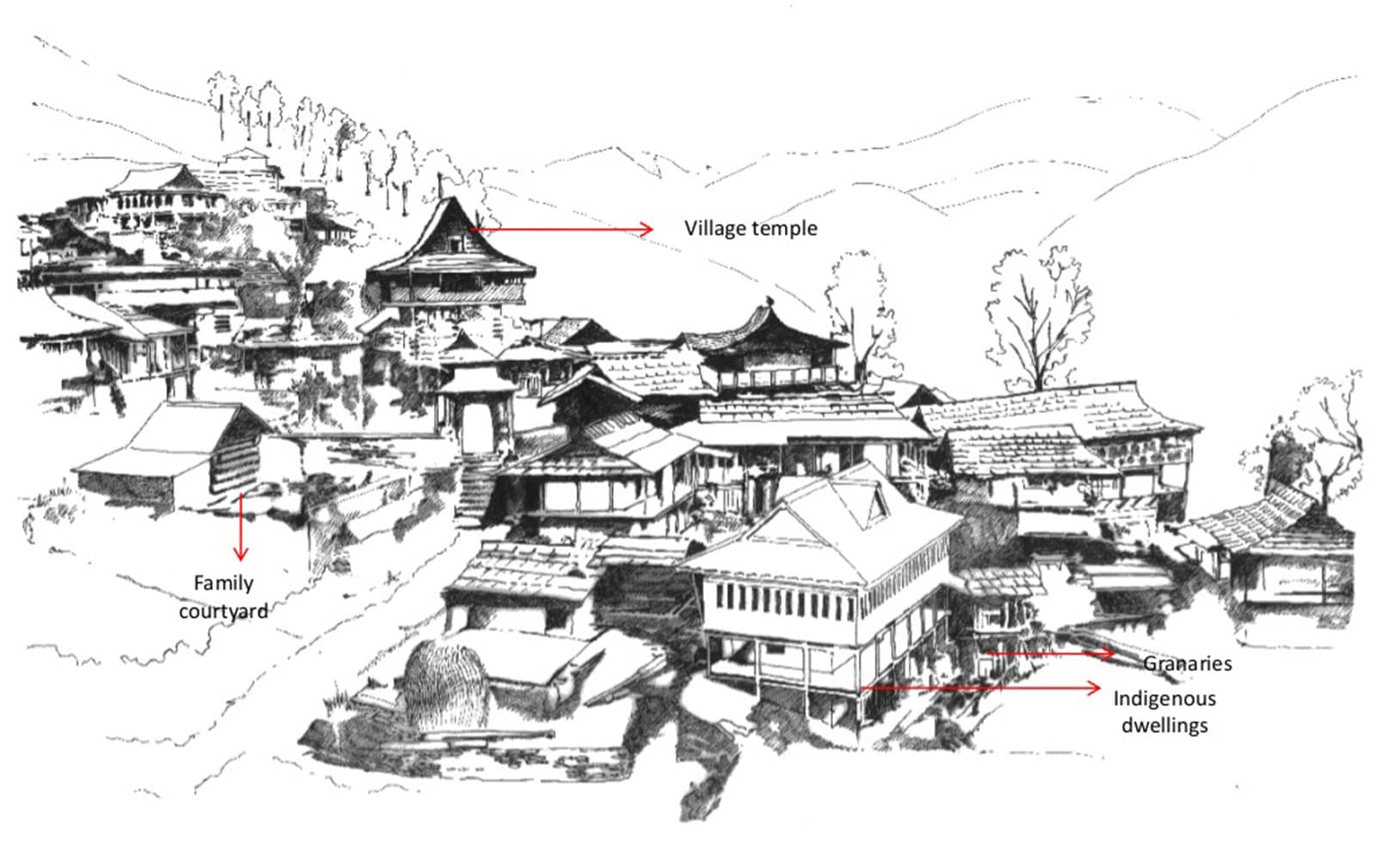
Typical settlement pattern of a Himalayan village [Source: Book- Prathaa]. Note: This is not Malana
Craftsmanship
There is one 'Mistri' or carpenter in the village. His workshop is the northern part of the village. Labour for normal construction is hired from nearby places such as Jari and Bhuntar while highly skilled artisans are hired specially for the construction of temples where the budget is very high.
The level of craftsmanship is not at par as nearby settlements and can be noticed from the older standing religious buildings where intricacies and elaborate carvings are missing. The temples were rebuilt after the fire by craftsmen from outside the village and are extremely detailed and contain typical Kath-khuni ornamentation.
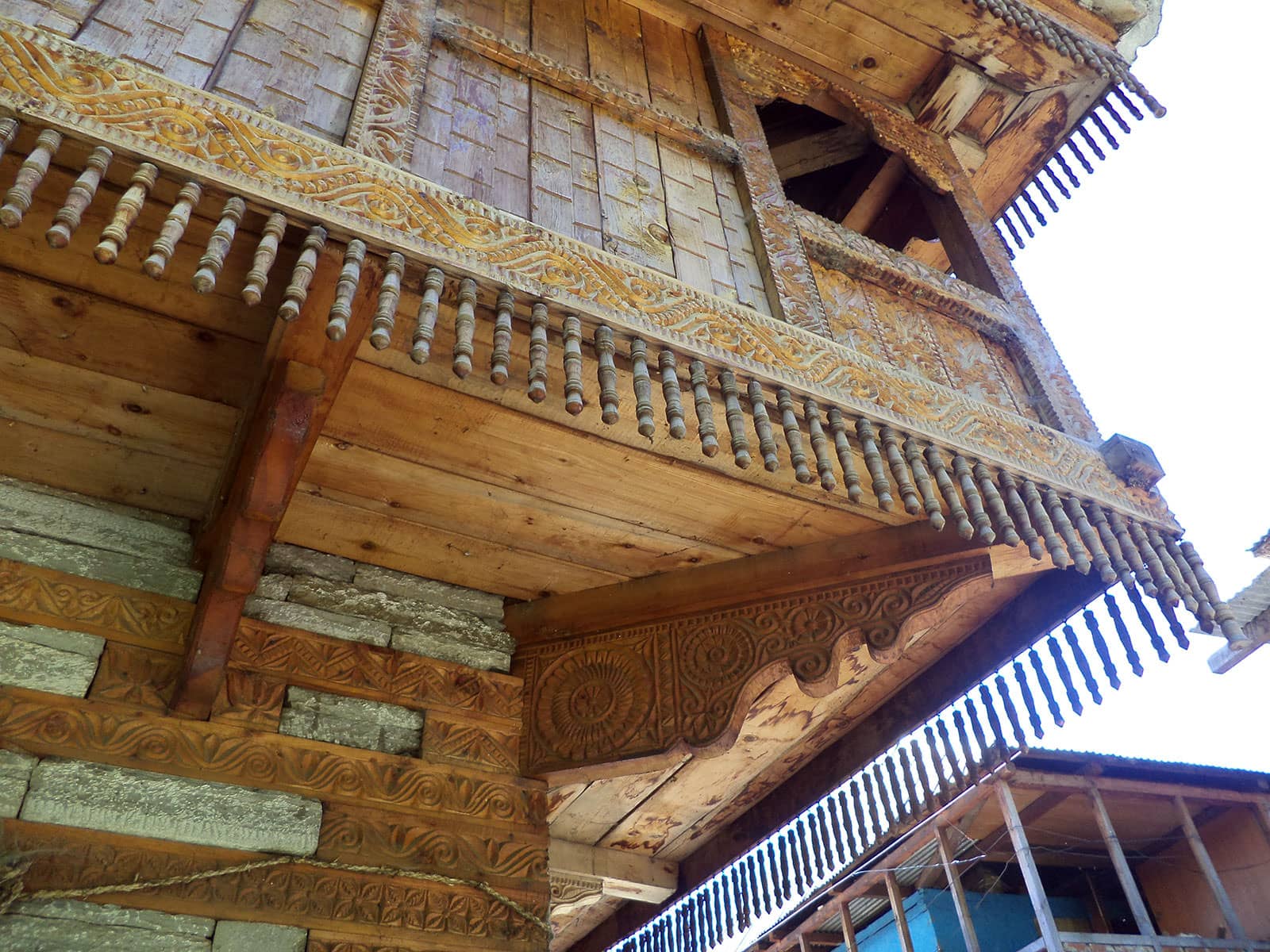
Intricate wooden craftsmanship found only on temples (May, 2015)
Plans, SWOT Analysis and Relations
Plans
Short-Term Plans
Short term plans of the village include the cleaning of the village, but these attempts in the past have failed miserably due to the absence of a garbage disposal system in the village.
Long-term Plans
- Long term plans include the construction of a building that houses a new clinic and schools in the center of the village. This project is almost complete.
- There has been another demand for a new road to connect the village directly to the road instead of a connection through the valley. This proposal has been put forward by the Gram Panchayat and construction is expected to start soon.
SWOT Analysis
| Strength | Weakness |
|---|---|
| Dense forest- isolation Wild herbs- supplementary income Hemp & Malana creme Close knit community |
Illiteracy Less opportunities for work Extreme weather during winter |
| Opportunities | Threat |
| Tourism potential Market/ Demand for woolen goods |
Job insecurity Income illegality Natural calamities |
SWOT analysis
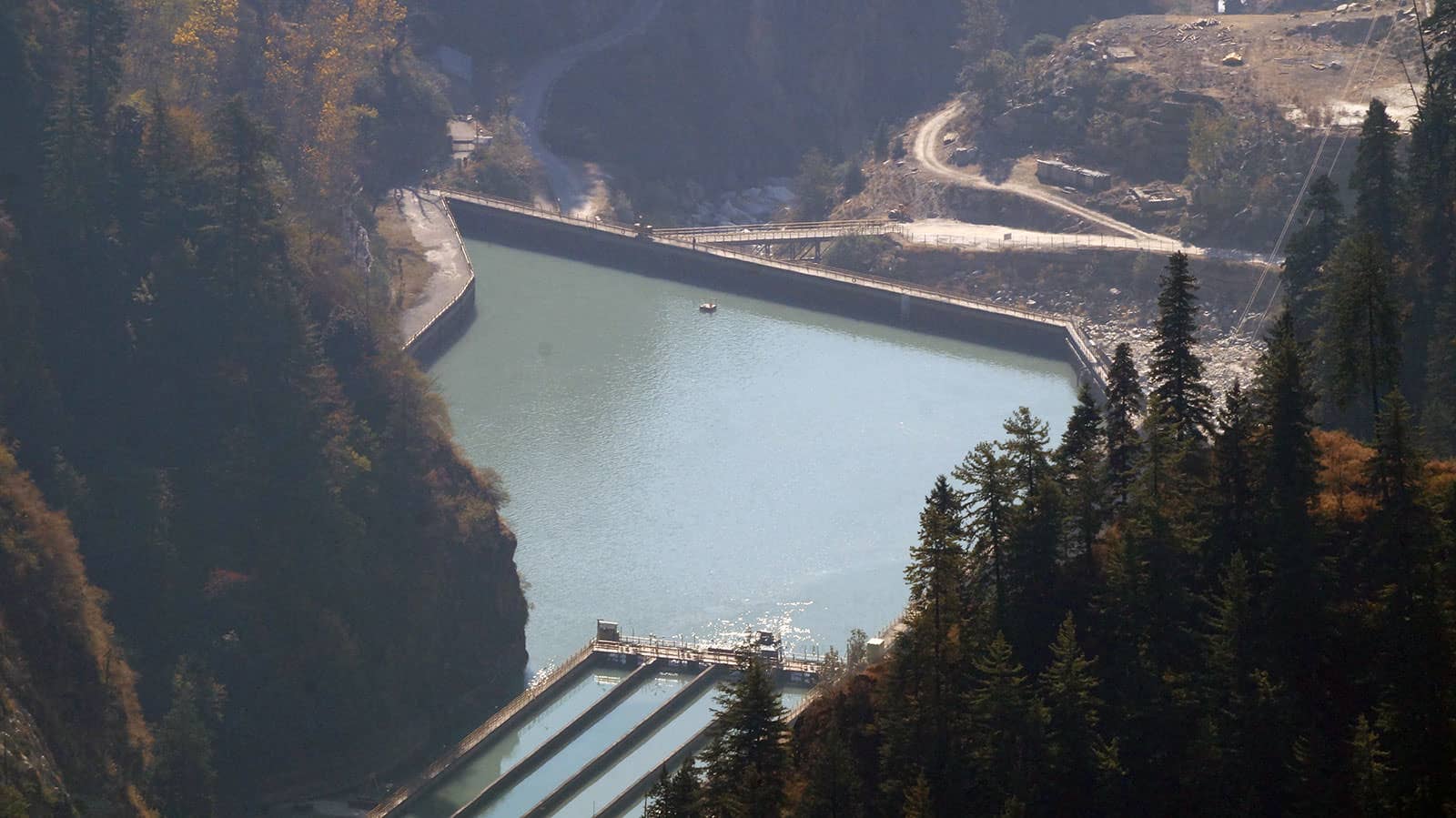
Malana Dam (May, 2015)
Relationship with other Entities
The Government
The police visits the village during the cannabis harvesting season in October and November and stay in the village in tents for days or sometimes even a week to destroy the crops by cutting them to prevent the production of cannabis. But, these police officials are treated with respect and some villagers have shown hospitality by inviting them for tea.
Other Communities/ Villages
Nearby communities such as Rasol, Naggar, Pini and Jari have good relations with Malana. This is important because all such settlements worship Rishi Jamdagni as their main deity and also respect and understand Malana's culture where outsiders are considered impure.
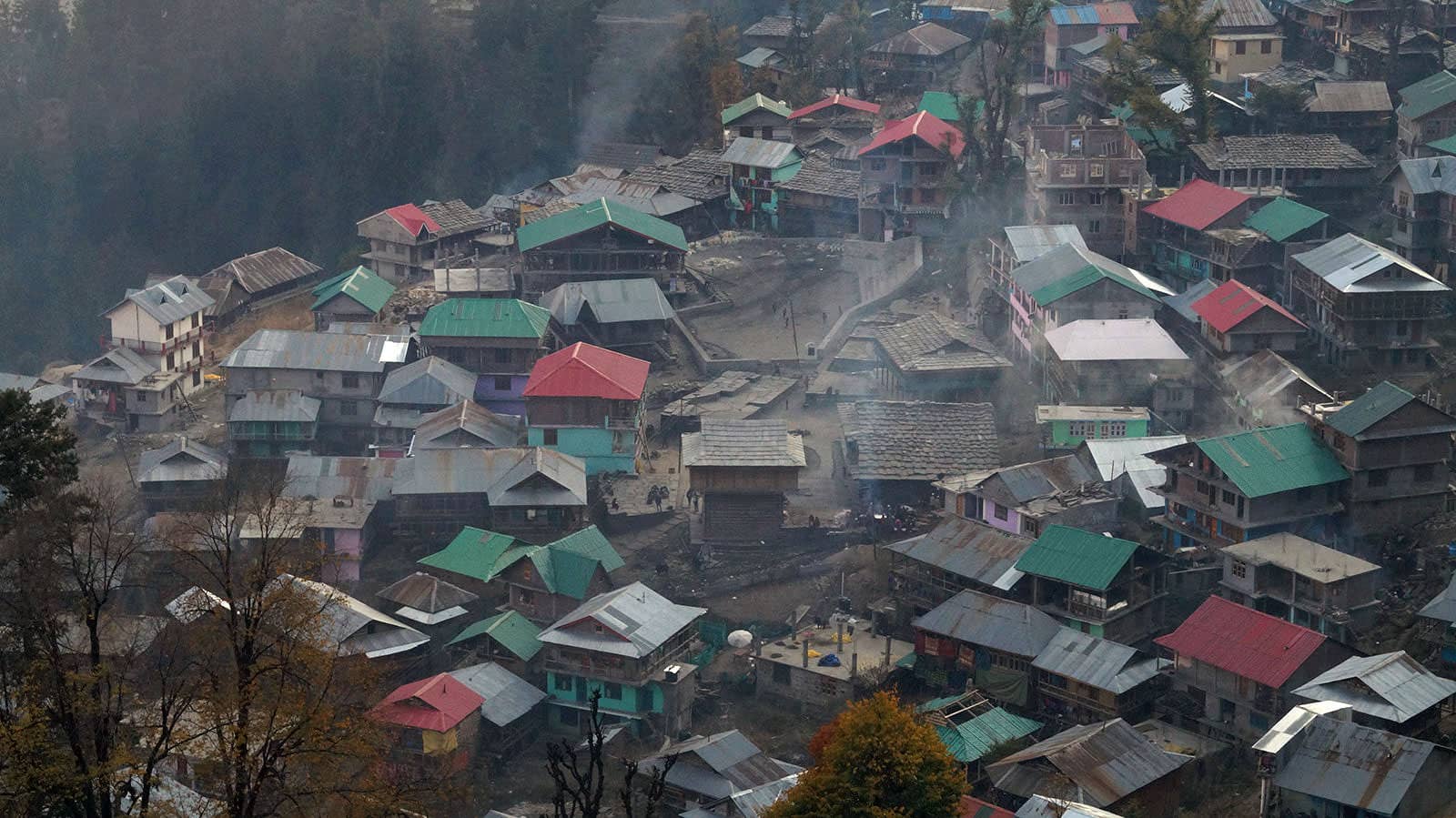
Temple complex of Malana and the newly built amphitheatre opposite to the open ground (May, 2015)
Myths and Realities
Successors of Alexander The Great and Relationship with the Greeks
Due to the visual features of the inhabitants of Malana being similar to the people from Europe, some travelers spread the rumors of inhabitants of Malana being the successors of Alexander the Great. They supported it by mentioning that Alexander had fought King Porus in the Battle of Hydaspes (known as Jhelum river) in 326 BC and a few of his soldiers settled down in the Himalayan valleys and later founded Malana.
Today, the population of Malana has mixed features (such as those of Indo-Aryans and Mongolian) showing that there has been a lot of outside influence in the demography of the village. The people of Malana speak a language which has Sino-Tibetan lineage and is called 'Kanashi'. This language is believed to be the dialect spoken by the 'Rakshasas' which could possibly be an ancient nomadic tribe residing in these parts of the mountains.
The villagers are aware of this myth about Alexander whom they refer to as 'Sikandar' and identify themselves as higher caste Rajput Hindus. Some elders even mentioned that these were lies that were spread by outsiders and because it helped them gain attention, they did not bother correcting the tourists.
Dissappearance of Tourists in Malana
Ever since, Malana was exploited for its Malana creme as a 'drug' business, it had always been under the control of drug mafias passively. To hide the activities which were soon illegal under the NDPS Act, 1985, rumors were spread about tourists disappearing from Malana. No such thing ever happened according to the locals.
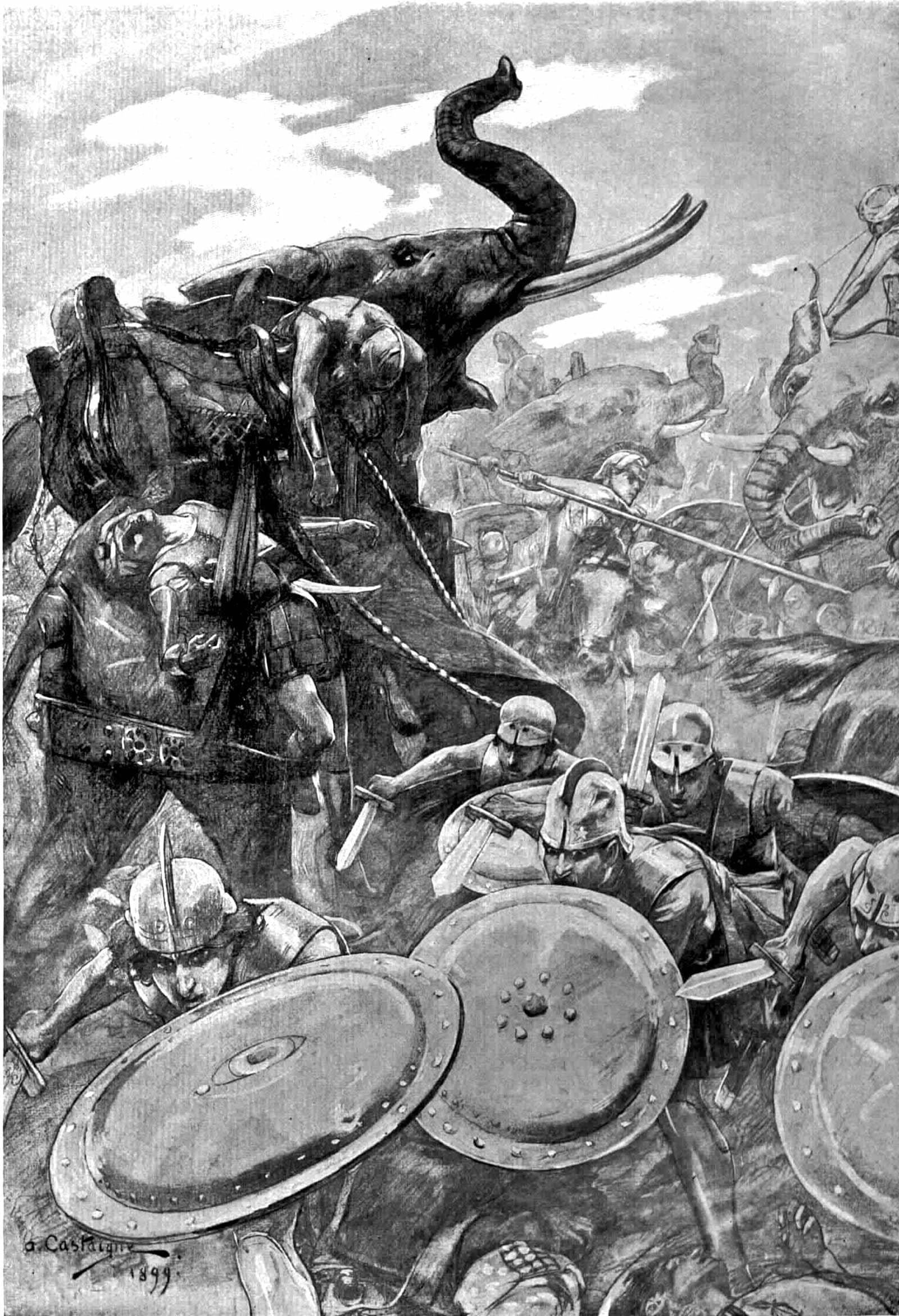
The battle of Hydaspes [Source: https://en.wikipedia.org]
Case studies of nearby Settlements
Case Studies
After visiting Malana, there was a need to understand how exactly this village was different from other villages. So, the following settlements were visited to understand the relationship between altitude, accessibility, electric supply, population and economy:
- Magic Valley: Inaccessible by road, non-electrified, scarcely settlement where people of Malana move in to cultivate cannabis.
- Rumsu: Not commercialized, connected by road and electrified, scarcely populated settlement but worship the same deity as Malana.
- Naggar: Commercialized, well accessible by road, electrified urban settlement accommodating a much larger population with respect to Malana.
- Nashala: Not commercialized, accessible by road, electrified small hamlet near Naggar, situated on a one-way road like Malana but with very less population.
- Rasol: Very inaccessible, situated at a great altitude, moderately populated settlement under the process of commercialization. Also, grows cannabis on a high scale like Malana.
- Katagala: Not connected by road, but easily accessible by foot, scarcely populated agrarian settlement, concentrating more on cash crops and very less on cannabis. Worship different Gods (Pandavas).
- Chalal: Similar to Katagala but with more population.
- Kasol: Very commercialized, accessible by road, electrified, moderately populated urban settlement with tourism in focus.
| Settlement | Altitude | Population | Direct road | Trek | Electricity | Commercialization | Agriculture |
|---|---|---|---|---|---|---|---|
| Magic Valley | Very high | Scarce | No | Moderate | No | Less | Cannabis more |
| Rumsu | Moderate | Scarce | Yes | Easy | Yes | No | Cash crops |
| Naggar | Low | High | Yes | NA | Yes | Yes | Cash crops |
| Nashala | Low | Scarce | Yes | NA | Yes | Less | Cash crops |
| Rasol | Very high | Moderate | No | Difficult | Yes | Less | Cannabis more |
| Katagala | Low | Scarce | No | NA | Yes | Less | Cash crops |
| Chalal | Moderate | Low | No | NA | Yes | Yes | Cash crops |
| Kasol | Moderate | Moderate | Yes | NA | Yes | Yes | Barely anything |
| MALANA | Very high | High | No | Moderate | Yes | Yes | Cannabis more |
Case studies of nearby settlements
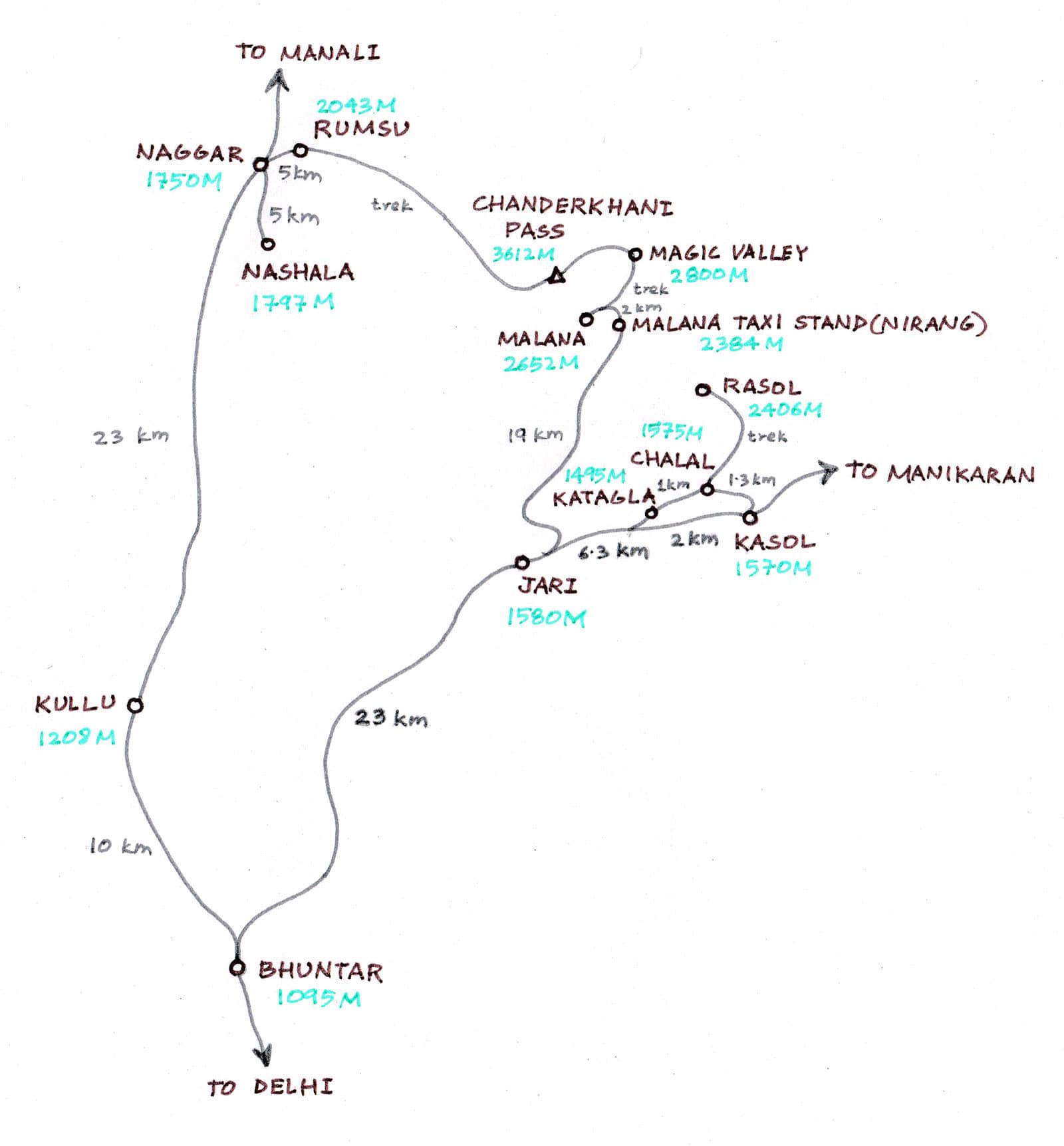
Settlements studied during field visits in Himachal Pradesh in May, 2015; May,2016 & November, 2016
Conclusions
Malana's Uniqueness
Villages in Himachal Pradesh revere different gods and goddesses. They may speak different local dialects and may have different administrative systems in place. At first, Malana may appear very unique due to its ancient democratic system, mythological beliefs and cultural differences to anybody living outside the Himalayan valleys. But, all the Himalayan settlements have such differences and hence, most of them are similar in one sense.
We can attribute Malana's uniqueness only because of their recognition by nearby settlements as the followers of Rishi Jamdagni and being placed as higher castes than other communities. According to the local mythological tales, their language-'Kanashi' is believed to be the dialect of the 'Rakshasas' that once lived in these mountains. Because of some rumors and also its genuinely exquisite background, Malana received more attention than other nearby villages. Its altitude (about 8700 ft) and the cultivation techniques used by the villagers allowed for a higher THC (Tetrahydrocannabinol) content making the psychotropic effect of locally grown cannabis stronger.
Cannabis in Malana
Soon, Malana obtained the identity of a "Hippie heaven" and Malana creme also received the "Best Hashish" title twice in 1994 and 1996 at "High Times" magazine’s "Cannabis Cup" in Amsterdam. The villagers soon shifted to cultivating cannabis and stopped the cultivation of other crops to a large extent. Today the populace of Malana is totally dependent on cannabis as a greater source of income and relies on the import of goods and food items from nearby settlements as the inhabitants don't produce enough consumable items. This has been possible unlike in other villages because of the gradual but remarkable increase in the purchasing power of the people of Malana due to the cannabis sale.
Malana's Future
Regardless of cannabis and its existence, Malana is in a conundrum today. The 'wise' elders who tried to preserve the culture of Malana are no longer heard. The present adult population is confused between living with older traditions and adapting to modern day technologies while the younger ones are totally clueless about their future. These young children have taken cannabis business as a source of income and many have stopped studying in schools. This places their future at stake. Even the villagers admit that cannabis has also brought negative influences in the village and its people, making them greedy and insensitive to their culture.
Malana's future relies upon the decisions that other entities take, one being the government because this village has proved over time to be very helpless in its defense. If cannabis is legalized, Malana's economy will drop on its face and the youngest will face the hardships. And if the cannabis ban continues but better supervision by the police is rendered, the economy may still suffer and looking at the current trends, the Malanis might not be ready to face the consequences.
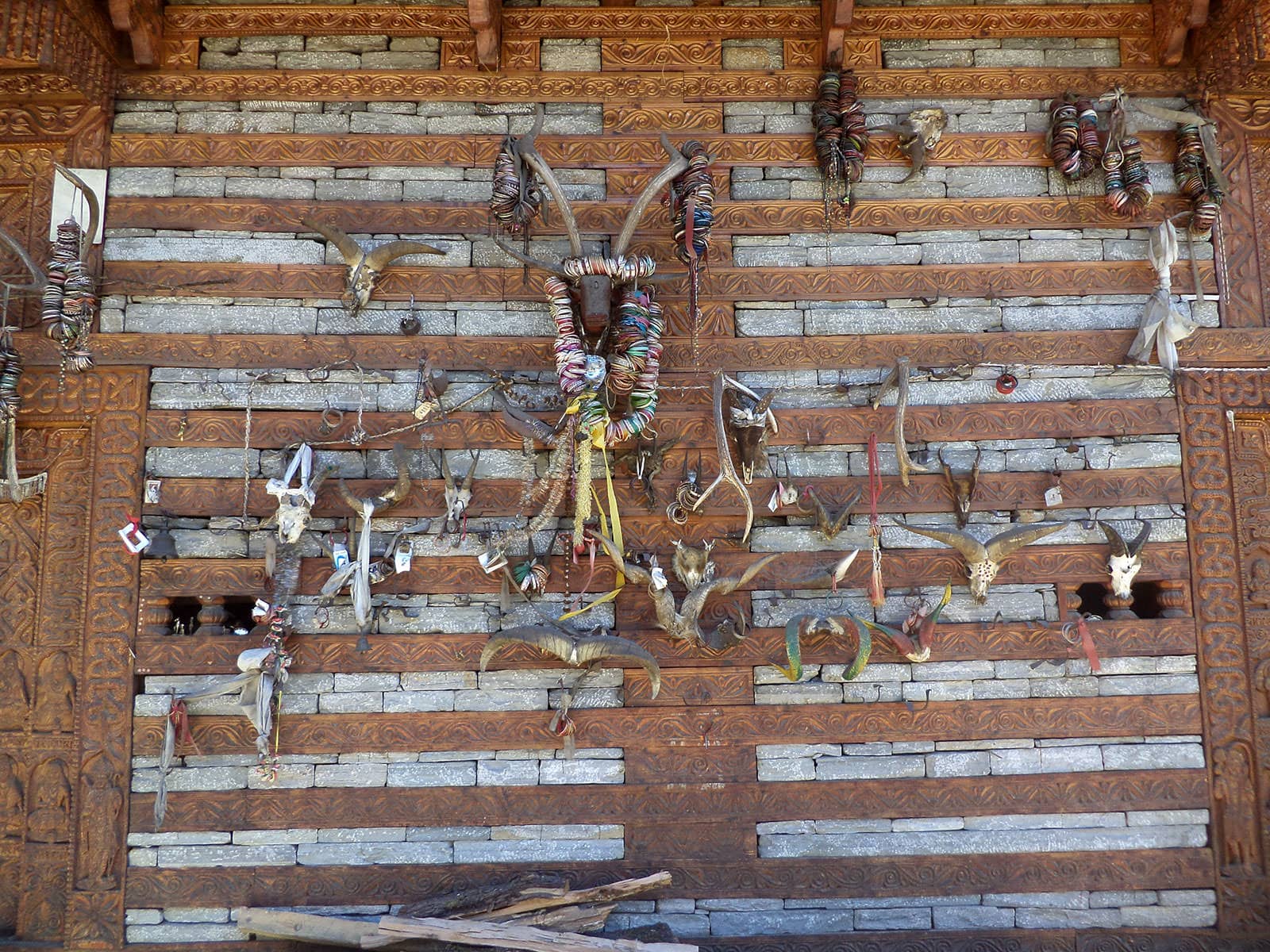
Remains of animal sacrifices hung over the walls of the twin-temple of Rishi Jamdagni (May, 2015)
Appendixes
Annexure 1
Census Report of Malana by the "Census of India, 2011"
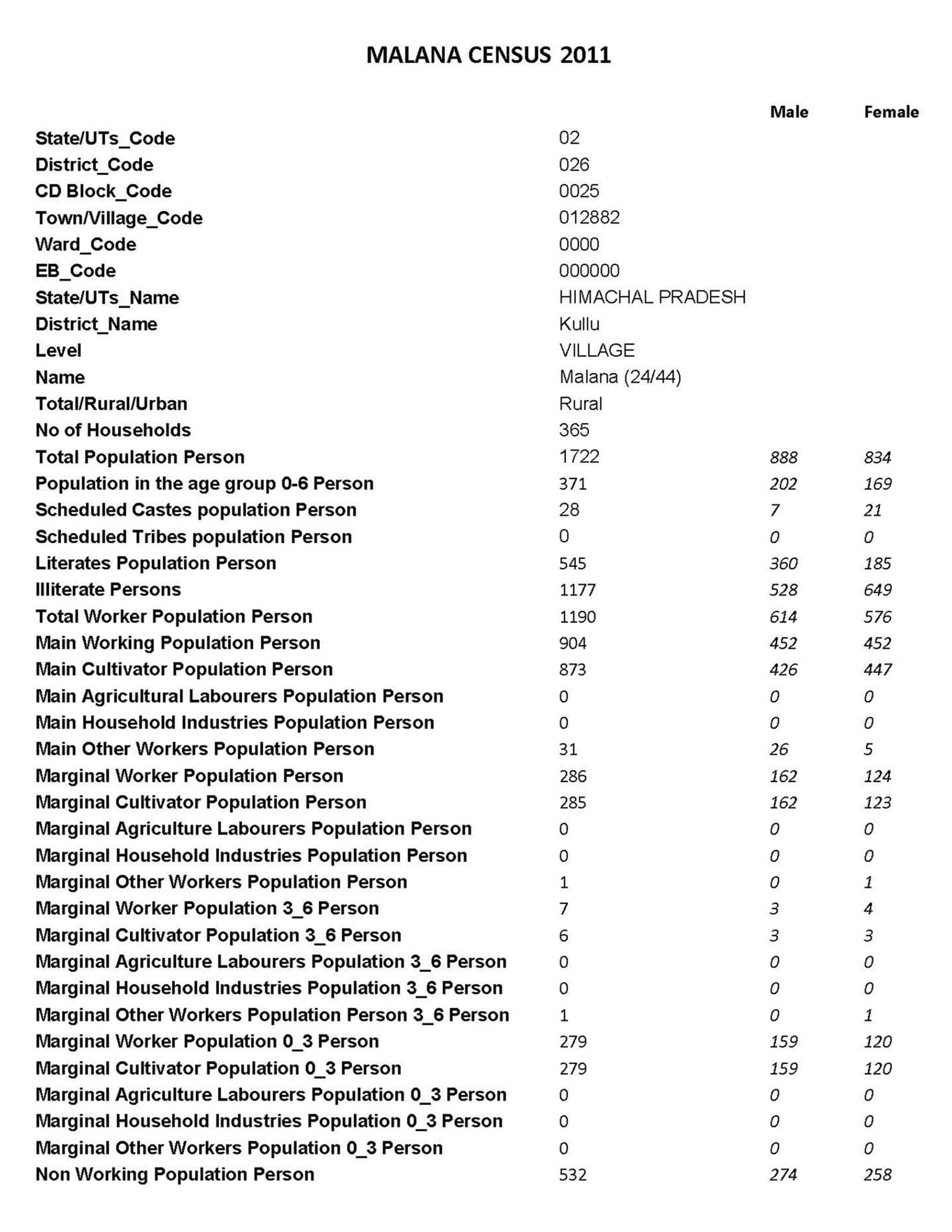
[Source: http://www.censusindia.gov.in]
Annexure 2
Sample Survey Questionnaire for Locals
Village life-
- What is your name and age?
- Are there any electrical problems? What?
- What are your sources of entertainment or leisure?
- What more amenities do you expect in the village?
- What do you think of a girl child and a boy child?
- At what age did/ will you get married? How many kids have you had?
- Do you work in winter months? What work?
- Do you want to educate your kids? Why?
- Do you think the government is willing to help you? If not, why?
- Are you aware of the history of this village? Alexander tale?
- Do you like Old Malana or the new one?
- What are your aims and aspirations in life?
- Do you or your family plan to shift out of Malana ever? Why?
Cannabis cultivation-
- What is your name and age?
- Do you grow cannabis? If yes, who else in your family does?
- How much cannabis do you sell everyday/ week?
- Do you earn more money because now you sell cannabis?
- Is there any other source of income? What would you resort to if cannabis wasn't there?
- Are you aware that cultivation of cannabis is illegal?
Garbage disposal-
- What is your name and age?
- Where do you throw your garbage?
- Do you think this garbage can spread diseases if not cleaned soon?
- Are you aware that plastic is non-biodegradable?
- How often do you fall sick? Do you think it is because the village is dirty?
- Would you like if the village be cleaned and stay that way?
- Would you like to volunteer to clean and maintain the village?
Wool and hemp as business alternatives-
- What is your name and age?
- What is your annual income?
- Is business here profitable or stagnant?
- How often do you travel outside Malana and why?
- Do you get everything in the village that you need?
- Do you own sheep? How many? For what?
- Where do you make woolen or hemp products and where do you sell them?
- Do you think that visitors would be willing to buy hemp/ woolen products if they knew they have supply here? Will that be financially beneficial to you?
Housing-
- What is your name and age?
- How many people live in your house? What is your relation to them?
- Can you all live comfortably in your house? Can anything get better?
- Are you planning on building another house? If so, when? Why?
- Does cost of construction bother you?
- Do you think cutting of trees should be banned? Should you be allowed to use wood to build your houses?
- Do you like new concrete houses or the old wooden ones?
Annexure 3
Sample Survey Questionnaire for Tourists
Travel expectations-
- What is your name and age?
- Where are you from?
- What brought you here?
- From what source did you learn about Malana creme?
- For how many days do you plan to stay here?
- What did you expect of this village?
- Would you like to learn more about the village (culture, history, etc)?
- Are you interested in exploring the village? What did you see?
- Do you prefer better accommodation and other facilities or is this satisfying?

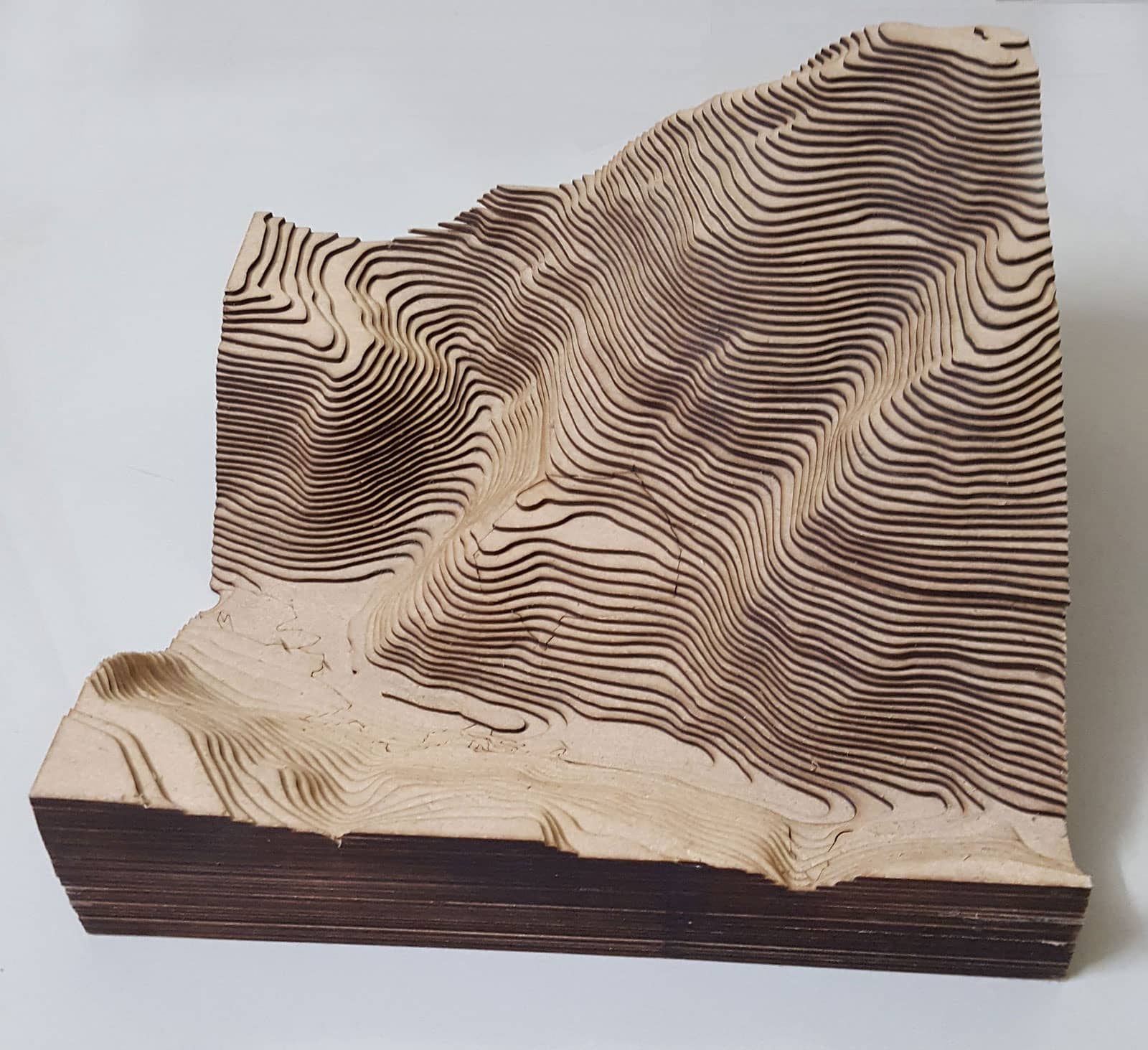
Study model of the topography of Malana
Previous
Next

